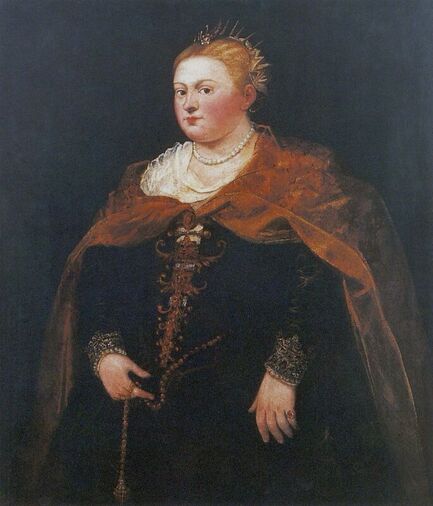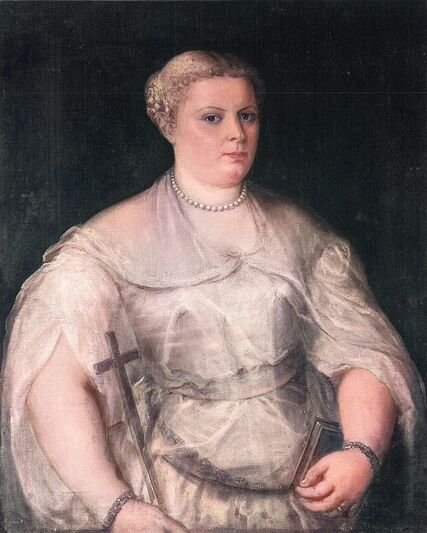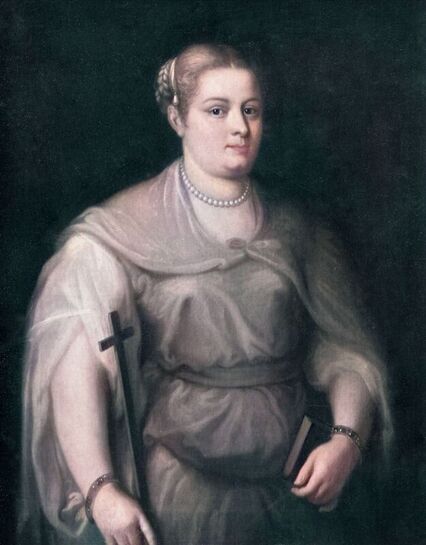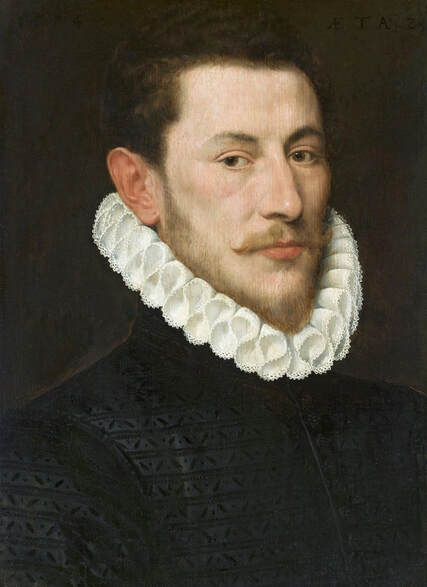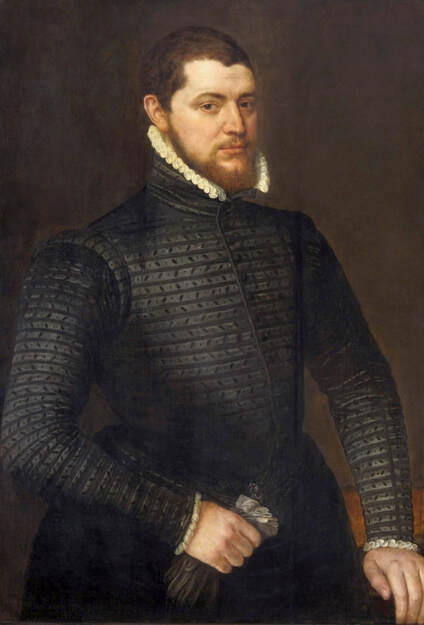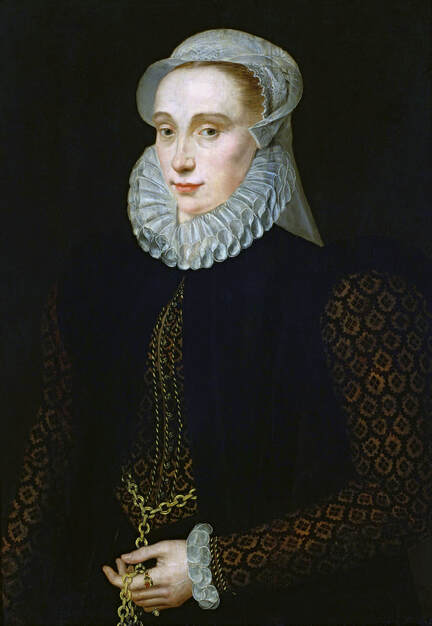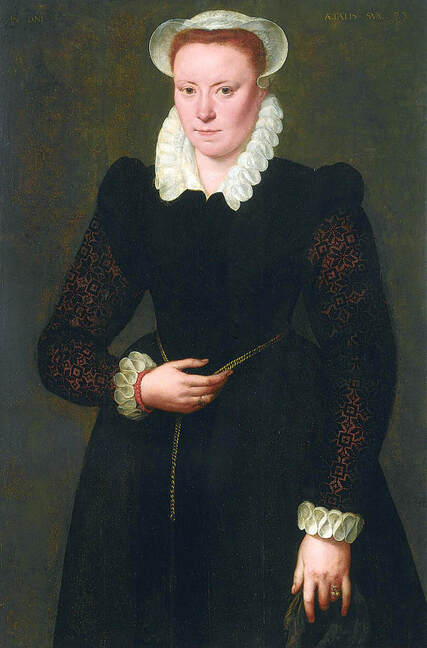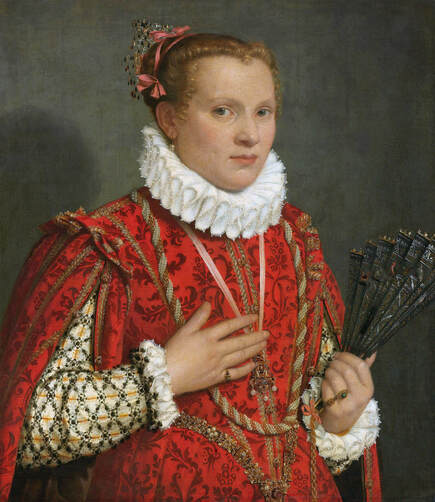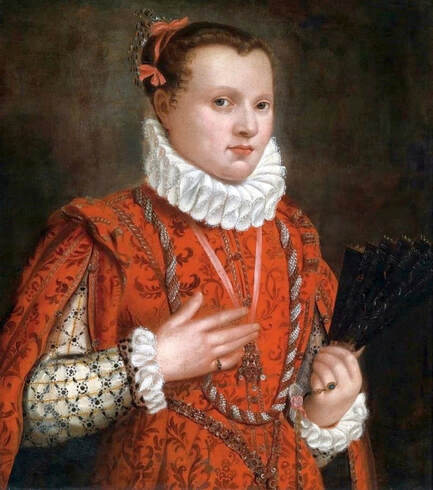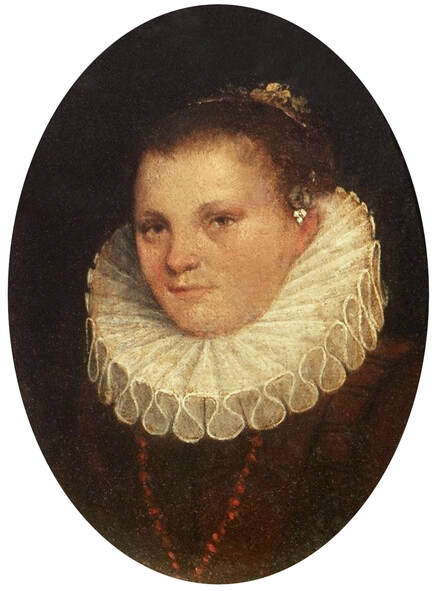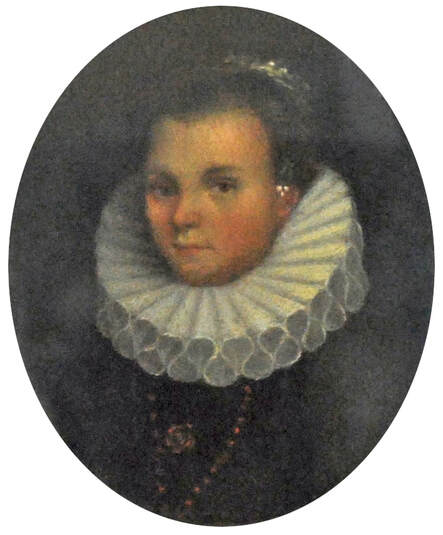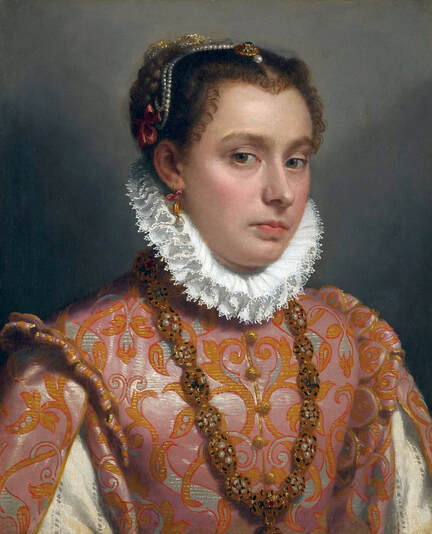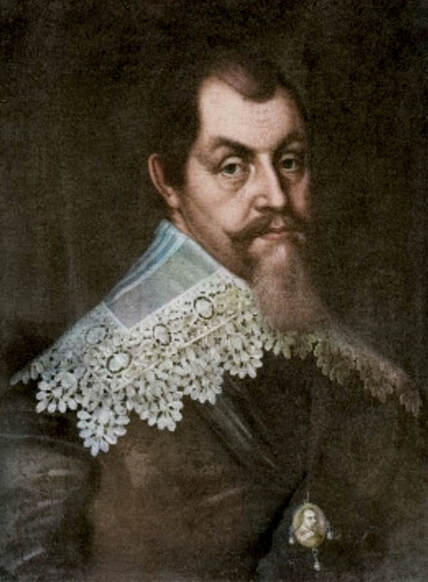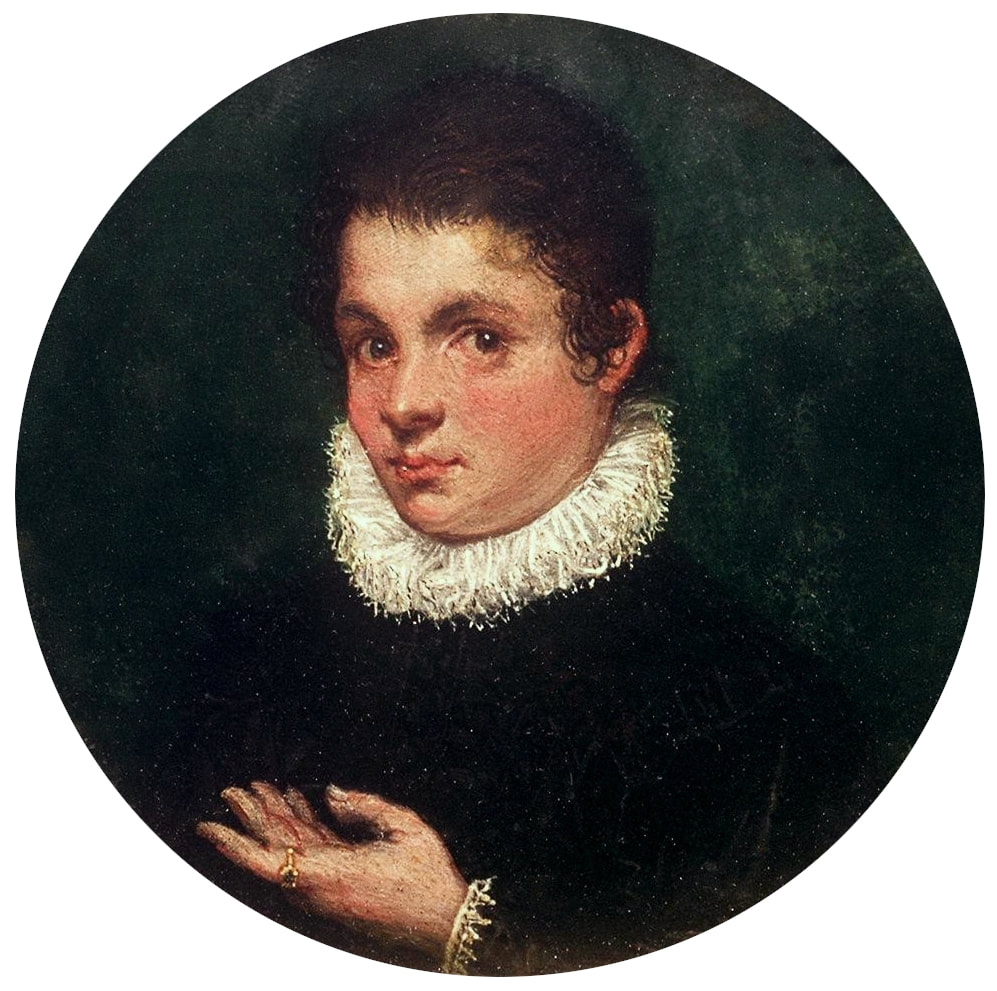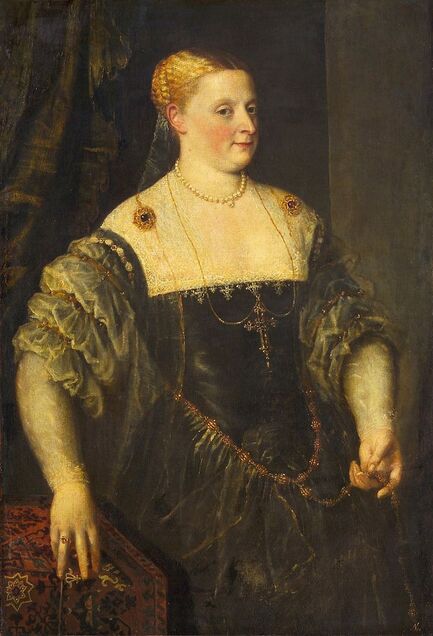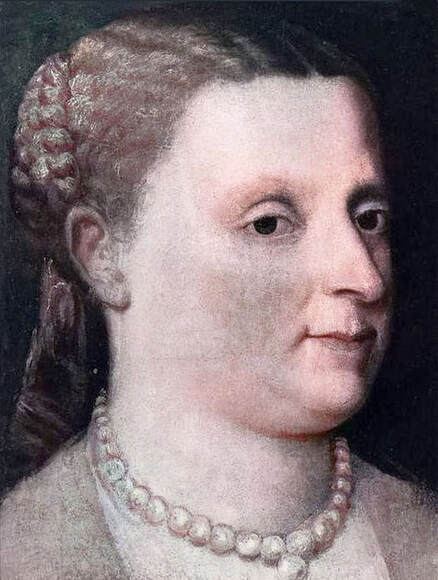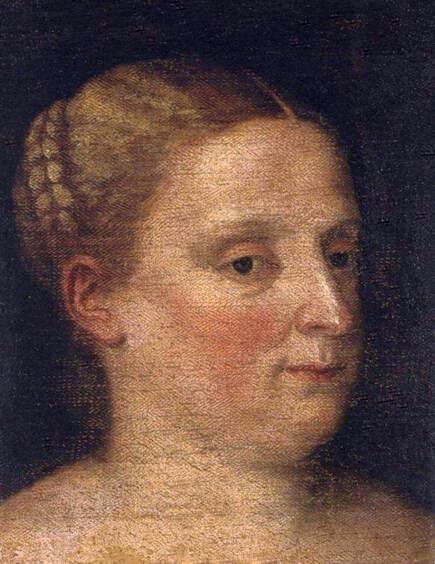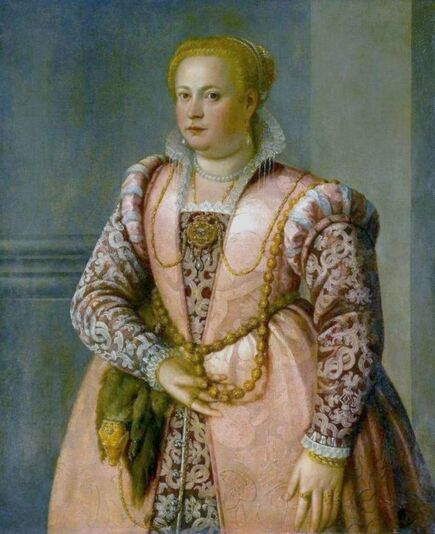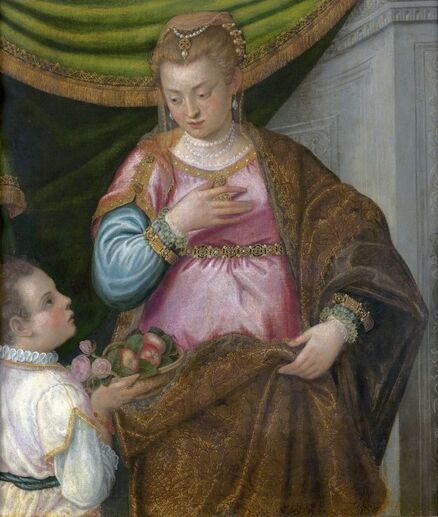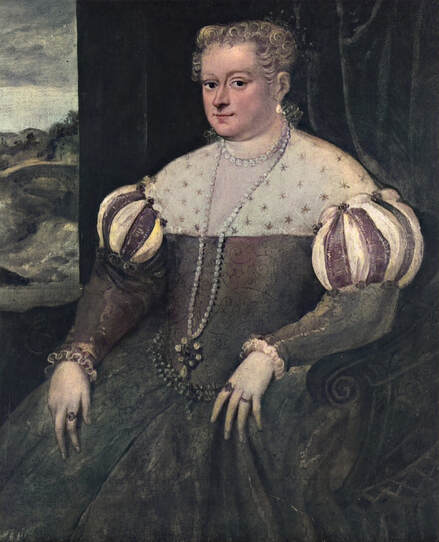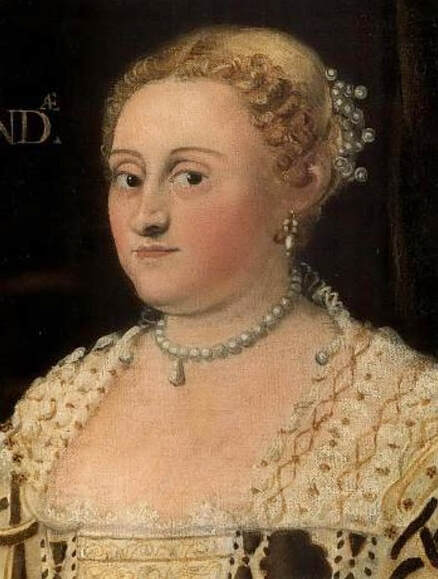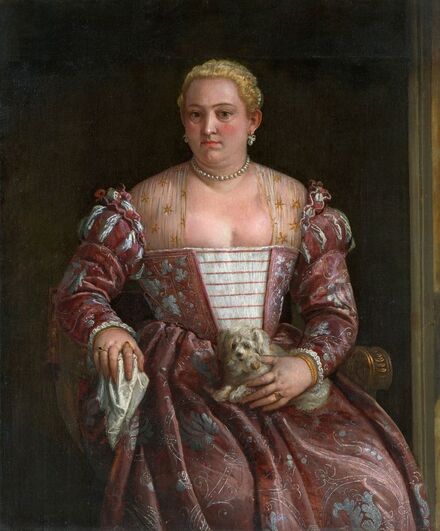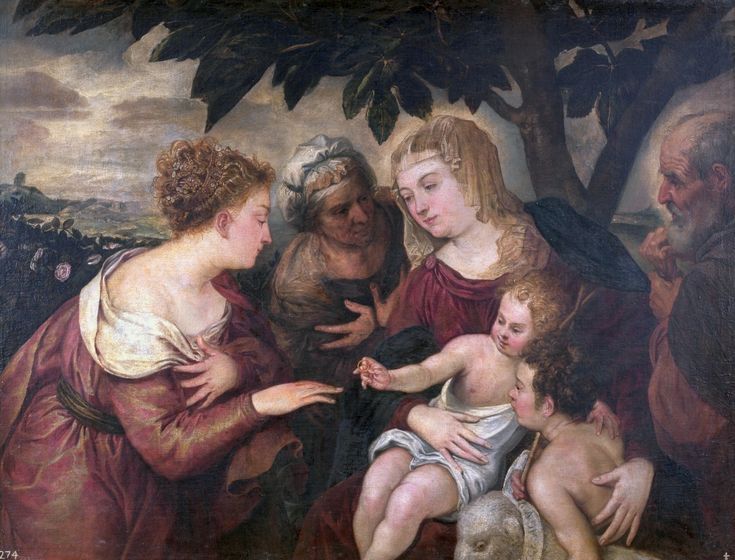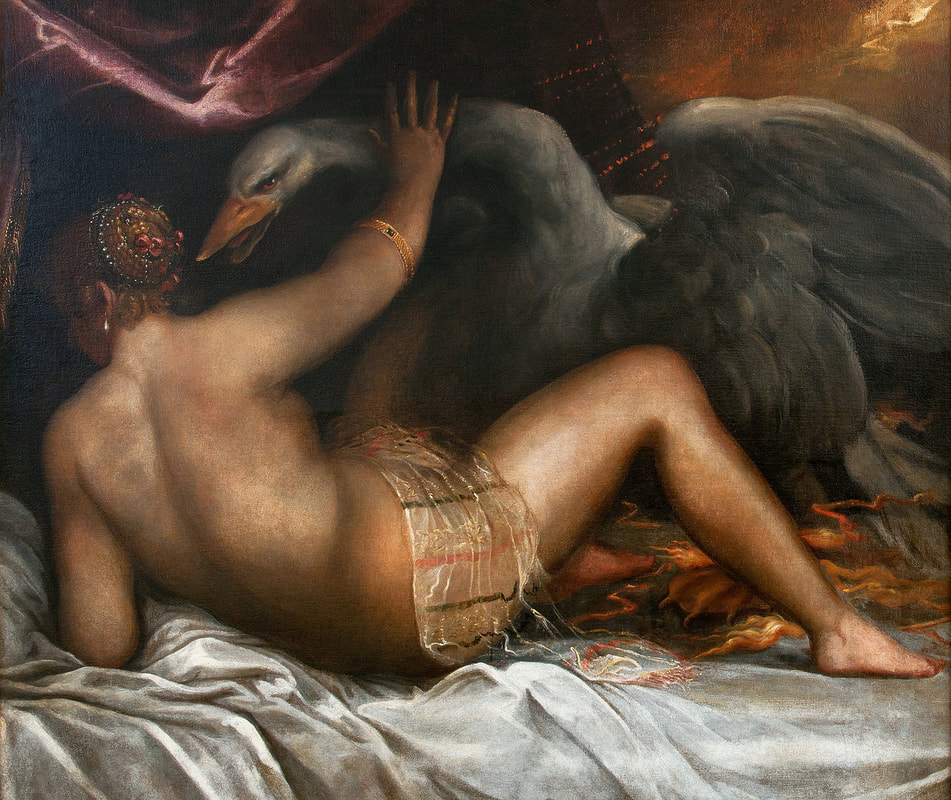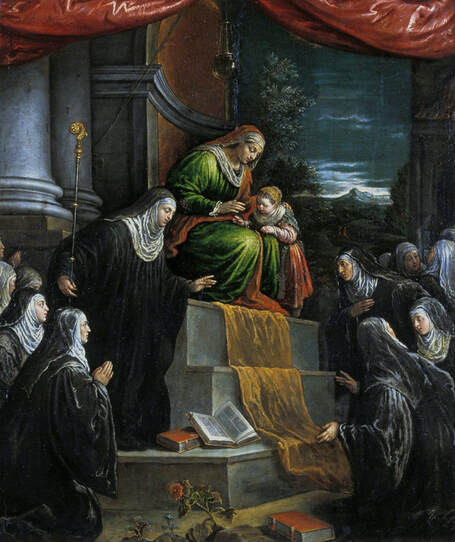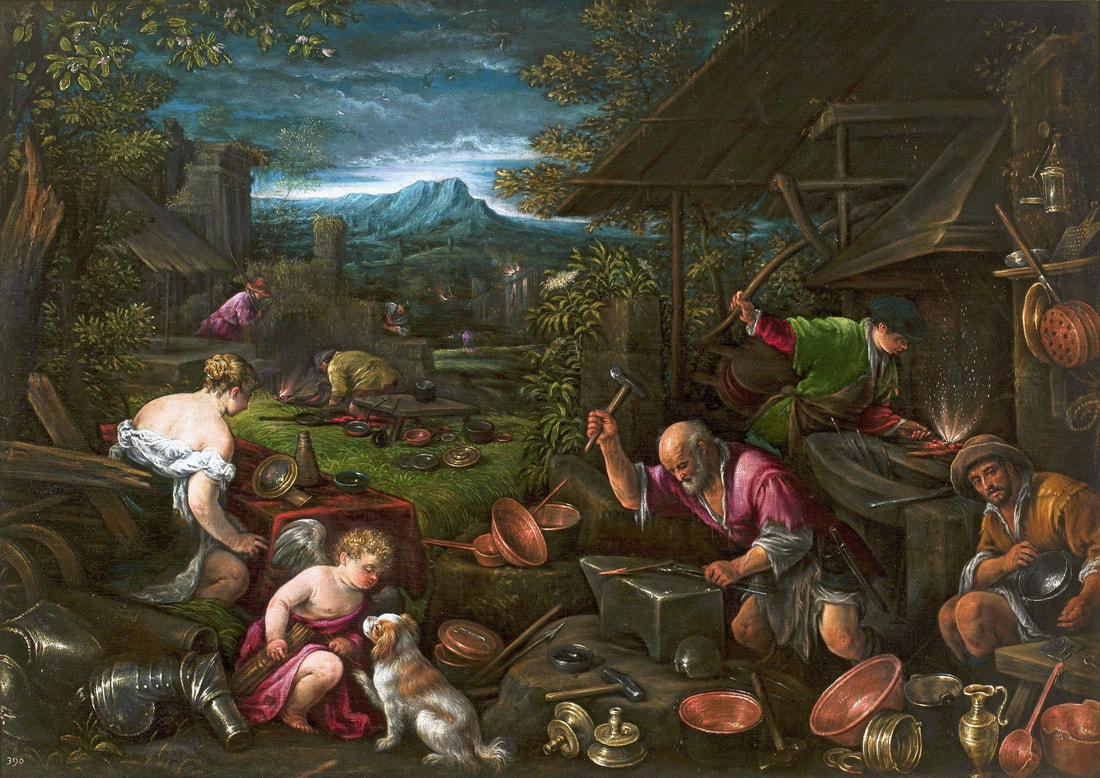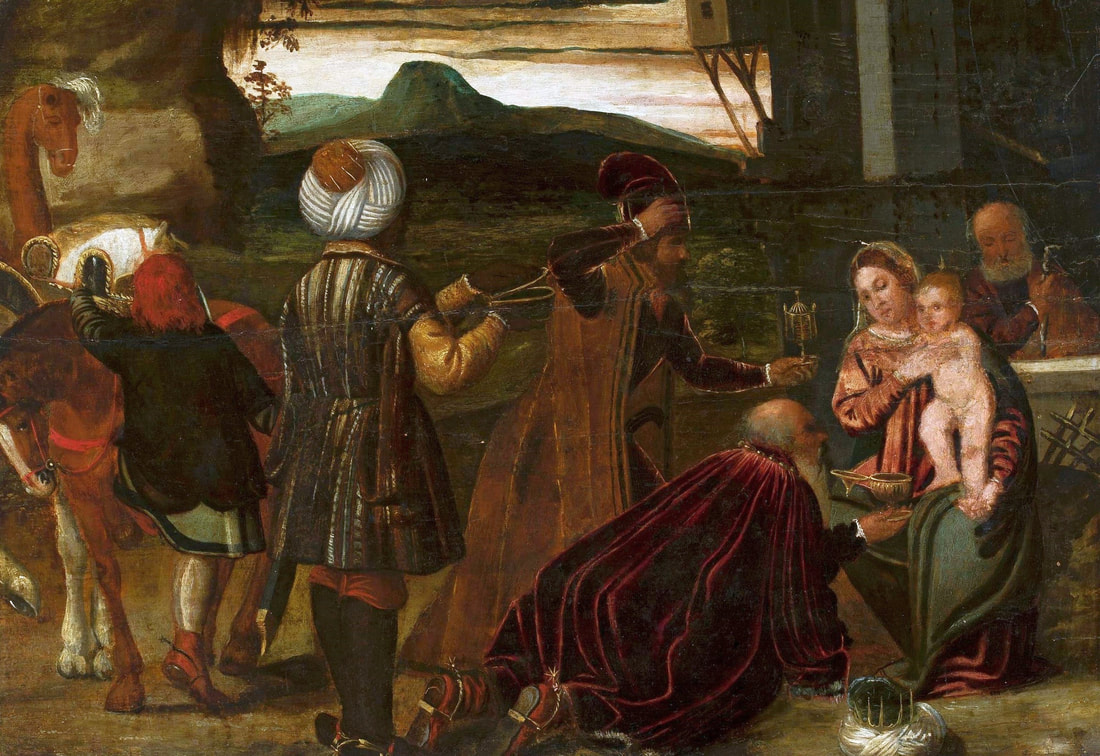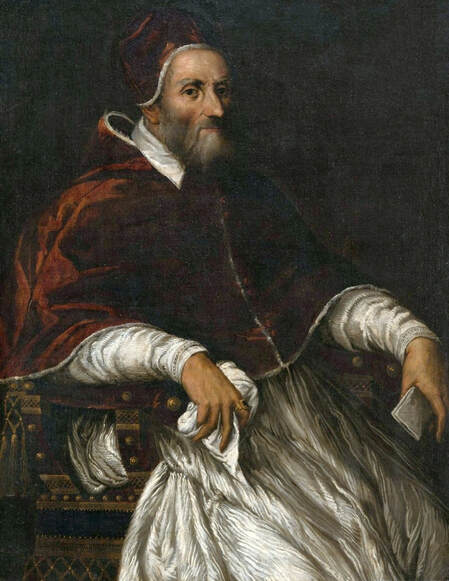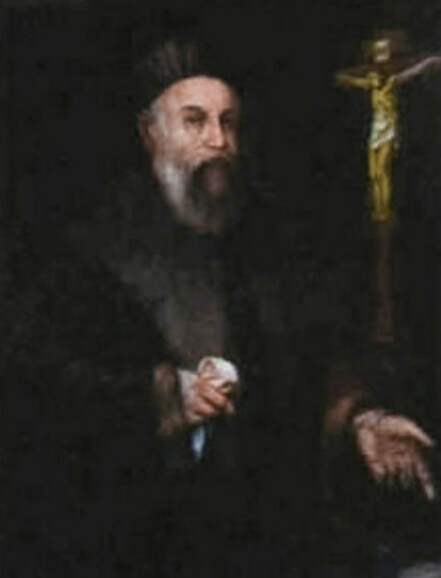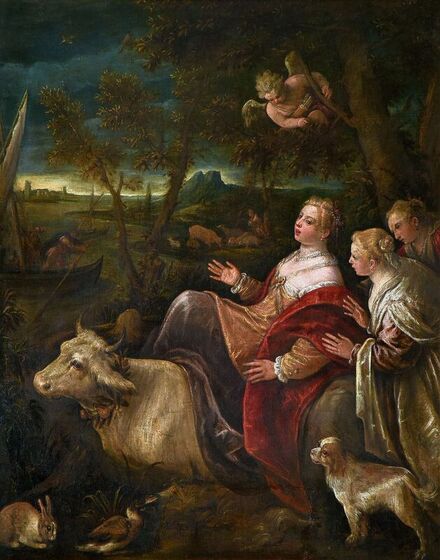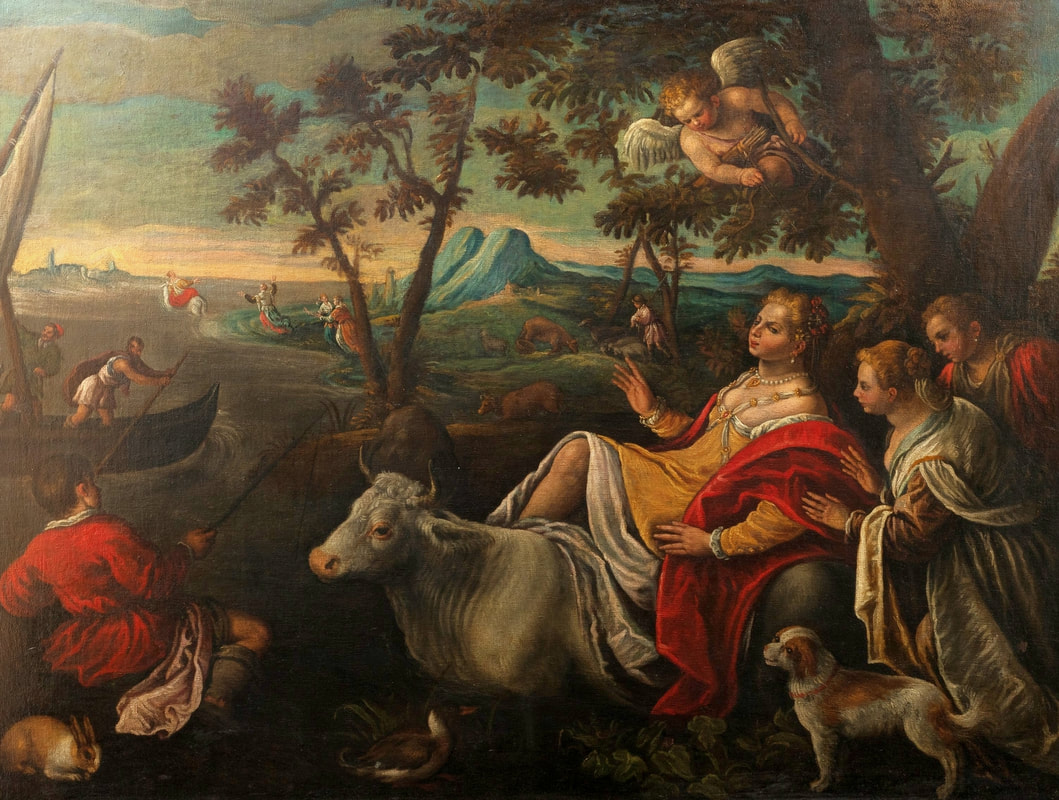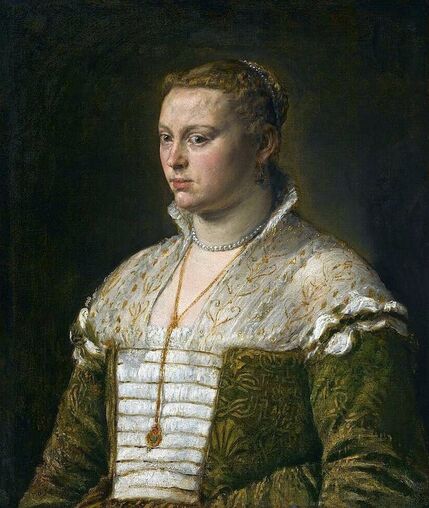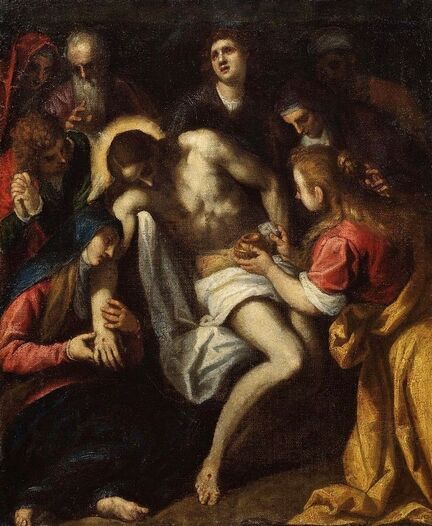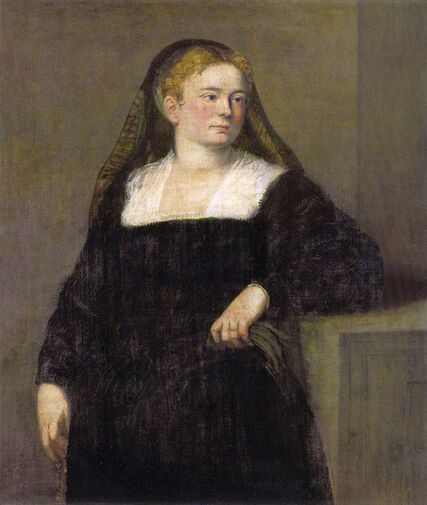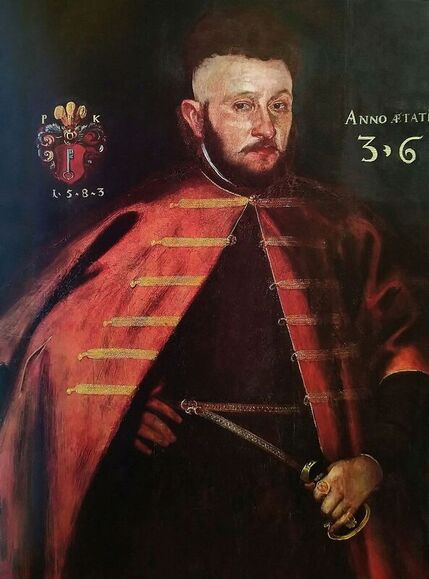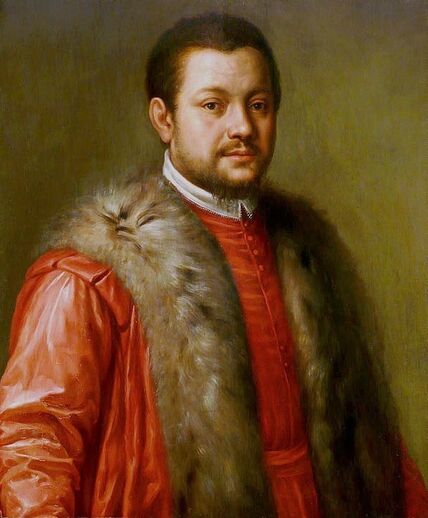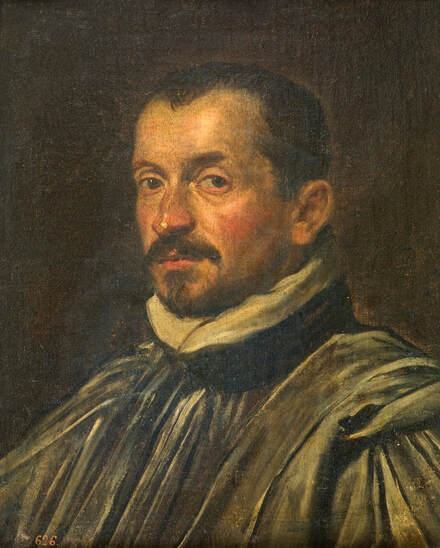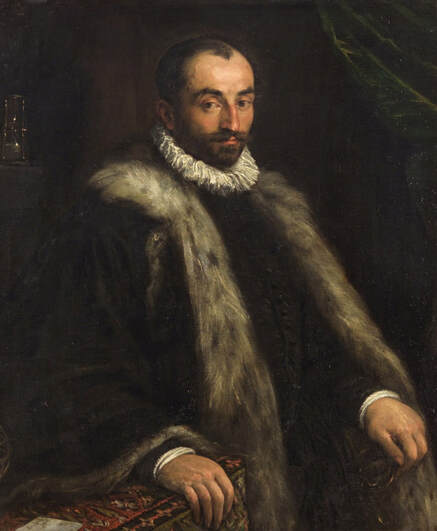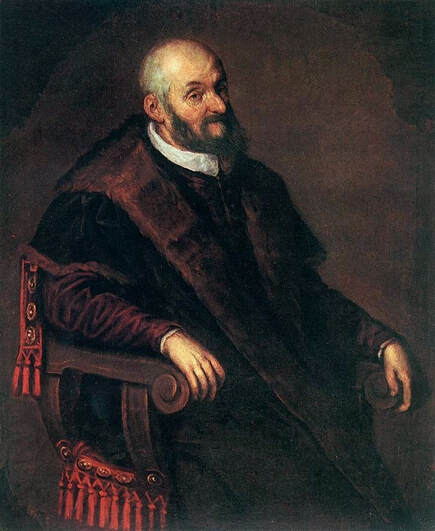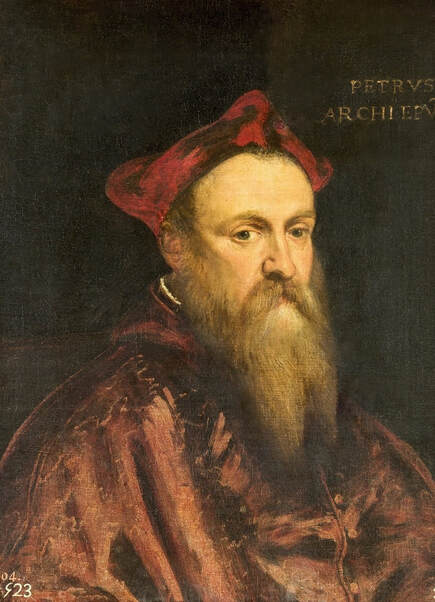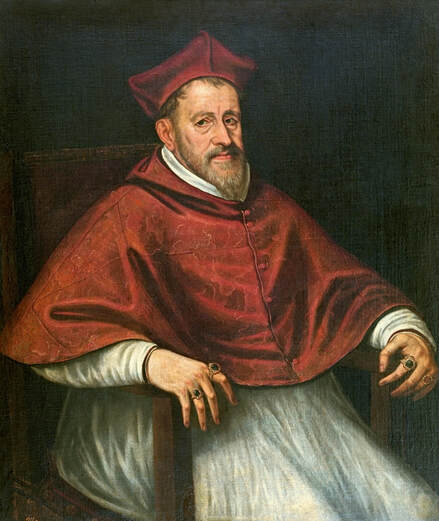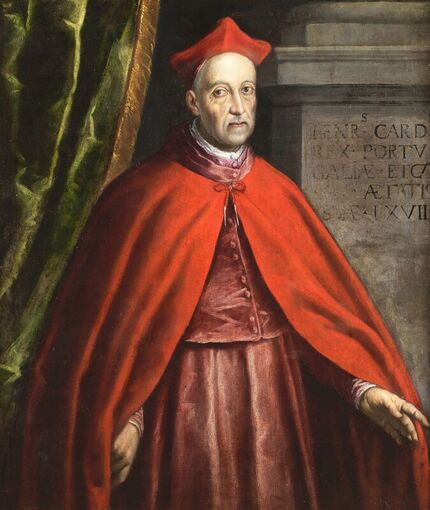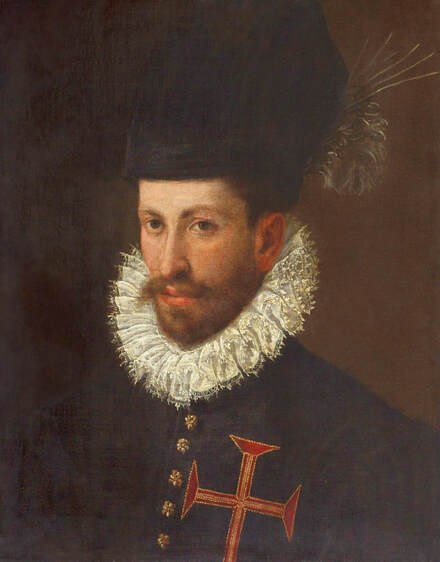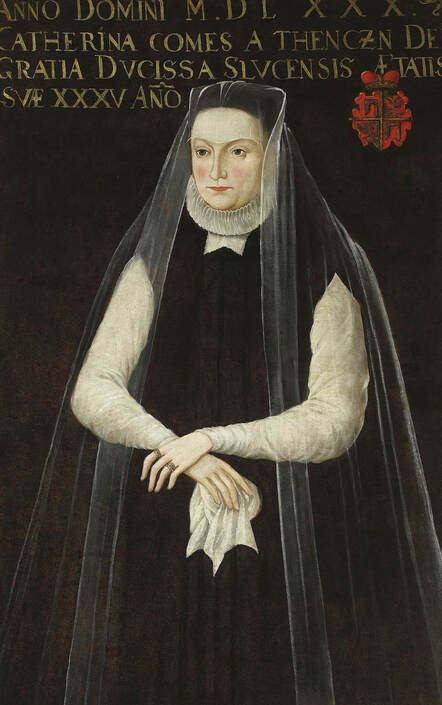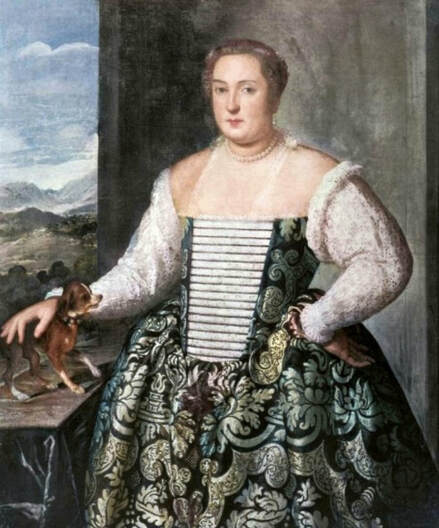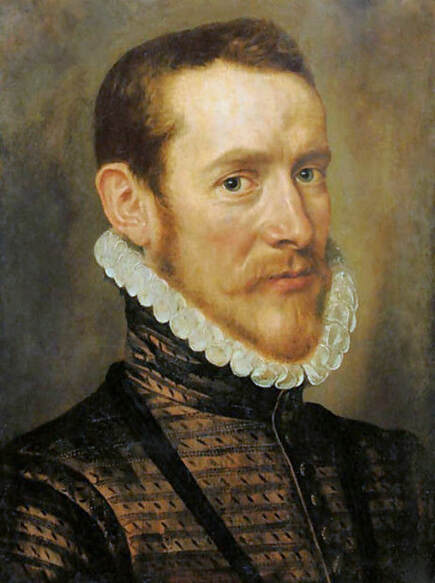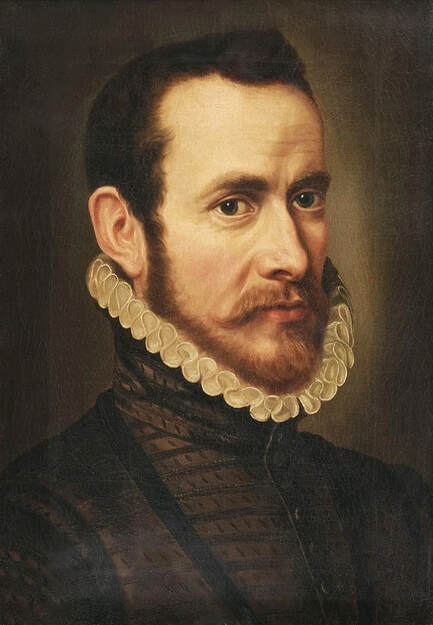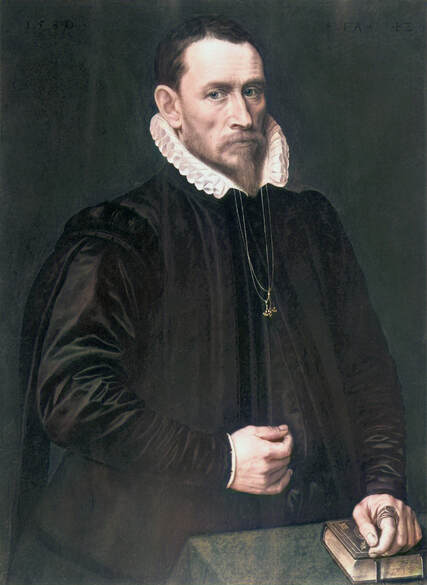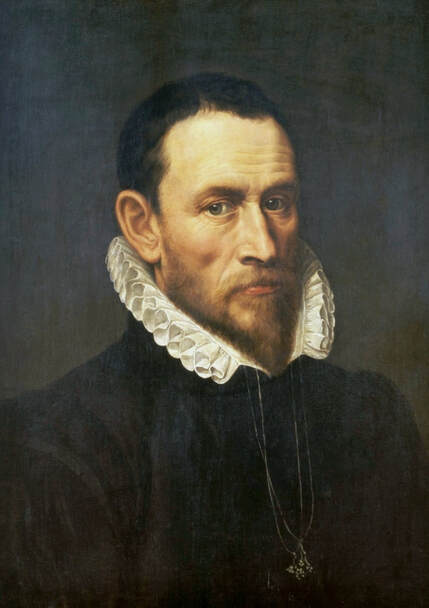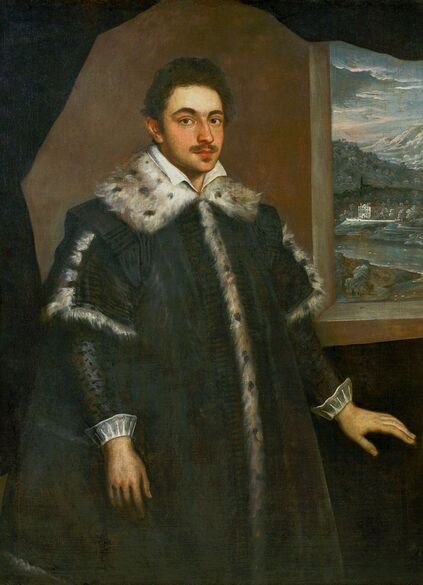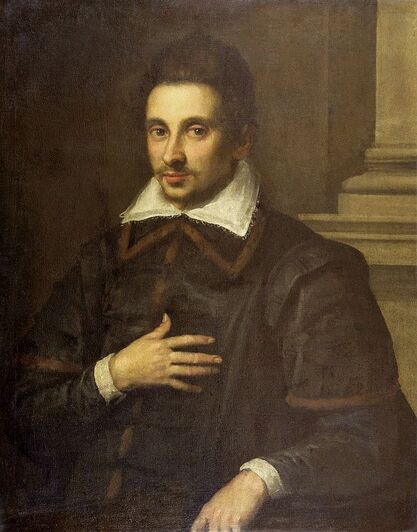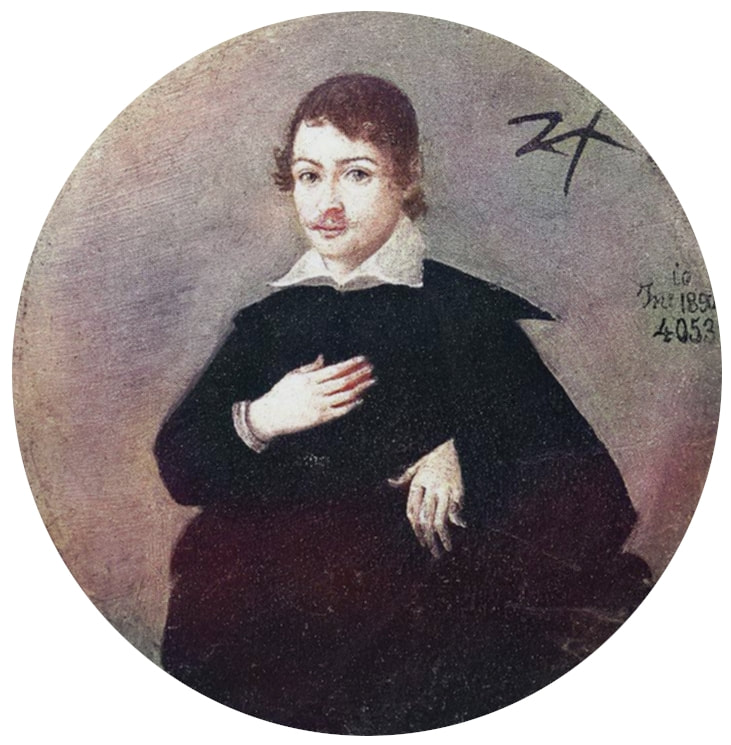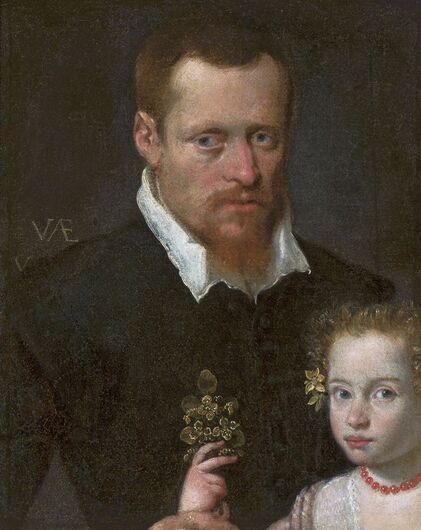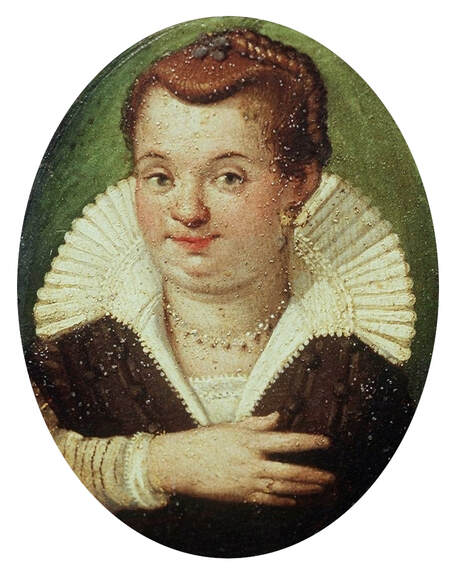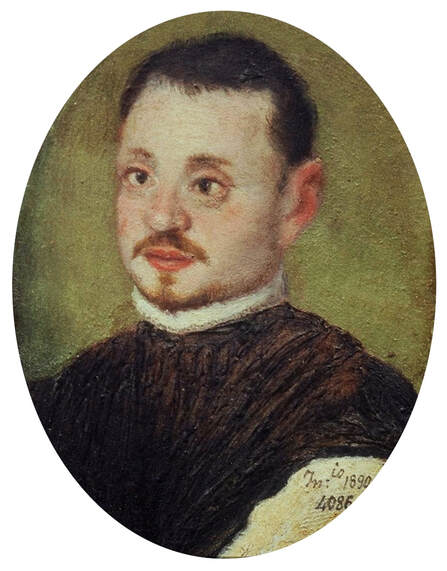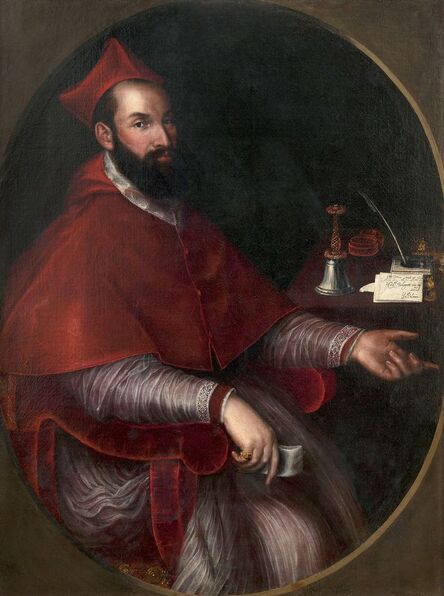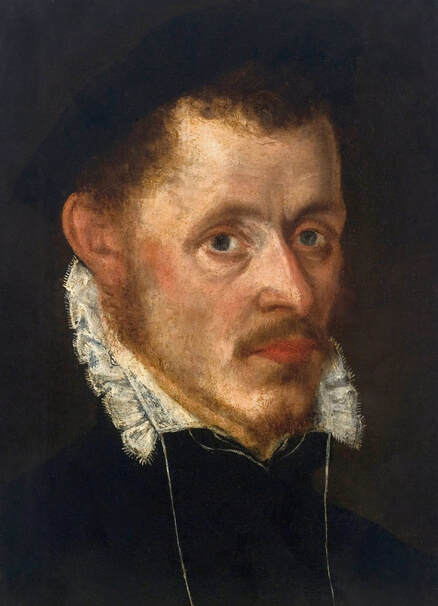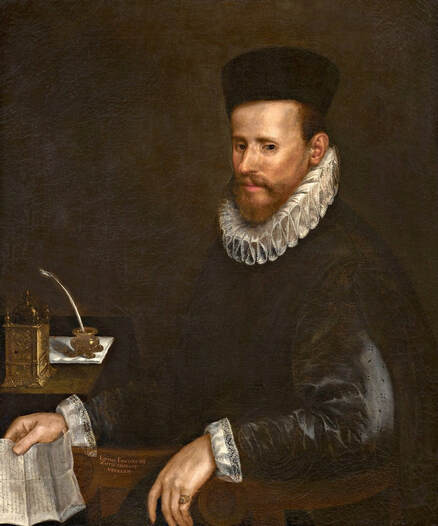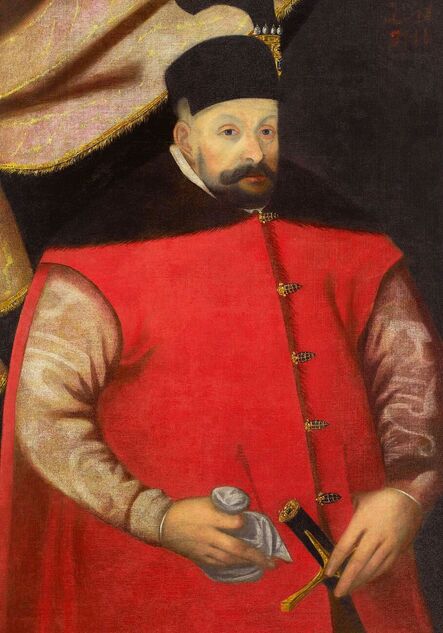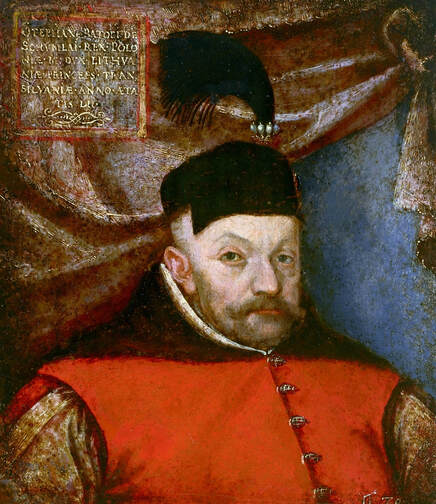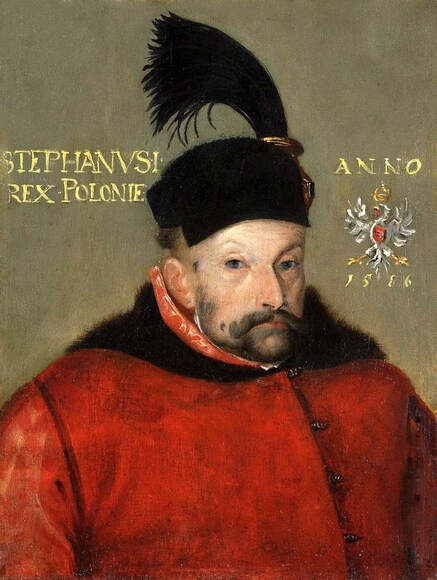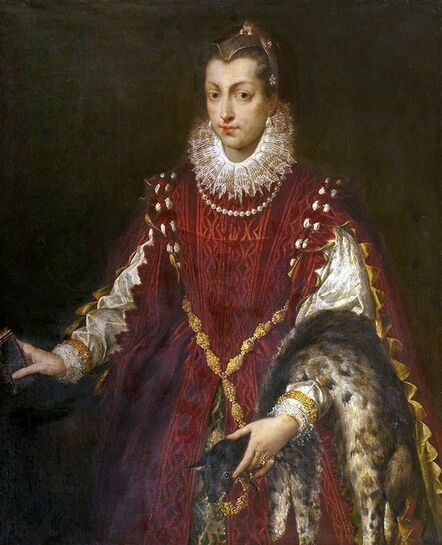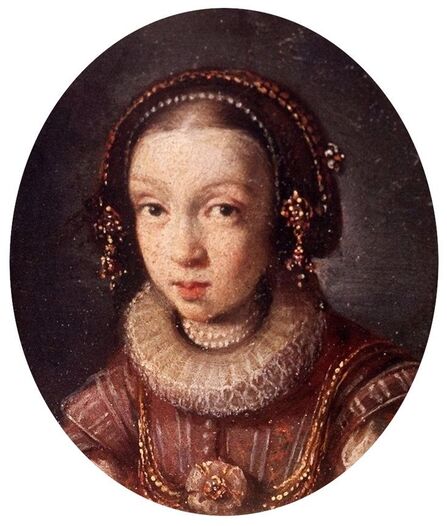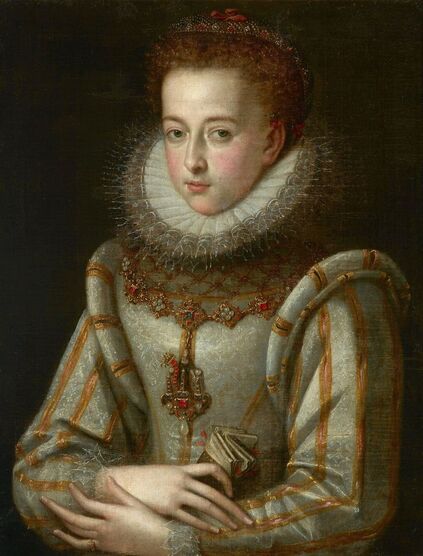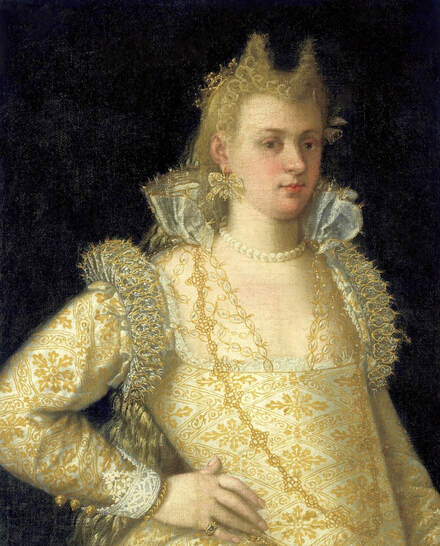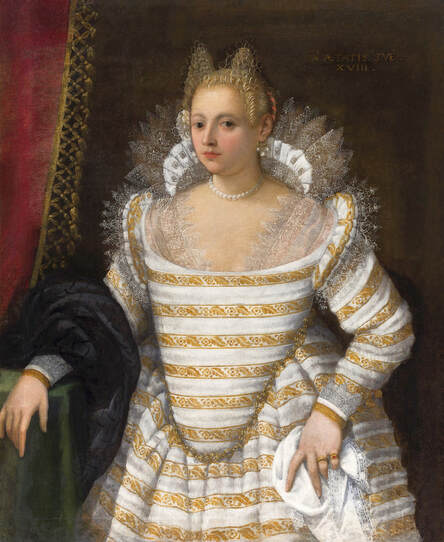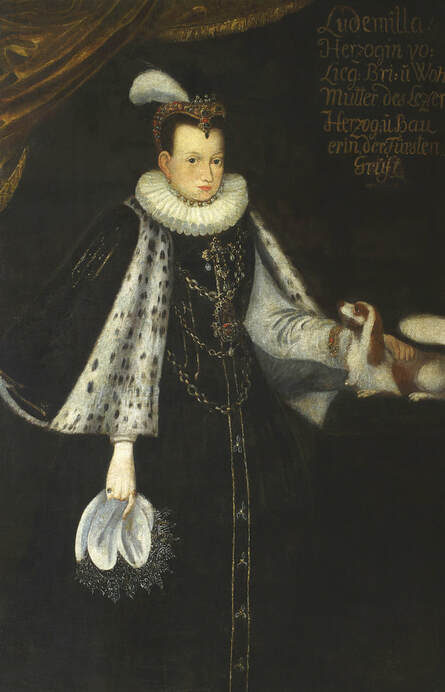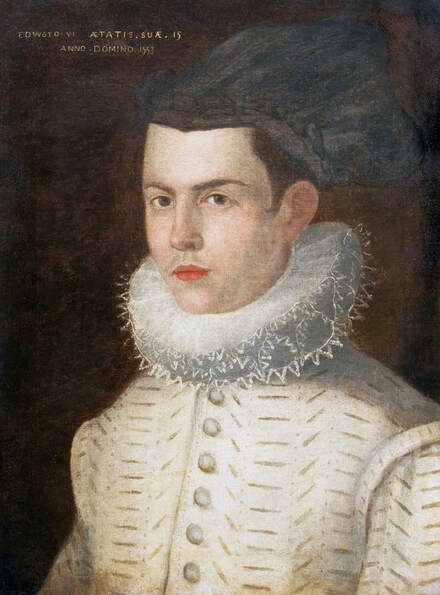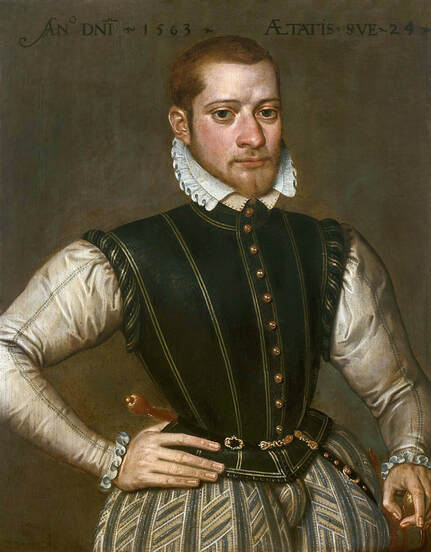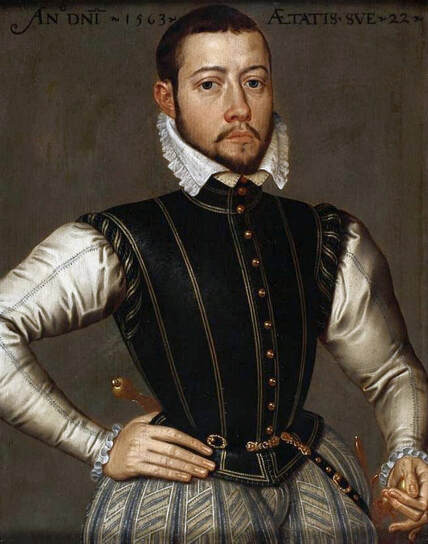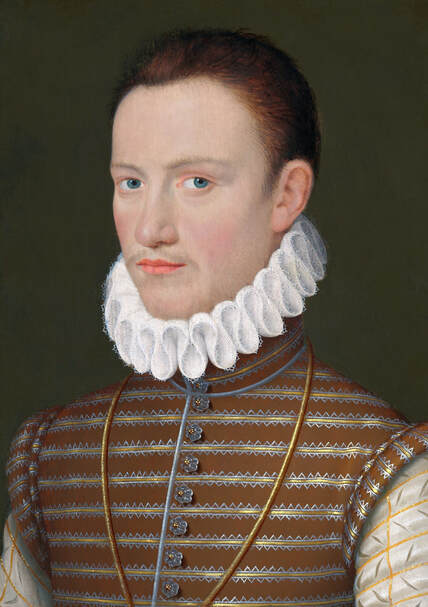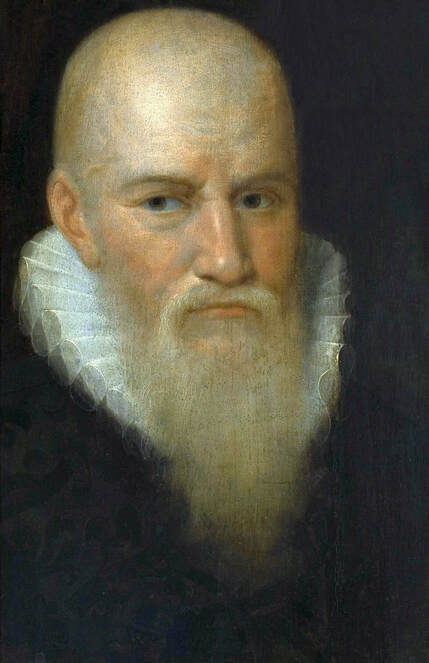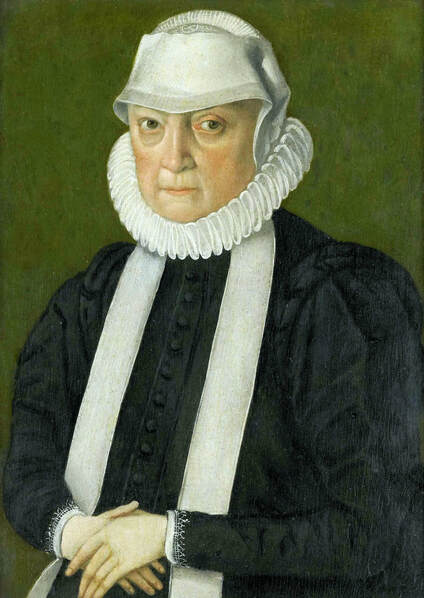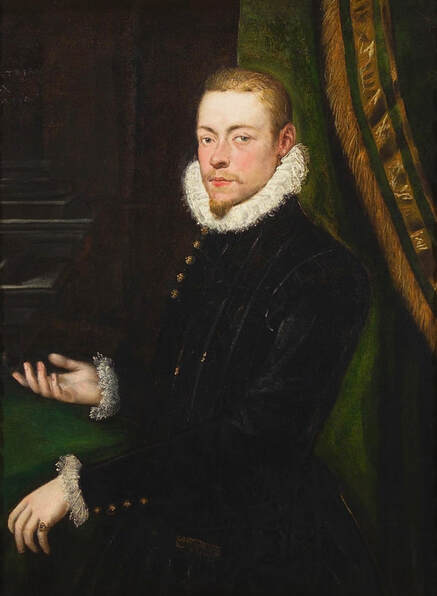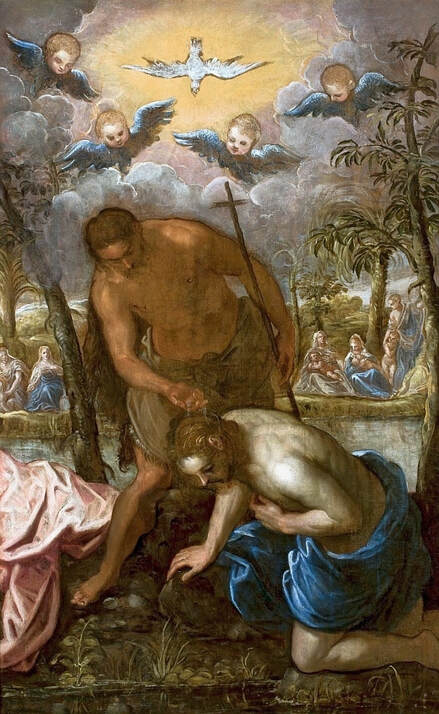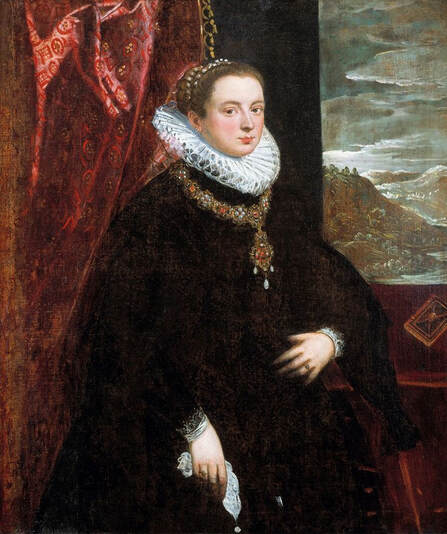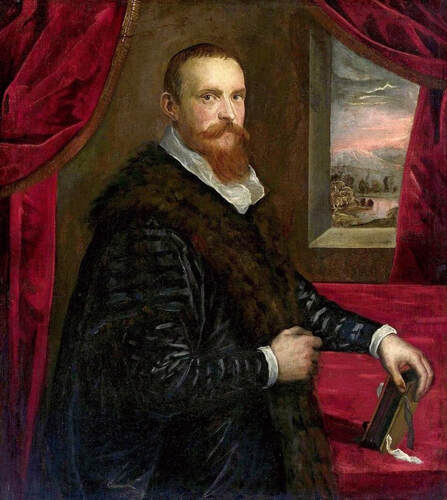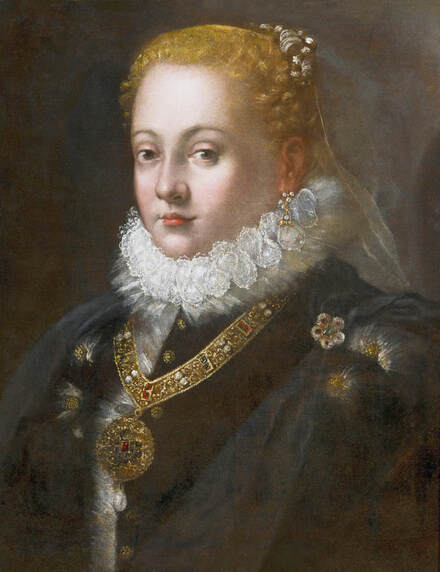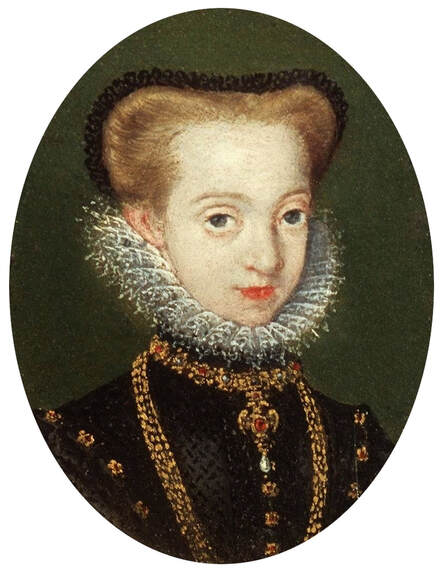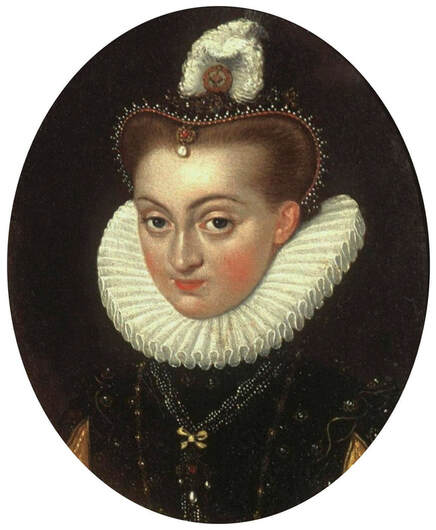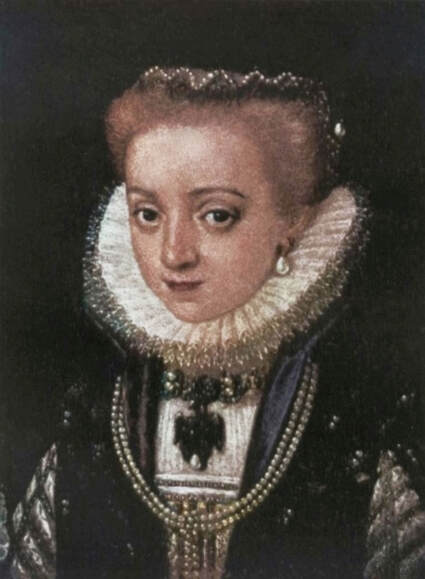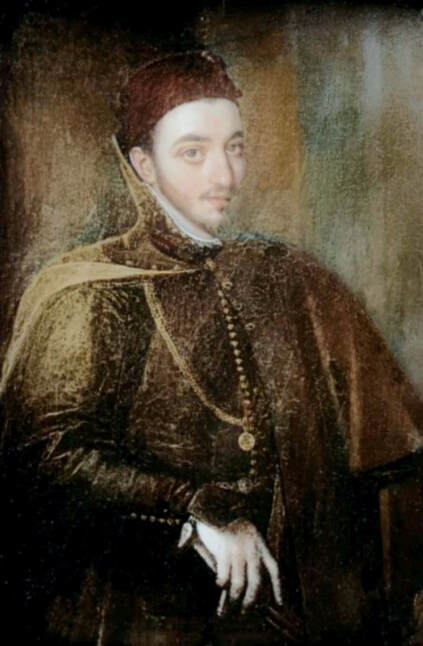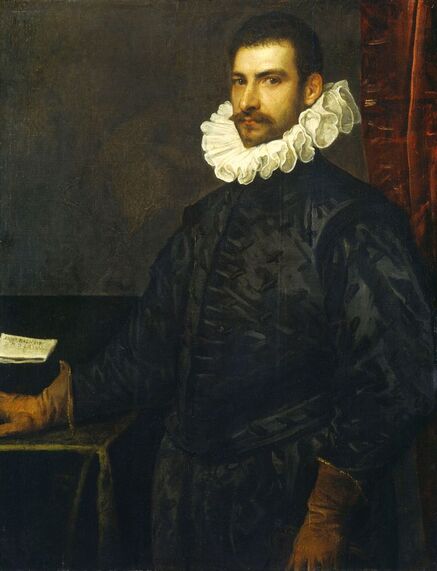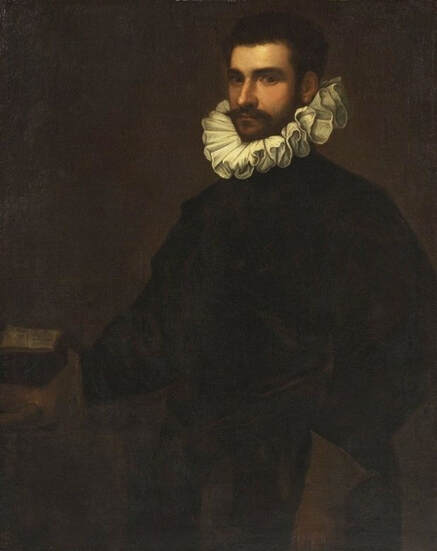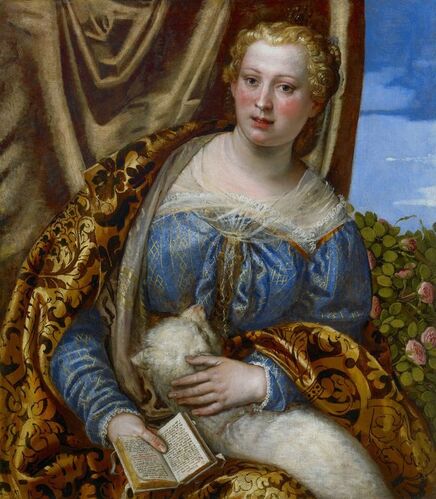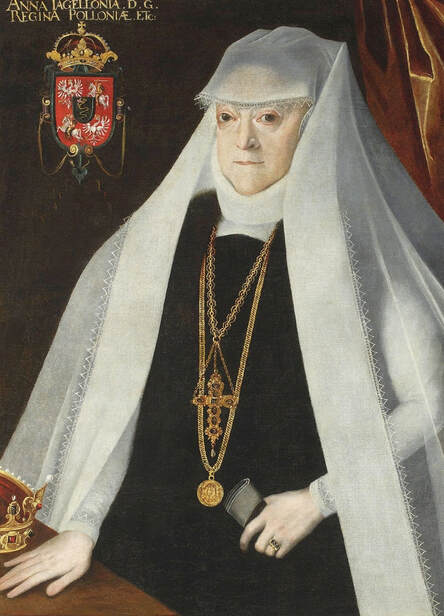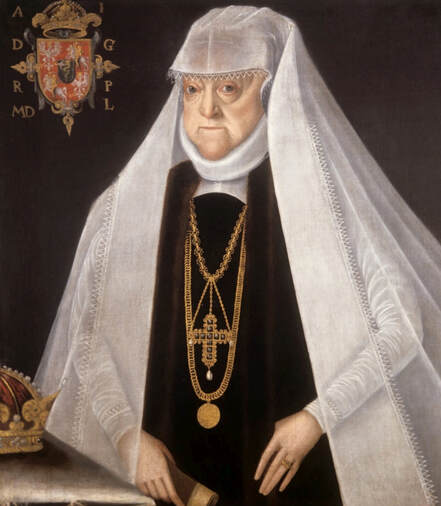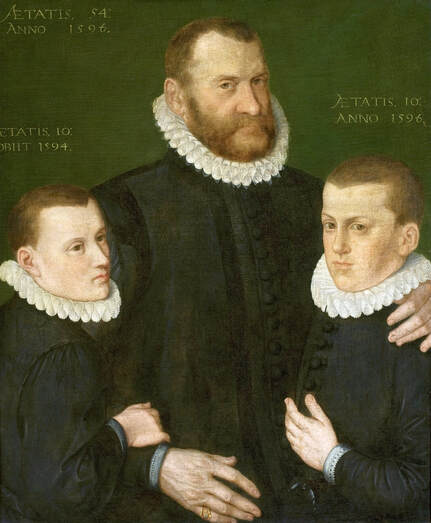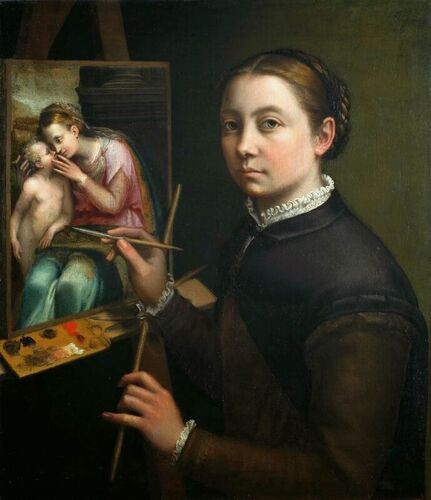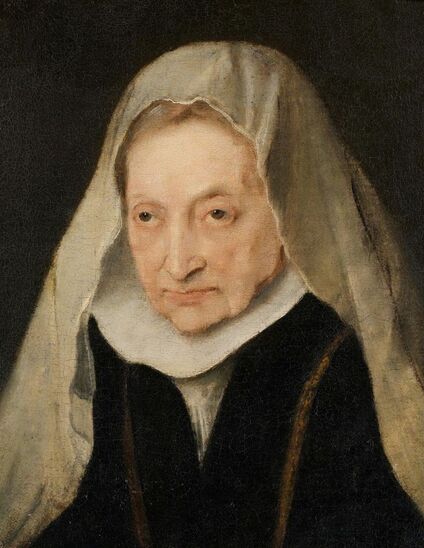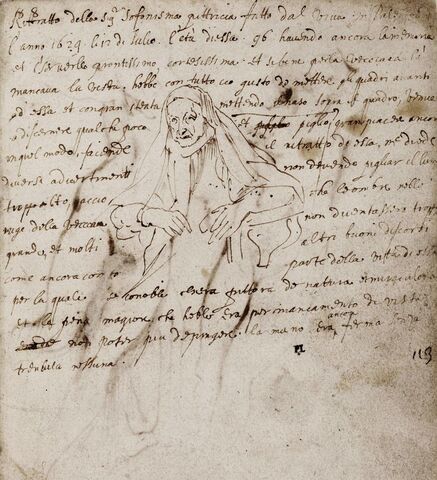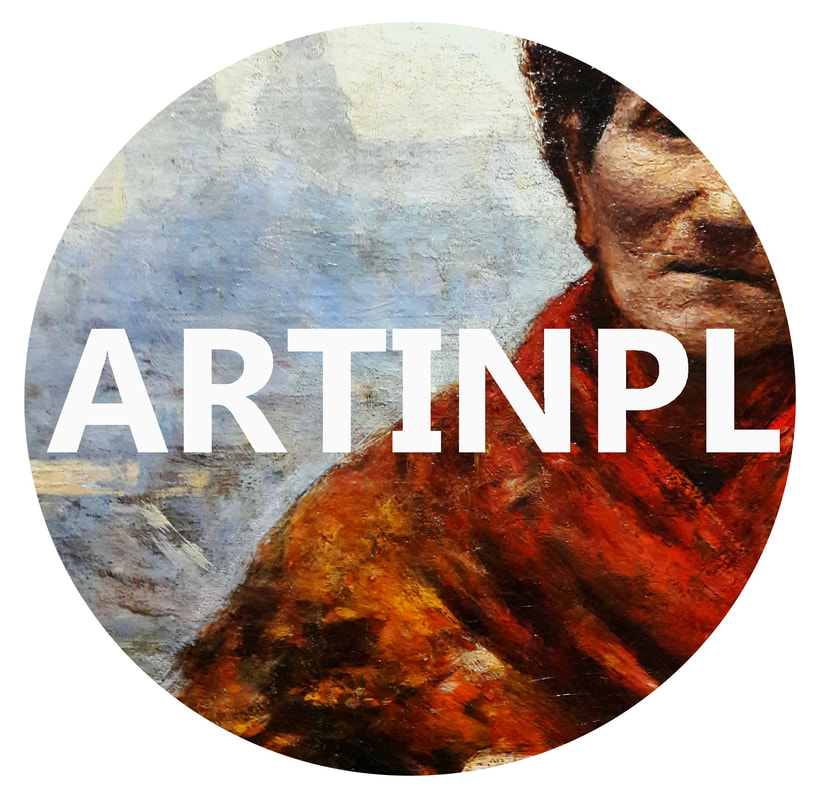|
Portraits of Anna Jagiellon by Tintoretto and circle of Titian
"The Queen is fresh and in such good health that I would not consider it a miracle if she were to become pregnant", reported from Warsaw on 29 January 1579, Giovanni Andrea Caligari (1527-1613), papal nuncio in Poland, about 56 years old Anna Jagiellon (1523-1596), elected co-ruler of the Polish-Lithuanian Commonwealth.
"In the sixteenth and seventeenth centuries, overweightness and obesity were considered symbols of sexual attractiveness and well-being" (Naheed Ali's "The Obesity Reality: A Comprehensive Approach to a Growing Problem", 2012, p. 7) and Anna's mother Bona Sforza, who visited Venice in 1556, was obese in her 40s and 50s, as visible in the cameo in the Metropolitan Museum of Art (inv. 17.190.869). At the end of November 1575 Austrian legation arrived in Warsaw, officially promising the infanta marriage to Archduke Ernest of Austria (1553-1592), the son of Emperor Maximilian II and Maria of Spain, and her relative as a grandson of Anna Jagellonica (1503-1547). But the offer was accepted very restrainedly and cautiously, even coldly. Anna was to reply modestly that she depended on the entire Republic and would only do what custom and the general will would require of her, and that she "entrusted her orphanage to God's holy protection" (after "Anna Jagiellonka" by Maria Bogucka, p. 118). The young Archduke, 30 years younger than the potential bride, undoubtedly received her effigy. News coming mainly from Vienna and Venice informed the general public about the course of 1575 royal election in the Commonwealth. The Fuggers, a prominent group of European bankers, learned about the election of Emperor Maximilian as king of Poland from reports sent from Vienna on December 16, 1575, and then from Venice (newspaper of 30 December) (after "Z dziejów obiegu informacji w Europie XVI wieku" by Jan Pirożyński, p. 141). In the Jagiellonian University Museum in Kraków there is a painting attributed to Tintorretto from about 1575 (after "Muzeum Uniwersytetu Jagiellońskiego" by Karol Estreicher, p. 100). This painting was offered to the Cracow Academy by Franciszek Karol Rogawski (1819-1888) in 1881 (oil on canvas, 110 x 96 cm, inventory number 2526). According to Rogawski's record, the portrait features the queen of Cyprus, Caterina Cornaro (1454-1510), and was acquired at Sedelmayer's auction in Vienna. It had earlier belonged to the Viennese gallery of Joseph Daniel Böhm (1794-1865) and was also attributed to Paolo Veronese, Battista Zelloti and circle of Bernardino Licinio (after "Foreign Painting in the Collections of the Collegium Maius" by Anna Jasińska, p. 146). The crown on her head alludes to a royal dignity, however, the woman's costume does not resemble well known effigies of the queen of Cyprus by Gentile Bellini and can be compered to the dress of La Belle Nani by Paolo Veronese (Louvre Museum), dated to about 1560, or to the costume of a lady from The Madonna of the Cuccina Family (Gemäldegalerie Alte Meister in Dresden), also by Veronese, painted around 1571. Her face has the appearance of not being taken live, as points out Enrico Maria Dal Pozzolo ("Un Michele da Verona e uno Jacopo Tintoretto a Cracovia", p. 104), who also attribute the canvas to Tintorretto. Therefore the painting was created after another effigy, a drawing or a miniature. The same woman was also depicted holding a cross and a book in a painting in the Gemäldegalerie Alte Meister in Kassel (inventory number GK 491), a copy of which was in the Swedish royal collection (18th century copy of lost original is in the Gripsholm Castle, inventory number NMGrh 187). The painting in Kassel is attributed to circle of Titian or specifically to his pupil Girolamo di Tiziano, also known as Girolamo Dante, and was acquired before 1749. This effigy is a pendant to portrait of Catherine Jagiellon, Duchess of Finland in white by Titian, identified by me. The woman bears strong resemblance to effigies of Anna Jagiellon, especially the miniature by Lucas Cranach the Younger in the Czartoryski Museum and her tomb sculpture at the Wawel Cathedral. Polish-Lithuanian magnates owned a number of paintings by Titian and Tintorretto, like Michał Hieronim Radziwiłł, who according to the Catalogue of his picture gallery, published in 1835 (Katalog galeryi obrazow sławnych mistrzów z różnych szkół zebranych przez ś. p. Michała Hieronima xięcia Radziwiłła wojew. wil. teraz w Królikarni pod Warszawą wystawionych), had a copy of Venus of Urbino by Titian (Portrait of Princess Isabella Jagiellon nude, identified by me), item 439 of the Catalogue, or "Portrait of a lady in a dark green dress trimmed with gold braid. She takes a flower from the basket with her right hand, and leaning, holds a crimson scarf with her left hand. Painting well preserved. - Painted on canvas. Height: elbow: 1, inch 16.5, width: elbow: 1, inch 10" (Portret damy, w sukni ciemno-zielonej, galonem złotym obszytej. Prawą ręką bierze z koszyka kwiatek, lewą oparta, trzyma szal karmazynowy. Obraz dobrze zachowany. - Mal. na płót. Wys. łok. 1 cali 16 1/2, szer. łok. 1 cali 10, item 33, p. 13), a landscape with staffage (item 213, p. 64) and an Italian landscape with a tree (item 273, p. 83), all attributed to Titian or Saint Paul and Anthony in the desert, painted on wood, attributed to Tintorretto (item 365, p. 108). In 1574 Anna decided to reactivate the postal service between Poland and Venice, suspended in 1572 after death of her brother, and to do so at her own expense (after "Viaggiatori polacchi in Italia" by Emanuele Kanceff, p. 106). The Queen, heiress of the Neapolitan sums, used Montelupi's postal facilities, who through their own agents, maintained close contact with the bankers in Naples, who sent them sums of money with great frequency (after "Saeculum Christianum", Vol. 1-2, p. 36). "In fact, we demand Y.L. [Your Lordship] as far as things or needs of our own are concerned, to pay no heed to our expense, because we will gladly cover it everywhere. But whatever may be sent through cursores ordinarios [ordinary messengers], please send through cursores, who may also go as far as Venice. And with the merchants goods, everything comes to us fast and at great cost. As for the other things, another time we will answer to Y.L. With this we wish Y.L. to be well. Dated Varsoviae, die 10 Novembris A. D. 1573. Kind to Y.L. Miss Anna Polish Princess", wrote the Infanta to cardinal Stanisław Hozjusz (after "Starożytności Historyczne Polskie ..." by Ambroży Grabowski, p. 21). Anna was a well known benefactor of the Cracow Academy (now Jagiellonian University) and she visted it twice on 20 July 1576 and on 24 April 1584. Three days after her last visit she sent the doctors of the Academy a mug of pure gold and a few beautifully bound books. If Elizabeth I (1533-1603), hereditary Queen of England, favoured the French fashion, especially "when the Anjou marriage negotiation were at their height" in about 1579 (Janet Arnold's "Queen Elizabeth's Wardrobe Unlock'd", 2020, p. 188), the elected Queen of the Polish-Lithuanian Republic, could prefer the fashion of the Venetian Serenissima.
Portrait of Anna Jagiellon (1523-1596), elected co-ruler of the Polish-Lithuanian Commonwealth by Jacopo Tintoretto, ca. 1575, Jagiellonian University Museum in Kraków.
Portrait of Anna Jagiellon (1523-1596) holding a cross and a book by circle of Titian, 1560-1578, Gemäldegalerie Alte Meister in Kassel.
Portrait of Anna Jagiellon (1523-1596) holding a cross and a book by Georg Engelhard Schröder after original by circle of Titian, 1724-1750, Nationalmuseum in Stockholm.
Portrait of Henry of Valois by workshop of Tintoretto
After the death of Sigismund II Augustus in 1572, Catherine of Medici, Queen of France, willing to make her favourite son Henry of Valois, Duke of Anjou the king of Poland, sent her court dwarf Jan Krasowski, called Domino to the Polish-Lithuanian Commonwealth. Under the guise of visiting his family in his homeland, he was to make some inquiries and explore the mood in the Commonwealth. Catherine used all her power to offer the crown to her son by influencing the noble electors.
In order to be more agreeable to the Ottoman Empire and strengthen a Polish-Ottoman alliance, on 16 May 1573, Polish-Lithuanian nobles chose Henry as the first elected monarch of the Commonwealth. He was officially crowned on 21 February 1574. Expecting that Henry will marry her and she will become a Queen, Infanta Anna Jagiellon the wealthiest woman in the country and a sister of his predecessor, ordered French lilies to be embroidered on her dresses. Already in 1572, the Infanta was accused of wanting the crown for herself or to impose her candidate against the will of the council and the lords of the kingdom. "We already see that Y[our] H[ighness] is doing something without our will, with great anger. We see that you want this crown for you, but you will not elect us the lord", Anna cited the accusations made by the council in a letter of December 18, 1572 from Warsaw to her sister Sophia Jagiellon, Duchess of Brunswick-Lüneburg. She was also accused of attempts to poison opposition leaders, including Franciszek Krasiński, Bishop of Kraków and Calvinist Jan Firlej, Voivode of Kraków - according to letter from Wawrzyniec Rylski, courtier of Catherine Jagiellon, to Duchess Sophia dated February 2, 1573 from Warsaw (after "Jagiellonki polskie ..." by Alexander Przezdziecki, Volume 4, pp. 12, 30). Despite the fact that he arrived to Poland with a large retinue of his young male lovers, known as the mignons (French for "the darlings"), including René de Villequier, François d'O and his brother Jean, Louis de Béranger du Guast and especially his beloved Jacques de Lévis, comte de Caylus (or Quélus), and that "he even flattered the Polish lords by cleverly adopting their attire", as wrote Venetian envoy Girolamo Lippomano, he was not feeling well in the unknown country. After death of his brother Charles IX, Catherine urged him to return to France. During the night of 18/19 June 1574, Henry secretly fled the Commonwealth. The portrait of a man in black hat by workshop of Tintoretto from private collection in Milan (reported before 1995, compare Fototeca Zeri, Numero scheda 44861), is almost identical with the portrait of Henry depicted against the wall hanging with his coat of arms as King of Poland in the Museum of Fine Arts in Budapest by Italian painter (inventory 52.602) and his portrait holding a crown in the Doge's Palace in Venice (Sala degli Stucchi) by workshop of Tintoretto. It bears no distinction, no reference to his royal status, as in mentioned two portraits in Budapest and Venice, he is depicted as a simple nobleman. It is higly probable then that it was one of a series of state portraits commissioned by Anna in Venice before Henry's coronation, as a clear signal that he should marry her before becoming a king. The Infanta was most probably well aware of his inclination towards men, as apart from Krasowski, there were also other Polish dwarfs at the French court. Raised at the multicultural court of the Jagiellons, where people spoke Latin, Italian, Ruthenian, Polish and German, they were perfect diplomats. In 1572 king Sigismund Augustus sent to Charles IX, four dwarfs and in October that year, Claude La Loue brought another three dwarfs from Poland as a gift from Emperor Maximilian II, father of Charles IX's wife Elisabeth of Austria (after Auguste Jal's "Dictionnaire critique de biographie et d'histoire", 1867, p. 896). A portrait, said to be Mariana of Austria with a female dwarf wearing a wimple from a private collection in Spain, lost (Mariana de Austria con una enana, collection of Antonio Hoffmayer in Madrid, oil on canvas, 186 x 116 cm, Archivo de Arte Español - Archivo Moreno, 02342 B), is very similar to the portrait of Elisabeth of Austria in the Kunsthistorisches Museum in Vienna (inv. GG 3273), which is attributed to Giacomo de Monte (Netherlandish Jakob de Monte, according to some sources). Painter of similar name, Giovanni del Monte, possibly Giacomo's brother, is mentioned as a court painter of Sigismund Augustus before 1557. It is therefore highly probable that the portrait of Queen of France with her dwarf was created for or at the initiative of the Polish-Lithuanian court. On April 28, 2021 a portrait of a young woman wearing an embroidered dress and a pearl necklace by North Italian School was sold on an auction in London (oil on canvas, 25 x 18.5 cm, Sotheby's, lot 317). On other auction her dress was identified as Spanish court dress (Neumeister in Munich, July 15, 2020, auction 388, lot 141). Her costume and style of this painting resembles the portrait of Elisabeth of Valois, Queen of Spain with a female dwarf by Sofonisba Anguissola or her workshop (Basque Museum in Bayonne), the painter who joins the two mentioned terms (North Italian School and Spanish court). The woman in the portrait strongly resembles the effigies of Elisabeth of Austria, especially her best-known portrait by François Clouet in the Louvre, mentioned likeness in Vienna by de Monte and her face from the effigy by Jooris van der Straaten in the Convent of Las Descalzas Reales in Madrid, dated to about 1573. The portrait of Elisabeth's sister Anne, Queen of Spain by Sofonisba is also dated to about 1573 (Prado Museum, P001284). In several portraits, Elisabeth has blond hair, while in this one as well as in the portrait by de Monte, her hair is dark, which could indicate that at some point she lightened her hair or that painters copying effigies from general drawings were unaware of her true hair color. The style of this small portrait is also very similar to another signed work of Sofonisba - portrait of Cameria in the Musée Fabre in Montpellier (inventory number 65.2.1). Elisabeth, like her sister Anne, Queen of Spain, were both granddaughters on the paternal side of Anna Jagellonica (1503-1547), and as in the case of dynastic relations, the links between artists and patrons from different countries of Europe, including Poland-Lithuania, were also strong. Due to the still small number of medalists in the country, the royal court usually commissioned images of this kind abroad, in Vienna or Prague. Only once, during the short reign of Henry of Valois, did the court order two coronation medals from Parisian artists (after "Dzieje sztuki medalierskiej w Polsce" by Adam Więcek, p. 85). Medals of Henry of Valois on the election as King of Poland, attributed to French sculptor Germain Pilon, are in the National Museum in Kraków (inventory number MNK VII-Md-97) and in the Royal Castle in Warsaw (ZKW.N.830/2511). Similar was the case for portrait paintings, and Venice was the nearest center with a large number of painting workshops.
Portrait of Henry of Valois (1551-1589), elected monarch of the Polish-Lithuanian Commonwealth by workshop of Tintoretto, ca. 1573, Private collection.
Portrait of Elisabeth of Austria (1554-1592), Queen of France by workshop of Sofonisba Anguissola, ca. 1573, Private collection.
Portrait of Elisabeth of Austria (1554-1592), wife of Charles IX as a widow with a female dwarf wearing a wimple by Jakob de Monte (?), after 1574, Private collection, lost. Virtual reconstruction, © Marcin Latka
Portrait of Maria of Portugal, Duchess of Parma and Piacenza by Sofonisba Anguissola or workshop
In 1573, the young Alexander Farnese (1545-1592), aged 28, son of Ottavio Farnese (1524-1586), Duke of Parma and Piacenza, grandson of Pope Paul III, and Margaret of Austria (1522-1586), the illegitimate daughter of Emperor Charles V, participated as a candidate in the first free royal election held in the Polish-Lithuanian Commonwealth. Thanks to the support of the Italian community, he was an important candidate and, with Alfonso II d'Este (1533-1597), Duke of Ferrara, he participated in three elections (in 1573, 1576 and 1587). "The ruler of Ferrara was considered somewhat advanced in age, and the Duke of Parma, a young and brave soldier, satisfied the ambitions of the Poles. However, he did not represent the appropriate political position and did not have adequate cash at his disposal. For these reasons, he could not be considered as a serious candidate" (after "Dwór medycejski i Habsburgowie ..." by Danuta Quirini-Popławska, p. 123).
His chances for the crown increased during the third election, he became governor of the Spanish Netherlands in 1578 and Duke of Parma and Piacenza in 1586, and he could count on the support of his uncle Philip II of Spain. As in every election, the candidates had to present themselves to the electorate, who were interested not only in their political connections, wealth and leadership skills, but also in their appearance and personal lives. The portrait of Alfonso II d'Este from the Popławski collection, attributed to Hans von Aachen, most likely commissioned in Venice, Augsburg or Prague, where the painter was then active, now in the National Museum in Warsaw (oil on canvas, 134 x 102 cm, M.Ob.1913 MNW), is probably linked to the duke's candidacy for the royal election of 1587. A fine portrait of the Duke of Parma, attributed to Antoon Claeissens, also probably made around 1587, is also in the National Museum in Warsaw (oil on panel, 44.5 x 33.5 cm, M.Ob.2749 MNW). It was purchased from Czesław Domaradzki in 1950 and bears the inscription in Latin in the upper right corner: ALEXANDER FARNESIVS PRINCEPS PARMÆ. On November 11, 1565, Alexander married in Brussels the Infanta Maria of Portugal (1538-1577), granddaughter of King Manuel I and cousin of King Sebastian. The splendid celebrations of this marriage are commemorated in the so-called "Brussels Album", attributed to the circle of Francis Floris the Elder, now kept in the Library of the University of Warsaw (Print Room, zb.d.10255). The couple settled in Parma in 1566 and Maria bore her husband three children: Ranuccio (1569-1622), Margaret (1567-1643) and Odoardo (1573-1626). She died in 1577 at the age of thirty-nine, but in 1573 and 1575 she could see herself as a potential future Queen of Poland and Grand Duchess of Lithuania. Before the Second World War, in the Potocki collection, probably in the splendid Łańcut Castle, there was a portrait of a lady, attributed to the French painter François Clouet (d. 1572). Before 1940, along with other paintings, it was evacuated to the United States and exhibited in the Polish pavilion at the New York World's Fair opened on April 30, 1939, included in the catalog: "For Peace and Freedom. Old masters: a collection of Polish-owned works of art, arranged by the European Art Galleries, Inc., to help to maintain the exhibit of Poland at the World's Fair, New York, 1940" (item 64, p. 53, 65). This painting is now in the Museo de Arte de Ponce in Ponce, Puerto Rico (oil on panel, 50.5 x 39.7 cm, inv. 59.0072). It was purchased in New York in 1959. This "Portrait of a Lady with a Carnation" is attributed to the circle of the Spanish painter Alonso Sánchez Coello and dated to around 1566. The portrait is believed to depict Maria of Portugal, Duchess of Parma and Piacenza, whose husband also had his portrait painted by Sánchez Coello. The sitter was keen to emphasize that she is an exemplary wife, as the red carnation that hangs from the her neck probably serves as a symbol of love, marriage and fidelity. Her rich, jeweled costume testifies to aristocratic splendor and wealth. A perfect candidate for a queen. The model resembles the Duchess of Parma from some of her portraits. The lips closely resemble well-known portraits of Maria, such as the painting in the Pinacoteca Stuard in Parma (inv. 23), attributed to the circle of Antonis Mor or Girolamo Mazzola Bedoli, which probably shows her in her wedding dress, a prototype of which was most likely painted in Brussels in 1565. Copies of the portrait from the Pinacoteca Stuard are in the Galleria nazionale di Parma (inv. 1177/5), attributed to the Portuguese painter Francisco de Holanda, and in a private collection (Dorotheum in Vienna, June 9, 2020, lot 48), perhaps painted by Otto van Veen or his workshop around 1600. The lady's dark complexion and costume resemble those from the portrait of Maria kept at the Museu Nacional de Arte Antiga in Lisbon (inv. 2094 Pint), purchased in Paris in 1957, attributed to Joris van der Straeten, who probably visited the Portugal in 1556 (hence the general dating of this portrait). However, the identification of the model and the attribution of the Lisbon portrait are now called into question after the discovery of a very similar portrait, attributed to Gillis Claeissens (1526-1605), brother of Antoon, a Flemish painter active in Bruges (Christie's London, sale 1165, December 4, 2013, lot 118, compare "Shopping for Global Goods. Portrait of a Gentleman" by Annemarie Jordan Gschwend and Hugo Miguel Crespo, p. 48). Although it is possible that the woman in the portraits attributed to Claeissens is not Maria of Portugal, the small differences in appearance could be the result of copying that frequently distorted the features, as in the case of the portraits of Emperor Charles V made by Italians, Flemish and German painters. According to the traditional approach, the painter and sitter must have met in person, so identifications and attributions are often based on this factor. It should be noted, however, that copies were frequently made from other effigies and that a skilled painter could adapt an older effigy and modify its appearance, costume, hairstyle and other elements according to fashion. Another intriguing aspect of the portrait from the Potocki collection is its author. The style of the painting is very similar to paintings attributed to Sofonisba Anguissola, who from February 1560 until the summer of 1573 lived at the Spanish court, then in Palermo, Sicily, until 1579. Particularly similar is portrait of Catalina Micaela of Spain (1567-1597), Duchess of Savoy (Christie's New York, October 14, 2021, lot 101, inscription: . CATHARINA . AVST RIACA . INF . HISP / . DVCISSA . SAB). The manner in which the face and background were painted is also comparable to Sofonisba's self-portrait of 1558 (Palazzo Colonna in Rome, inv. 268) and portrait of Gustav Eriksson Vasa (1568-1607) (Van Ham Kunstauktionen in Cologne, June 2, 2021, lot 926), identified by me. Besides this painting, the most famous painting from the Potocki collection in Łańcut Castle is another work by Sofonisba Anguissola, her self-portrait at the easel painting a devotional painting with the Virgin Mary, created in 1556 (inv. S.916MŁ). It first appeared in inventories from 1862 and survived many invasions of Poland, including World War II. Although it is believed that it was included in the castle's collections in the second half of the 18th century thanks to Princess Izabela Lubomirska (1736-1816), called the "Blue Marquise", who allegedly purchased it during one of her trips through Europe, it is also possible that it was transferred to Poland already in the 16th century and both paintings testify that Anguissola frequently worked for clients from Poland-Lithuania, directly or indirectly as in this case.
Portrait of Maria of Portugal (1538-1577), Duchess of Parma and Piacenza, from the Potocki collection by Sofonisba Anguissola or workshop, ca. 1566-1575, Museo de Arte de Ponce.
Portrait of Alexander Farnese (1545-1592), Duke of Parma and Piacenza by Antoon Claeissens, ca. 1587, National Museum in Warsaw.
Portrait of Alfonso II d'Este (1533-1597), Duke of Ferrara by Hans von Aachen, ca. 1587-1597, National Museum in Warsaw.
Portraits of Joachim Frederick of Brzeg by Adriaen Thomasz. Key
In 1574 Joachim Frederick (1550-1602), the eldest son of George II the Pious, Duke of Brzeg-Oława-Wołów, arrived to Kraków. He was sent there by his uncle Elector John George as a representative of Brandenburg during the coronation of the newly elected King of Poland, French Prince Henry of Valois. During his youth, Joachim Frederick spent several years at the court of his uncle. The next year, in 1575, he attended the coronation of Rudolf II as king of the Romans in Regensburg.
Joachim Frederick was a representative of the Silesian Piasts, descendants of the first historical ruling dynasty of Poland. Also Emperor Maximilian II, whose son Archduke Ernest of Austria was a candidate for the throne in the free election of 1573, sent a delegation to the royal coronation entrusting it to another Piast - Wenceslaus III Adam, Duke of Cieszyn. Despite the disappointment of his son's defeat, it was necessary to strive to maintain good relations with Poland, mainly due to concerns about Silesia. "Towards the King of Poland he cannot help and his Majesty is filled with regret, seeing him occupy that office, which he designated for his son, [...], and also because this king, besides being powerful and bordering on a great distance, can lay claim to Silesia, a very important province", a Venetian envoy Giovanni Correr reported on May 30, 1574 (finally drawn up on August 29, 1578). Oratio Malaspina wrote from Prague to Cardinal Como on July 10, 1579, that the Polish envoy "came to renew the ancient confederations between the Kingdom of Poland and the province of Silesia" and Bishop Giovanni Andrea Caligari wrote to the same Cardinal Como from Vilnius on August 10, 1579 that "In addition to the things in Hungary, the king could easily take Silesia and Moravia from the emperor, and he would have help from all those German princes who do not love the house of Austria, and there are many of them" (after "Księstwo legnickie ..." by Ludwik Bazylow, p. 482). Abraham de Bruyn (d. 1587), a Flemish engraver from Antwerp, who established himself at Cologne about the year 1577, created several depictions of Polish-Lithuanian noblemen, however, only three engravings of people from other social spheres related to the territory of today's Poland are known. They represent the inhabitants of Gdańsk (four patricians from Gdańsk and nine women of different classes) and two Silesian women, which clearly indicate the main areas of Netherlandish presence in this part of Europe. While Martin Kober, a Silesian painter born in Wrocław become around 1583 the court painter of the Polish king Stephen Bathory, the leading artists working in Silesia in the second half of the 16th century were a Dutch painter Tobias Fendt (d. 1576), educated in the studio of Lambert Lombard in Liège and active in Wrocław since 1565, and sculptor Gerhard Hendrik (1559-1615) from Amsterdam, who between 1578-1585 lived in Gdańsk and after traveling to France, Italy and Germany, he settled in Wrocław in 1587. On May 19, 1577, Joachim Frederick married Anna Maria of Anhalt. After the death of his father in 1586, he received the Duchy of Brzeg to which, however, his mother Barbara of Brandenburg (1527-1595) was entitled to as a widow. In the National Museum in Warsaw there is a portrait of a young man in French costume - black satin doublet and a ruff (oil on panel, 47 x 33 cm, inventory number M.Ob.819 MNW, earlier 186634). It comes from the collecting point of the Ministry of Culture and Art Paulinum in Jelenia Góra, Silesia and was acquired as a result of the so-called restitution campaign in 1945 (after "Early Netherlandish, Dutch, Flemish and Belgian Paintings 1494–1983" by Hanna Benesz and Maria Kluk, item 351). It is attributed to Adriaen Thomasz. Key, a Flemish painter active in Antwerp, who adopted the Key family name after taking over the workshop of his master Willem Key in 1567. Adriaen specialized in portraiture and worked successfully for wealthy merchants and the court. He was a Calvinist, but continued to live in the city after the Fall of Antwerp in 1585, when all Protestants were given four years to settle their affairs and leave the city. He died in Antwerp in or after 1589. According to inscription in upper part of the painting the man was 24 in 1574 (1574 / Æ T A 24), exactly as Joachim Frederick, born September 29, 1550 in Brzeg, when he arrived to Kraków for the coronation of French Prince Henry of Valois as King of Poland. The same man, in similar costume, was depicted in another painting attributed to Key, today in the Kunsthistorisches Museum in Vienna (Gemäldegalerie, oil on panel, 98.5 x 71 cm, inventory number 808), verifiable in the gallery in 1720, therefore most probably coming from the old collections of the House of Habsburg. Because of similar dimensions, this portrait is considered to be a counterpart to the portrait of a lady dated '1575' (Gemäldegalerie, oil on panel, 99.5 x 70.8, inventory number 811), however, the composition is not matching. The woman is much larger when comparing the pictures, which is very unusual for a European portraiture, even if she was actually taller. As the numbers indicate, they were not included in the inventory at the same time and therefore were not previously considered a pair. Small differences in these images (in Warsaw and Vienna) are noticeable, such as the color of the eyes, but a comparison with the portraits of Philip II, King of Spain by Anthonis Mor and workshop, proves that even the same workshop interpreted the same image differently. The man bear a strong resemblance to Barbara of Brandenburg, Joachim Frederick's mother, from her statue above the main gate of the Brzeg Castle (created by Andreas Walther and Jakob Warter, between 1551-1553) and his grandmother Magdalena of Saxony (1507-1534), daughter of Barbara Jagiellon (1478-1534), Duchess of Saxony. In portraits by Lucas Cranach the Elder and his workshop (Art Institute of Chicago, Grunewald hunting lodge in Berlin), the color of Magdalena's eyes is different (brown/blue). The shape of the nose is especially characteristic in these family members.
Portrait of Joachim Frederick of Brzeg (1550-1602), aged 24 by Adriaen Thomasz. Key, 1574, National Museum in Warsaw.
Portrait of Joachim Frederick of Brzeg (1550-1602) by Adriaen Thomasz. Key, ca. 1575, Kunsthistorisches Museum in Vienna.
Portrait of Sophia Jagiellon and Sidonia von Borcke by Adriaen Thomasz. Key
Two paintings by German school in the Von Borcke Palace in Starogard, north of Szczecin, both lost during World War II, depicted members of the Jagiellonian dynasty. One, created by workshop of Lucas Cranach the Elder and representing pregnant Barbara Radziwill with a midwife, was traditionally identified as the most famous member of the Von Borcke family - Sidonia the Sorceress (1548-1620), the other was a signed effigy of Sophia Jagiellon (1522-1575), Duchess of Brunswick-Lüneburg.
Von Borcke, a Pomeranian noble family of Slavic origin, originally known as Borek or z Borku and having two red wolves in their coat of arms, were owners of the large estates in Pomerania with several towns, including Łobez, Resko, Strzmiele, Węgorzyno and Pęzino Castle. Since the times of Maćko Bork (Matzko von Borck), who died in about 1426, the family had some ties to the Jagiellons and Poland. His great-granddaughter, mentioned Sidonia, lived at the court of Duke Philip I in Wolgast and became a lady-in-waiting to his daughter princess Amelia of Pomerania (1547-1580). In 1569 the Polish court planned to marry Amelia to Albert Frederick, Duke of Prussia and Polish vassal. The son of Philip I, Prince Ernest Louis (1545-1592), fall in love with Sidonia and promised her marriage. However, the wedding did not take place, as the prince, under pressure from his family, withdrew from his promise and in 1577 he married Sophia Hedwig of Brunswick-Wolfenbüttel (1561-1631), granddaughter of Hedwig Jagiellon (1513-1573), Electress of Brandenburg, daughter of Sigismund I. In 1556 Sophia Hedwig's grandfather, Henry V (II) of Brunswick-Lüneburg (1489-1568), married a daughter of Sigismund I - Sophia Jagiellon. In 1619 in Wolfenbüttel, grandson of Duke Philip I, Duke Ulrich of Pomerania (1589-1622) married a great-granddaughter of Hedwig Jagiellon and Henry V, Princess Hedwig of Brunswick-Wolfenbüttel (1595-1650). The family ties between the ruling families of Poland-Lithuania, Pomerania and Brunswick-Wolfenbüttel were therefore pretty strong at that time. Two known portraits of Hedwig of Brunswick-Wolfenbüttel in French costume and large cartwheel farthingale (in the Royal Collection, RCIN 407222 and in the Gymnasium in Szczecinek, lost during World War II) were painted by a Netherlandish painter, attributed to Jacob van Doordt, Marcus Gheeraerts the Younger, Daniël Mijtens or Paulus Moreelse. The Dukes of Pomerania frequently commissioned their effigies from the best foreign artists and the so-called "Book of effigies" (Visierungsbuch) of Duke Philip II of Pomerania (Pomeranian State Museum in Szczecin, lost during World War II) was a collection of their likenesses, some of which were attributed to circle of Albrecht Dürer and Lucas Cranach the Elder. The so-called Croy tapestry in the Pommersches Landesmuseum representing the Duke Philip I with his family as well as the family of his wife Maria of Saxony was made in 1554 by Peter Heymans, a Dutch weaver, in Szczecin. The composition of the tapestry was based on the graphics by Lucas Cranach the Elder and it is possible that Cranach's workshop in Wittenberg created the cartoon to this work. The painting of Madonna and Child with cherries by circle of the Netherlandish painter Quentin Matsys was acquired by Duke Bogislaw X (Pomeranian State Museum in Greifswald), some jewels of the Dukes of Pomerania from the late 16th and early 17th century are attributed to Jacob Mores the Elder, active in Hamburg (National Museum in Szczecin), a cup in the shape of a peacock, created by Joachim Hiller in Wrocław in Silesia and a crystal bowl made in Paris and framed in Szczecin, both owned by Erdmuthe of Brandenburg, Duchess of Pomerania are in Green Vault in Dresden. The dukes also commissioned and purchased many exquisite objects from the center of European goldsmithing - Augsburg, like the famous Pomeranian Art Cabinet of Duke Philip II, silver plaques by Zacharias Lencker from Darłowo Altar or ivory veneered and painted box with exotic parrots, fish, and other animals and coat of arms of Philip II of Pomerania and his wife (Courtauld Institute of Art). Some contacts with Italy and Italian artists in this part of Europe are also documented. In 1496 Duke Bogislaw X went on a pilgrimage to the Holy Land, leaving his duchy under the regency of his wife Anna Jagiellon (1476-1503), sister of Sigismund I. He traveled to Venice and he was received in Rome by the Pope Alexander VI Borgia, who presented him with a ceremonial sword (nowdays in the collection of the Hohenzollern Castle, scabbard, in the Monbijou Palace in Berlin, was lost during World War II). Mannerist west wing of the Castle in Szczecin was built between 1573 and 1582 by Italian architects Wilhelm Zachariasz Italus and Antonio Guglielmo (Antonius Wilhelm) for Duke John Frederick (1542-1600) and Giovanni Battista Perini (Parine) from Florence created the painting to the ducal chapel and duke's portrait. Portrait of Duke Boguslaus XIV (1580-1637) is in the Villa di Poggio a Caiano, one of the most famous Medici villas near Florence. In 1576 de Hane (d'Anna) family from Brabant, settled in Lübeck in Germany, about 290 km west of Szczecin, ordered a painting in Venice for the St. Catherine's Church in Lübeck. This large canvas depicting the Raising of Lazarus (140 x 104 cm) and representing some members of the family in the background, was painted by Tintoretto (signed and dated: IACO TINTORE / VENETIS F. / 1576). Around 1575 other Venetian painter Parrasio Micheli created a large painting depicting Allegory of the birth of the Infante Ferdinand, son of Philip II of Spain, today in the Prado Museum in Madrid (oil on canvas, 182 x 223 cm, inventory number P000479). The work was created in Venice with a portrait of Infante's mother Anna of Austria (1549-1580), Queen of Spain, granddaughter of Anna Jagellonica (1503-1547), Queen of Germany, Bohemia, and Hungary. The painting was sent by Micheli to Philip II without a commission, to win the favor of the monarch. Spanish monarchs also sent similar gifts to relatives, mostly in Vienna. A large painting by Alonso Sánchez Coello depicting King Philip II of Spain banqueting with his family and courtiers (The Royal feast), created in 1596 (signed and dated: ASC ANNO 1596), purchased by the National Museum in Warsaw in 1928 from Antoni Kolasiński's collection (oil on canvas, 110 x 202 cm, inventory number M.Ob.295, earlier 73635) was perhaps such a gift sent to the Polish-Lithuanian royal family. Micheli also painted the Dead Christ venerated by Pope Pius V, which could be another gift to powerful King of Spain ordered in Venice, this time from the Pope (Prado Museum, P000284). Netherlandish painters created effigies of both Philip II and his wife. A small portrait of the King of Spain from private collection (oil on panel, 46.4 x 35.6 cm), identified by me, is attributed to Adriaen Thomasz. Key, a portrait of Anna of Austria in Alte Pinakothek in Munich (inventory number 4859) was created by Flemish painter (attributed to Justus van Egmont) and very similar preparatory drawing in Albertina Museum in Vienna (inventory number 14269) is also attributed to Key (also to Antonis Mor or Peter Candid, similar to signed portrait painting by Alonso Sánchez Coello in the Kunsthistorisches Museum, inventory number 1733). In her last years the Duchess of Brunswick-Lüneburg, Sophia Jagiellon, retired to the families residence in Schöningen, where she laid out the famous pleasure garden, which no longer exists today. She remodelled her residencies at Schöningen and Jerxheim in Renaissance style, according to the taste of the time. Her husband Henry V died in 1568 and two years later, in the spring of 1570, Sophia converted to Lutheranism. Most likely around that time a tombstone of Henry V, his two sons, killed in the Battle of Sievershausen in 1553, was created in Marienkirche in Wolfenbüttel. The tombstone is attributed to Jürgen Spinnrad and after the Duchess' death Adam Lecuir (Liquier Beaumont), a sculptor trained in Antwerp, created her relief sculpture basing on an effigy from the time of her marriage (1556). When her stepson tried to limit her authority as a widow, she appealed to Emperor Maximilian II and promised him to support Archduke Ernest's candidacy for the Polish throne and his marriage to her sister Anna. However, Stanisław Sędziwoj Czarnkowski, a supporter of the emperor's son, complained in a letter to Sophia that he tried to persuade Anna to accept the portrait of Archduke Ernest, "which Her Majesty by any mean whatever didn't want to" and further reports that "for four Sundays a picture of a French prince hung at her place". Earlier, in April 1570, Sophia's brother Sigismund II Augustus sent Czarnkowski as his envoy for arbitration in affairs with her stepson, Henry's successor, Julius (1528-1589). The Duchess was fluent in Polish, Italian, Latin and German, and she left a lively correspondence with more than 184 correspondents. She proved herself to be a good financial manager. Sophia had a reputation as a very rich woman with a large amount of cash and borrowing money at interest. The cities of Leipzig - 20,000 thalers, and Magdeburg - 30,000 thalers, took the largest 5% loans from the Duchess, as well as the Elector of Brandenburg, John George - 20,000 thalers and her stepsister Hedwig - 1,000 thalers. Her regular customer-debtor was her stepson, Julius, who often borrowed large sums (e.g. 15,000 thalers in November 1572). She also invested money in various goods, both movable and immovable (after "Zofia Jagiellonka ..." by Jan Pirożyński, p. 70). In her last will, she left Stanisław Sędziwój and his brother Wojciech Sędziwój Czarnkowski (his portrait by Adriaen Thomasz. Key is in Vienna) 500 ducats each. Duke Julius studied in Leuven (Louvain) in the Habsburg Netherlands and visited France in 1550. Under his rule many Netherlandish artists, architects and engineers were employed by the ducal court of Wolfenbüttel, like Willem de Raet from 's-Hertogenbosch (1574–1576), entrusted with the modernisation of the waterways, recruited for Duke Julius by his compatriot, painter Willem Remmers, or a painter Hans Vredeman de Vries (1587–1591), who created a portrait of Sophia's niece Hedwig of Brandenburg (1540-1602), Duchess of Brunswick-Wolfenbüttel and who later moved to Gdańsk (1592-1595). Ruprecht Lobri from the Low Countries become the personal valet of the duke. After discovery of the deposits of decorative stones (marble and alabaster) in his territory in the early 1570s Julius contracted stone cutters from Mechelen: Hendrick van den Broecke, Augustin Adriaens and Jan Eskens. The duke offered alabaster portals to his stepmother Sophia Jagiellon, and the magistrates of Gdańsk and Bremen and sent letters with samples, such as tabletops and dishes, to Duke Henry XI of Legnica and Duke Albert Frederick of Prussia (after "Netherlandish artists and craftsmen ..." by Aleksandra Lipinska), both having close ties with the Polish-Lithuanian Commonwealth. Sophia bequeathed half of her inheritance to her sisters and the other half to the Commonwealth institutions. Among other things, she decreed that marble tombs should be built in the Wawel Cathedral and that a marble slab engraved with the genealogy of the Jagiellons should be placed in the Chapel of the Holy Cross. The 1575 inventories of the collection of the Duchess of Brunswick list more than 100 paintings and 31 portraits, including images of Sigismund Augustus, the children of her sister Catherine Jagiellon - Sigismund and Anna Vasa, and king Henry of Valois, as well as one historical painting depicting the beheading in 1568 of Lamoral of Egmont and Philip de Montmorency, Count of Horn, the leaders of the anti-Spanish opposition in the Low Countries, most probably by Flemish painter. Her book collection consisted of about 500 items, many of which had beautiful, luxurious bindings. The Map of Poland (Poloniae Recens Descriptio. Polonia Sarmatie Europee quondam pars fuit ...) in the Herzog August Bibliothek in Wolfenbüttel, created in 1562 by Hieronymus Cock in Antwerp, was most likely commissioned by Sophia Jagiellon. In the National Museum in Warsaw there is a portrait of a woman with a gold chain around the waist, attributed to Adriaen Thomasz. Key (oil on panel, 74 x 52.5 cm, inventory number M.Ob.822 MNW, earlier 34666). It was purchased in 1935 from the collection of Jan Popławski and in the 19th century it was in the Shchukin collection in Moscow. Her costume resembles the one seen in the portrait of Ermgart von Bemmelsberg by Westphalian school, painted in 1574 (private collection), portrait of a woman by Adriaen Thomasz. Key, dated '1578' (Kunsthistorisches Museum in Vienna, 1036), and costumes of women of Brabant and Gdańsk from Omnium pene Europae ... by Flemish engraver Abraham de Bruyn, published in 1581. Her ruff is similar to the one visible in the mentioned portrait of Queen of Spain by Flemish painter in Munich and in the effigy of Joachim Frederick of Brzeg (1550-1602) by Adriaen Thomasz. Key, dated '1574' (National Museum in Warsaw, M.Ob.819). Her face and pose resemble other effigies of the Duchess of Brunswick-Lüneburg, identified by me, especially the portrait by circle of Titian in Kassel. A portrait of a lady in similar costume, also attributed to Key, is in private collection (oil on panel, 96.5 x 65.1 cm, sold Christie's London, April 20, 2005, lot 17), earlier, presumably, by descent at Studley Royal, Yorkshire. The woman wear a red coral bracelet, a fertility symbol in ancient Rome, as in portraits of young brides by Florentine painter Domenico Ghirlandaio, also believed to be a love talisman and perhaps even an aphrodisiac. According to Latin inscription: AN DNI 1576 (upper left) and ÆTATIS · SVÆ 28 (upper right), the woman was 28 in 1576, exacly as Sidonia von Borcke, born in the Wolf's Nest (Wulfsberg or Vulversberg - Strzmiele Castle) in 1548, when she was a lady-in-waiting to princess Amelia of Pomerania and Prince Ernest Louis fall in love with her.
Portrait of Sophia Jagiellon (1522-1575), Duchess of Brunswick-Lüneburg by Adriaen Thomasz. Key, ca. 1574, National Museum in Warsaw.
Portrait of Sidonia von Borcke (1548-1620), aged 28 by Adriaen Thomasz. Key, 1576, Private collection.
Portraits of Clara of Brunswick-Lüneburg, Duchess of Pomerania and Dianora di Toledo by Giovanni Battista Moroni
On October 15, 1595, at the age of 22, Prince Philip (1573-1618), the eldest son of Bogislaw (Boguslaus) XIII (1544-1606), Duke of Pomerania and his first wife Clara of Brunswick-Lüneburg (1550-1598), embarks on an educational journey through Italy and France.
He was accompanied by several people appointed by his father and traveled under the name of Christianus von Sehe. Through Meissen, Nuremberg and Augsburg, Philip reached Venice. Then he visited the whole of Italy and go as far south as Naples and Salerno. On the way, he stopped for a long time in Rome. The next stop of the journey was Florence, where he stayed for over three months. From there he set out again for Venice, from which he left for the ancient city of Forum Iulii (most probably Cividale del Friuli), to the cities of Styria and Carinthia. He also visited two powerful Venetian fortresses: Palma and Gradisca, which defended the Republic against the invasion of the Turks. From Milan he set out across Lake Como, where he admired the collections of Paolo Giovio, to Constance, where he found the place of the martyrdom of Jan Hus. The news of his mother's illness prevented him from further expanding his journey to the Netherlands, France and England. The prince, waiting for further news from his father, set off only to Besançon, and then to Lorraine, where he visited Nancy, and when more favorable news came from Pomerania - he set off through Alsace to Bohemia, to the court of Emperor Rudolf II. In Prague, he saw the relics of St. Wenceslaus and met Vincenzo Gonzaga, Duke of Mantua, a major patron of the arts and sciences. He returned home via Bohemia and Silesia, where in Legnica he met his relatives, and via Dresden arrived back in Barth at the end of November 1597 after over two years of journey. Soon, however, on January 26, 1598, after a short illness, the mother of Philip - Clara died at the castle in Franzburg. The 48-year-old Duchess probably died from the plague. As a child and adolescent, Philip enjoyed the education of a late Renaissance prince, as was customary at the time, but his artistic and scientific interests soon went beyond the ordinary. At the age of twelve he already had his own collection of books and paintings. He wrote his first scientific treatises at the age of 17 - Philippi II Pomeraniae Ducis De duarum in mediatore naturarum necessitate oratio, published in his father's printing house in Barth in 1590, and at the age of 18 he wrote: "It is my pleasure to collect the best, exquisite books, portraits from a master's hand and old coins of all kinds. From them I learn how to improve myself and at the same time how to be useful to the community" (Hoc est genus voluptatis meas, ut bonos selectissimos libros et artificiosas imagines et vetera omnis generis numismata maxime quaeram ex quibus me ipsum non solum corrigam, sed etiam, ut publice prodesse discam) (after "Die Kunst am Hofe der pommerschen Herzöge" by Hellmuth Bethe, p. 70). In order to give his numerous treasures an appropriate space, Philip commissioned his own art chamber, which was to be housed in the outer west wing of the Szczecin Castle and his library had approx. 3,500 volumes and was arranged like the great library in Florence. In exchange for the portraits of the Pomeranian dukes, he received such paintings for the Szczecin museum as the portrait of Charlemagne or Frederick Barbarossa. The bonds he forged during his travels and correspondence benefited in the many gifts he received and exchanged. In 1617, Philip's wife Sophia, received birthday gifts from friendly rulers, from Duke Wilhelm of Bavaria - a gold chain, and from Grand Duchess of Tuscany - a crystal mirror decorated with precious stones and an embroidered scarf to cover it. An important memento of the friendly relations of the Lutheran rulers of Pomerania with the Catholic Grand Dukes of Tuscany is a portrait of Philip's younger brother Bogislaw XIV (1580-1637), Duke of Pomerania from 1625, in the Villa di Poggio a Caiano, one of the most famous Medici villas (inventory number OdA Poggio a Caiano 234), identified by me. This portrait was created in about 1630 as the duke wears a miniature of Gustavus Adolphus, King of Sweden, who invaded Pomerania in August 1630 and forced Bogislaw into an alliance. However, the relations of the ruling house of Pomerania with Florence and Venice had been important since the time of Duke Bogislaw X who visited Italy between 1496 and 1498. In the archives of Florence preserved a letter from Duke Bogislaw to the Signoria of Florence sent from Viterbo in 1498 (Ex Viterbio 1498). Consequently, the Pomeranian Griffin dynasty and the Medici, without a doubt, frequently exchanged their effigies. In the Uffizi Gallery in Florence there is a miniature portrait of a lady in a ruff from the late 16th century (oil on copper, 7.5 x 5.5 cm, Inv. 1890, 1117). The miniature was identified with the one described in the inventory drawn up after the death of Ferdinando de' Medici (1663-1713), Grand Prince of Tuscany as: "a similar (copper oval) painted by the hand of Pietro Purbos the portrait of a woman with a ruff collar, dressed in the Flemish style" (un simile (aovatino in rame) dipintovi di mano di Pietro Purbos il ritratto di una donna con collare a lattughe, vestita alla fiamminga), thus attributed to Frans Pourbus the Younger (1569-1622), although the authorship of his father Pieter Jansz. Pourbus (circa 1523-1584) or his workshop is also likely. A replica of this effigy, in the Walters Art Museum in Baltimore (oil on copper, inventory number 38.204, gift of the Abraham Jay Fink Foundation), is also attributed to Flemish painter. The sitter's costume with a larger ruff and hairstyle indicates about 1590 as a possible date of creation - similar to some effigies of Margherita Gonzaga (1564-1618), Duchess of Ferrara, portrait of Anna Caterina Gonzaga (1566-1621), Archduchess of Austria from 1587, portrait of Anne Knollys from 1582 or portrait of Anna of Austria (1573-1598), Queen of Poland from about 1592 (Royal Castle in Warsaw). The same woman was depicted in a portrait by Giovanni Battista Moroni, holding a fan of a newly married woman, now in the Rijksmuseum Amsterdam (oil on canvas, 73.5 x 65 cm, SK-A-3036). This painting is dated between 1560-1578 and was purchased in 1925 from the Grand Ducal Picture Gallery in Oldenburg (mentioned between 1804-1918). The earliest mention of this painting dates from 1682, when the work was listed in the collection of Gaspar Méndez de Haro (1629-1687), Viceroy of Naples: "841 Portrait of a woman holding a fan adorned with pearls by the hand of Lorenzo Lotti", confirmed by the initials "DGH, 841" on the reverse of the canvas (after "Giovanni Battista Moroni" by Simone Facchinetti and Arturo Galansino, p. 134). She wears a rich red dress and she places her right hand on a pendant representing an allegory of fidelity (a female figure on a throne with two dogs beside her). A copy of this portrait by workshop or follower of Moroni was sold in Vienna in 2015 (oil on canvas, 72 x 64.5 cm, Dorotheum, 10.12.2015, lot 58). The provenance and geographical location of all the effigies indicate that the woman was an important international figure, a consort of an European ruler. Erdmuthe of Brandenburg (1561-1623) wife of John Frederick of Pomerania (1542-1600) was depicted in similar red dress in a large painting depicting the Family tree of the House of Pomerania, painted by a Dutch painter Cornelius Krommeny in 1598 (National Museum in Szczecin). Krommeny most likely created his work in Güstrow where he worked as court painter to Ulrich III, Duke of Mecklenburg and his wife Anna of Pomerania, from some study drawings, as no other works for the Pomeranian dukes are known, his stay in Pomerania is unconfirmed and resemblance to the living dukes is very general. Erdmuthe was also depicted in very similar dress in a painting by Andreas Riehl the Younger, created around 1590, lost in World War II. It was however not Erdmuthe who ensured the continuity of the dynasty. She married John Frederick on February 17, 1577 in Szczecin, however, their marriage remained childless. It was the first wife of John Frederick's co-regent Bogislaw XIII, Clara of Brunswick-Lüneburg, who gave birth to all male and female successors of the Dukes of Pomerania. In a painting by Krommeny she is also depicted in a red dress, but more German-style and no other effigy of her is known. The Dukes and Duchesses of Pomerania dressed similarly, as confirmed by the effigy of John Frederick and Erdmuthe as donors by Jakob Funck, painted in 1602 (Saint Hyacinth Church in Słupsk) and a similar portrait of Bogislaw XIII and his second wife Anna of Schleswig-Holstein-Sonderburg by an unknown painter from 1600. Clara's eldest son, Philip II, born July 29, 1573, is depicted in a red doublet and hose in Krommeny's painting. Clara and Bogislaw were married on September 8, 1572 after the death of her first husband on March 1, 1570, which matches the general dating of the painting in Amsterdam. The couple had eleven children. After the wedding with the rich widow Bogislaw commissions the construction of a representative Renaissance palace in Neuenkamp named Franzburg in honor of his father-in-law Duke Francis of Brunswick-Lüneburg. He also established a city based on the model of Venice, a Venetian-like aristocratic republic with a thriving trade, especially with grain and beer, crafts and an academy to compete with the neighboring Hanseatic Stralsund (after "Von der Rückkehr Bogislavs X ..." by Friedrich Wilhelm Barthold, p. 423). This fascination for the Venetian Serenissima was undoubtedly also reflected in fashion and art. The woman from the mentioned effigies bear great resemblance to daughters of Clara of Brunswick-Lüneburg - Clara Maria (1574-1623) and Anna (1590-1660). Portraits of the Duchess of Pomerania were commissioned in the Republic of Venice and in Flanders, being the most important commercial, artistic and craft centers of Renaissance Europe. Another similar portrait of a wealthy aristocrat by Moroni from the same period is now in the Frick Collection in New York (oil on canvas, 51.8 x 41.4 cm, inventory number 2022.1.01, acquired in 2022). The provenance of the painting was little known until relatively recently. In 1928 it appeared in a sale of antiques from the collection of Prince Gagarin of Saint Petersburg, thus provenance from the Ducal collection of Pomerania or the Polish royal collection is possible. The woman bears a striking resemblance to Eleonora di Garzia di Toledo or Leonor Álvarez de Toledo Osorio (1553-1576), more often known as "Leonora" or "Dianora", from her signed effigy (DIANORA DI TOLEDO) by unkown Florentine painter, now in the Medici Villa of Cerreto Guidi near Empoli. The villa was built between 1564 and 1567. On 15 July 1576 Isabella de' Medici (1542-1576), daughter of Cosimo I de' Medici, Grand Duke of Tuscany, and Eleanor of Toledo (Eleonora di Toledo), was murdered in the villa by her husband Paolo Giordano I Orsini in punishment of her alleged infidelity ("strangled at midday" by her husband in the presence of several servants, according to Ferrarese ambassador Ercole Cortile). A year earlier, in 1575, Orsini, who was a grandson of Felice della Rovere (illegitimate daughter of Pope Julius II) and Costanza Farnese (an illegitimate daughter of Pope Paul III) was depicted as a saint in a disguised portrait of the members of the Medici family by Giovanni Maria Butteri (Museum of the Last Supper of Andrea del Sarto). Dianora was Isabella's cousin and close friend and died of a similar "accident" only a few days before, on July 11, 1576, strangled with a dog leash by her husband and first cousin, Don Pietro de' Medici (1554-1604), in the Villa Medici at Cafaggiolo. The resemblance of facial features and hairstyle to another signed effigy of Dianora (LEONORA / VXOR / DI PIERO / MEDIC / CE), in the Kunsthistorisches Museum in Vienna, can also be mentioned, as well as to portraits of her famous aunt Eleanor of Toledo, elongated nose, shape of the lips, whose features differ in the paintings by different painters and their workshops (Agnolo Bronzino, Alessandro Allori). In the spring of 1575, Dianora's husband was sent to Venice to meet Bianca Cappello, the mistress and future wife of his older brother, Francesco I, the new Grand Duke of Tuscany. This trip was the prince's first diplomatic mission and the date of his stay in the Republic of Venice corresponds to the general dating of the Moroni painting. A series of portrait paintings by a famous painter and his workshop, as was a practice for members of the ruling houses, would be a good gift for his young wife, known for her fine artistic taste, friends and relatives, hence a miniature or drawing was probably used to make it. In 1560 Moroni painted Gabriel de la Cueva, 5th Duke of Alburquerque, a Spanish nobleman who was appointed Viceroy of Navarre in 1560 and later Governor of the Duchy of Milan in 1564, a position that he held until his own death in 1571 (Gemäldegalerie in Berlin, 79.1). The painting was signed and dated in Latin "1560 / Giovanni Battista Moroni painted" (M.D.LX. / Io: Bap. Moronus. p.) and bears the original inscription in Spanish. How and when he and Moroni met is unknown, perhaps they did not meet at all and Moroni just copied facial features and pose from a painting by Spanish court painter, like Antonis Mor from Utrecht in the Netherlands, made on the occasion of becoming Viceroy of Navarre. After her tragic death, many people were undoubtedly keenly interested that Dianora and her effigies would be forgotten.
Portrait of Clara of Brunswick-Lüneburg (1550-1598), Duchess of Pomerania by Giovanni Battista Moroni, ca. 1572-1575, Rijksmuseum Amsterdam.
Portrait of Clara of Brunswick-Lüneburg (1550-1598), Duchess of Pomerania by workshop or follower of Giovanni Battista Moroni, ca. 1572-1575, Private collection.
Portrait miniature of Clara of Brunswick-Lüneburg (1550-1598), Duchess of Pomerania by workshop of Pieter Jansz. Pourbus or Frans Pourbus the Younger, ca. 1590, Uffizi Gallery in Florence.
Portrait miniature of Clara of Brunswick-Lüneburg (1550-1598), Duchess of Pomerania by Netherlandish painter, ca. 1590, Walters Art Museum in Baltimore.
Portrait of Dianora di Toledo (1553-1576) by Giovanni Battista Moroni, ca. 1575, Frick Collection in New York.
Portrait of Bogislaw XIV (1580-1637), Duke of Pomerania with a miniature of King of Sweden by unknown painter, ca. 1630, Medici Villa of Poggio a Caiano.
Miniature portrait of George Radziwill by workshop of the Bassanos or Sofonisba Anguissola
"In the name of the Lord, in the year 1575. On the 11th of October, which then fell on Tuesday, I left Buivydiškės. I left there my sick brother, the great court marshal of the Grand Duchy of Lithuania, Nicolaus Christopher, and went to Italy with my younger brother, Albert", wrote in Latin in a diary of his journey George Radziwill (1556-1600), future cardinal (after "Dziennik podróży do Włoch Jerzego Radziwiłła w 1575 roku" by Angelika Modlińska-Piekarz).
Born in Italian style villa of his father in Lukiškės in Vilnius, George was raised and educated as a Calvinist. After his mother's death, in 1562, he spent some time at the royal court (perhaps as a page). Between 1571-1573, together with his brothers Albert and Stanislaus, he studied in Leipzig. In the summer of 1573, he accompanied his brother Nicolaus Christopher "the Orphan" to France and after his return, together with his younger brothers, he converted to Catholicism on April 11, 1574. Through Warsaw (October, 24-26), where he spent time with Infanta Anna Jagiellon, and Vienna (November, 12-20), where he met Emperor Maximilian II and his sons and where he saw "a beast of strange size, an elephant, sent as a gift to the emperor by Philip, king of Spain" on December 3 or 4 he arrived to Venice, the city "which, because of its beauty and its location, undoubtedly holds the priority palm among the cities of the whole world". He went to stay at the Magnificent White Lion, a German inn. He left the city in a hurry two days later, because of the suspicion of the plague, but during his brief stay he admired the St. Mark's Basilica, the Doge's Palace and the Arsenal. "After leaving the arsenal, I was driven around the city for two hours, where I saw many magnificent and very beautiful buildings, especially in the great street that stretches the entire width of the city, in colloquial language it is called the Grand Canal, the beauty of which I could never get enough of". He did not specify which places he visited, it is possible that he was also taken to the famous Venetian painting workshops. George commissioned works of art in Italy for himself and his brother, like in 1579, when one of the Roman painters made an altar for Nicolaus Christopher "the Orphan" (after "Zagraniczna edukacja Radziwiłłów: od początku XVI do połowy XVII wieku" by Marian Chachaj, p. 97). From Venice he went to Padua and then via Florence further to Rome to study philosophy and theology. In the years 1575-1581 he stayed in Italy, Spain and Portugal. In 1581, already as a bishop (from 1579), he was strongly condemned by King Stephen Bathory for the incident with the confiscation and burning of Protestant books in Vilnius. That same year, in 1581 he was again in Venice, together with his elder brother Nicolaus Christopher (after "Ateneum Wilenskie", Volume 11, p. 158). Two years later, in 1583, he was ordained a priest (April 10), consecrated a bishop (December 26), and received the cardinal's beret in Vilnius on April 4, 1584. In March 1586 he set out for Rome, where on June 26 he received the cardinal's hat from Pope Sixtus V. A two sided miniature in the Uffizi Gallery in Florence (inventory number 1890, 4051, oil on copper, 10.2 cm) is on one side a reduced and simplified version of portrait of Nicolaus Christopher Radziwill "the Orphan" by Francesco Bassano the Younger or workshop, created between 1580-1586, identified by me. The composition of the miniatures is not similar, so they were probably not created at the same time. Both portraits, although close to miniatures by the Bassanos in the Uffizi (1890, 4072, 9053, 9026), also relate to works of Sofonisba Anguissola, who moved to Sicily (1573), and later Pisa (1579) and Genoa (1581) and who could copy the paintings by the Bassanos. The young man in a ruff is presenting a ring on his finger, comparable to that visible in portraits of cardinal George Radziwill, possibly a souvenir of conversion, and his face resemble other effigies of the cardinal. According to Silvia Meloni, a copy of the recto of this miniature is kept in Udine, noth of Venice, which presents on the back the eagle testing its children in the sun. Eagle was a symbol of the Radziwills and cardinal George used it in his coat of arms, like the one published in 1598 in Krzysztof Koryciński's In felicem ad vrbem reditvm [...] Georgii S. R. E. cardinalis Radziwil nvncvpati [...]. All travelers returning from Venice to Poland or going to Rome from Poland trough Venice had to drive close to Udine. According to George's diary he was in San Daniele del Friuli near Udine in 1575. Funeral speech with biography of Cardinal George Radziwill by Daniel Niger and Jan Andrzej Próchnicki under the title In funere Georgii Radzivili S. R. E. Cardinalis Ampliss was published in Venice in 1600 in printing and publishing house of Giorgio Angelieri.
Miniature portrait of George Radziwill (1556-1600) by workshop of the Bassanos or Sofonisba Anguissola, 1575-1581, Uffizi Gallery.
Portraits of Anna Jagiellon by Francesco Bassano and circle of Veronese
On 15 December 1575, in Wola near Warsaw, infanta Anna Jagiellon and her husband Stephen Bathory, Voivode of Transylvania were elected as monarchs of the Polish-Lithuanian Commonwealth.
Since the end of the 1570s Anna's court was bursting with life and she kept lively correspondence with many Italian princes, like Francesco I de Medici and his mistress Bianca Cappello, the daughter of Venetian nobleman Bartolomeo Cappello, exchanging news on politics and fashion, sending and receiving gifts (cosmetics, medicaments, crystal bowls and cups, luxury fancy goods, small pieces of furniture e.g. marble tables, silver incrusted boxes etc.) and even courtiers. "From February of 1581 to December of that year, several letters from the agent of Bianca Cappello [...] Alberto Bolognetti, described the perfect female dwarf he found for Cappello in Warsaw; the nana is described as having great "proportions" and being "very beautiful." The nana's travels through Cracow and Vienna were fully documented [...]" (Touba Ghadessi's "Portraits of Human Monsters in the Renaissance", p. 63). The portrait of a lady by circle of Paolo Veronese from the 1570s, traditionally identified as effigy of Catherine Cornaro (1454-1510), Queen of Cyprus, and known in at least three variants (in Vienna, Montauban and private collection), bears a strong resemblance to the miniature of Anna when a princess of Poland-Lithuania from about 1553. Also the gold cross pendant set with diamonds, visible on the portrait, is very similar to the one depicted on the print in the Hermitage Museum showing Anna (inventory ОР-45839). The picture in Vienna (Kunsthistorisches Museum, inventory number GG 33) was painted in the same period and in the same style as the portrait of a bearded man with hourglass and astrolabe attributed to Francesco Bassano (Kunsthistorisches Museum, inventory number 5775), identified by me as the portrait of king Stephen Bathory, Anna's husband. The portrait of the king was most probably offered before 1582 to Ferdinand II, Archduke of Austria for his collection in the Ambras Castle in Innsbruck, while the "portrait of the Queen of Cyprus" was initially installed at the Stallburg, where various holdings of the Habsburg family were brought together and displayed, and later transferred to the Belvedere in Vienna (after "Wien. Fremdenführer durch die Kaiserstadt und Umgebung" by Dr. J. Spetau, p. 122). Like in the case of the Queen's likeness in her widowhood by Martin Kober, acquired from the Imperial collection in Vienna in 1936 (Wawel Royal Castle), her Habsburg relatives undoubtedly also received other effigies from different periods of her life. The Queen also sent them other valuable gifts, like oriental fabrics, also visble in described portaits by Francesco Bassano. The 1619 inventory of the estate of Emperor Matthias lists several textiles of Ottoman and Safavid manufacture offered by Anna to either Matthias or his brother Emperor Rudolf II, veils and handkerchiefs (after "Objects of Prestige and Spoils of War" by Barbara Karl, p. 136). The portrait of a woman from Barbini-Breganze collection in Venice, today in Stuttgart (Staatsgalerie, inventory number 126, acquired in 1852), bears a strong resemblance to the portrait of Anna by Tintoretto in the Jagiellonian University (pose and features) and to her effigy in Vienna holding a zibellino (features and garments), also by Tintoretto. This painting is attributed to Parrasio Micheli, who died in Venice on April 1578. Discovery of a letter of August 20, 1575 in the General Archive of Simancas (Estado, 1336. fol. 233) from the painter to king Philip II, allowed to attribute to him one of his major works as well as assign the subject - Allegory of the birth of the Infante Ferdinand (Prado Museum in Madrid, inventory number P000479). Infante's mother Anna of Austria (1549-1580), Queen of Spain, granddaughter of Anna Jagellonica (1503-1547), was depicted as bare-chested Venus, while her midwives attend to the mythological child Cupid - "The World celebrates that Venus has given birth" (CELEBRIS MUNDI VENERIS PARTUS), according to inscription in Latin in upper part of the paiting. The painting in Prado was formerly attributed to Carlo Caliari, known as Carletto, the youngest son of Paolo Veronese and believed to represent the birth of Charles V, in his letter, however, Micheli explained all the allegories (after "Ein unbekannter Brief des malers Parrasio Michele" by Constance Jocelyn Ffoulkes, pp. 429-430). In the Stuttgart painting, the queen has a zibellino (weasel skin) on her belt, a popular accessory for brides as a fertility talisman. Therefore, the work must be dated shortly before or after his marriage to Bathory. Anna's strong familial and intellectual connections to Italy and a reputation as an advocate for women's educational pursuits within the scientific disciplines, persuaded Camilla Erculiani, an Italian apothecary, writer and natural philosopher from Padua in the Venetian Republic, to dedicate her work "Letters on Natural Philosophy" (Lettere di philosophia naturale), published in Kraków in 1584, to Anna. The Queen was also known for promoting education of girls at her court (after "Daughters of Alchemy: Women and Scientific Culture in Early Modern Italy" by Meredith K. Ray, p. 118). One of the finest book illuminations related to Anna was probably also made in Italy. It is her coat of arms with a crown supported by two angels and the inscription ANNA REGINA POLONIÆ in handwritten treatise of Francesco Pifferi of Pisa from 1579 (Delle cagioni dalle quali mossi alcuni heretici sono tornati alla fede catolica), dedicated to the queen (ALLA SERENISSIMA ET SACRA MAESTA ANNA REGI/NA DI Polonia, Wawel Royal Castle, ZKnW-PZS 6046)
Portrait of Anna Jagiellon (1523-1596), elected co-ruler of the Polish-Lithuanian Commonwealth by Francesco Bassano, ca. 1580, Kunsthistorisches Museum in Vienna.
Portrait of Anna Jagiellon (1523-1596), elected co-ruler of the Polish-Lithuanian Commonwealth by workshop of Francesco Bassano, ca. 1580, Private collection.
Portrait of Anna Jagiellon (1523-1596), elected co-ruler of the Polish-Lithuanian Commonwealth by workshop of Francesco Bassano, ca. 1580, Musée Ingres in Montauban.
Portrait of Anna Jagiellon (1523-1596), elected co-ruler of the Polish-Lithuanian Commonwealth in a robe of pink damask over a patterned brocade dress by Parrasio Micheli, 1575-1578, Staatsgalerie Stuttgart.
Allegorical portrait of Anna Jagiellon by Francesco Montemezzano
In July 1572 died Sigismund II Augustus, leaving the throne vacant and all the wealth of the Jagiellon dynasty to his three sisters. Anna, the only member of the dynasty present in the Commonwealth, received only a small portion of inheritance, but still became a very rich woman. Sigismund's death changed her status from a neglected spinster to the heiress of the Jagiellon dynasty.
In June 1574 an unexpected turn of events made her one of the favorites in the second election, after Henry of Valois left Poland and headed back to France. Jan Zamoyski reconciled different camps promoting Anna to the crown. On December 15, 1575, Anna was hailed the King of Poland in the Old Town Square in Warsaw. Jan Kostka and Jan Zamoyski, representing the parliament, came to her to ask for her consent. It was then that Anna was supposed to utter the phrase that she "would rather be a queen than a king's wife". A day later, the nobility recognized her definitively as the "Piast" king and Stephen Báthory, Voivode of Transylvania, was proposed as her husband. The painting identified as allegory of Pomona from the old collection of the Czartoryski Museum bears a great resemblance to other effigies of Anna. A woman in rich costume is being offered a basket with apples, denoted as symbol of the royal power and a symbol of the bride in ancient Greek thought, and pink roses, which represented innocence and first love - Báthory was the first husband to the 52 years old queen. In the catalogue of the Czartoryski Museum from 1914 by Henryk Ochenkowski (Galerja obrazów: katalog tymczasowy), this painting was attributed to "probably Parrasio Micheli" (item 188) and listed together with another painting by the 16th century Venetian School and depicting "Death of the Doge? Three ladies at the bedside. In the background the dogaressa, dictating a letter" (oil on canvas, 101 x 75 cm, item 187), which was most probably lost during World War II. This description fits perfectly with the facts known about the last moments of king Sigismund I the Old, who died in his Wawel residence in Kraków on April 1, 1548, at the age of eighty-one. On February 3, the young king Sigismund Augustus left for Lithuania and the old king was in Kraków with his wife Bona and three daughters Sophia, Anna and Catherine. According to Stanisław Orzechowski the young king who arrived from Vilnius on May 24, was welcomed by his mother "with her three daughters, and with a company of noble matrons" (Bona mater cum filiabus tribus ac cum matronarum nobilium turba adventantem regem expectabat) (after "Zgon króla Zygmunta I ..." by Marek Janicki, p. 92-93). Bona undoubtedly wrote a letter urging him to return and either she or her daughter Anna could commission a painting commemorating the event. However, this description may not have been accurate, because this painting is identified in today's catalogs with a horizontal (and not vertical) work from the first quarter of the 17th century (oil on canvas, 113 x 179 cm, inventory number MNK XII-231).
Allegorical portrait of Anna Jagiellon (1523-1596), elected co-ruler of the Polish-Lithuanian Commonwealth by Francesco Montemezzano, 1575-1585, Czartoryski Museum in Kraków.
Portraits of Anna Jagiellon by workshop of Tintoretto and Francesco Montemezzano
"There is a bridge across the Vistula near Warsaw, built at a great cost of Queen Anna, sister of King Sigismund Augustus, famous all over the Crown", wrote Venetian-born Polish writer Alessandro Guagnini dei Rizzoni (Aleksander Gwagnin) in his book Sarmatiae Europeae descriptio (Description of Sarmatian Europe), printed in Kraków in 1578.
On 5 April 1573, during the Royal Election after death of king Sigismund Augustus, the longest bridge of Renaissance Europe was opened to the public. The construction cost 100,000 florins, and Anna Jagiellon, willing to become a Queen, also allocated her own funds for this purpose. It was a great achievement and major political success praised by many poets like Jan Kochanowski, Sebastian Klonowic, Andrzej Zbylitowski and Stanisław Grochowski. The bridge, built of huge oaks and pines brought from Lithuania, was 500 meters long, 6 meters wide, it consisted of 22 spans and stood on 15 supports/towers that protected the construction. The construction, however, required constant renovations and was partially broken several times by ice floes on the Vistula River. It was severely damaged after Anna's coronation (1 May 1576) and in his letters from 15 August 1576 to the starosts, King Stephen Bathory recommended the delivery of wood for repair. Again in 1578 and the renovation was managed by Franciszek Wolski, voit of Tykocin. The wood material was floated from the San river. The works were completed in 1582 and "Anna Jagiellon, Queen of Poland, spouse, sister and daughter of grand kings, ordered the construction of this brick fortified tower", according to inscription on bronze plaque in Museum of Warsaw commemorating the fortified Bridge Gate. Anna, as her brother, undeniably ordered some portraits to commemorate her role in construction and maintenance of the bridge. The portrait from private collection in Milan, attributed to Tintoretto or Veronese and depicting a blond woman in a crown against the view of a bridge, fit perfectly. Her facial features resemble greatly the portrait by Tintoretto in the Jagiellonian University Museum. The painter depicted the bridge only symbolically in a small window. The recipients of the painting should know what it is about, there was no need to change the convention of Venetian portrait painting to show the whole construction. On her gown there is a symbol of six pointed star, in use since ancient times as a reference to the Creation and in Christian theology - star of Bethlehem. The star, was symbolic of light and of the preaching of Saint Dominic, who was the first to teach the Rosary as a form of meditative prayer, and become an attribute of Virgin Mary, as Queen of Heaven and as Stella Maris. The title, Stella Maris (Star of the Sea), is one of the oldest and most widespread titles applied to Virgin Mary. It came to be seen as allegorical of Mary's role as "guiding star" on the way to Christ. The crown of stars is visible in a painting by Tintoretto in the Gemäldegalerie in Berlin (acquired from Francesco Pajaro in Venice in 1841), created in about 1570 showing Madonna and Child venerated by St. Marc and St. Luke, and in a painting of Madonna of the Rosary from Sandomierz, created by Polish painter in 1599 in which old Queen Anna was depicted with other members of her family and Saint Dominic. Thanks to Queen Anna's efforts the rosary confraternities, which mainly existed in Kraków were extended to all of Poland on 6 January 1577 and the annual feast of rosary was solemnly celebrated throughout the Commonwealth. She also donated, among other things, a few precious jewels and necklaces with which the image of Black Madonna of Częstochowa was adorned. In 1587 the Queen received the Golden Rose from Pope Sixtus V, which she offered to the collegiate church of St. John in Warsaw, lost. The same woman in similar pose and in similar gown was depicted in painting by Francesco Montemezzano from William Coningham's collection in London, now in The Metropolitan Museum of Art.
Portrait of Anna Jagiellon (1523-1596), elected co-ruler of the Polish-Lithuanian Commonwealth with a symbolic view of the bridge in Warsaw by workshop of Tintoretto, 1576-1582, Private collection.
Portrait of Anna Jagiellon (1523-1596), elected co-ruler of the Polish-Lithuanian Commonwealth by workshop of Tintoretto, 1576-1582, Private collection.
Portrait of Anna Jagiellon (1523-1596), elected co-ruler of the Polish-Lithuanian Commonwealth with a dog by Francesco Montemezzano, ca. 1582, The Metropolitan Museum of Art.
Mystical marriage of Saint Catherine with a portrait of queen Anna Jagiellon by Venetian painter
In 1556 having ambitions of becoming a Viceroy of Naples, Bona Sforza d'Aragona, Anna's mother, agreed to lend to her distant relative king Philip II of Spain a huge sum of 430,000 ducats at 10% annual interest, so-called "Neapolitan sums". Even when paid, the interest payment was late and according to some people the loan was one of the reasons why Bona was poisoned by her trusted courtier Gian Lorenzo Pappacoda.
On November 10, 1573, and November 15, 1574 Catherine Jagiellon, Queen of Sweden, who had the right to a part of the Neapolitan sums in her dowry (50,000 ducats) agreed to renounce and cede it to her sister Anna, as the dispute deteriorated Polish-Swedish relations. The Commonwealth had bad experiences with a "foreign" candidate, Henry of Valois, who fled the country through Venice just few monts after election, therefore the only possible succesors of over 50 years old queen were children of her sister Catherine, Sigismund born in 1566 (elected as Commonwealth's monarch in 1587) and Anna born in 1568. The painting in Madrid is very similar in style to two portraits of Anna from the same period (in Vienna and Kassel). The lady in her 40s or 50s depicted as the Virgin Mary, Queen of Heaven is a clear indication that the scene has no purely religious meaning and it is very similar to other effigies of Anna, especially to the portrait by Tintoretto in Kraków. According to the researchers the canvas should be attributed to Palma il Giovane, who created paintings for Anna's nephew and sucessor, Sigismund III Vasa (Psyche cycle and a painting for the St. John's Cathedral in Warsaw, destroyed during World War II) or Domenico Tintoretto, who painted several paintings for Anna's Chancellor, Jan Zamoyski. In the collection of the Royal Wilanów Palace in Warsaw there is a painting representing highly erotic subject of Leda and the swan by Palma il Giovane or his workshop from the last quarter of the 16th century. It is uncertain how it found its way there, so the option that it was commissioned by Anna, who, as her mother Bona, was strongly engaged in maintaining good relation with her husband Stephen Bathory, is very probable. The mystical marriage of Saint Catherine, a symbol of spiritual grace, should be interprated then that Catherine's children still have claims to the Neapolitan sums and the crown. Its history before 1746 is unknown, therefore it cannot be excluded that the painting was sent to the Spanish Habsburgs, just as her portrait in Vienna, personally by the queen. In November 1575, hence shortly before her election, Anna sent to Spain her envoy Stanisław Fogelweder, who was her ambassador there until 1587. She also had her informal envoys in Spain, dwarves Ana de Polonia (Anna of Poland, died 1578) and Estanislao (Stanislaus, died 1579).
Mystical marriage of Saint Catherine with a portrait of queen Anna Jagiellon (1523-1596) by Venetian painter, possibly Palma il Giovane or Domenico Tintoretto, 1576-1586, Prado Museum in Madrid.
Leda and the swan by Palma il Giovane or workshop, fourth quarter of the 16th century, Wilanów Palace in Warsaw.
The Banquet of Cleopatra with portraits of Anna Jagiellon, Stephen Bathory and Jan Zamoyski by Leandro Bassano
On 1 May 1576, then 52 years old Infanta Anna Jagiellon married ten years younger Voivode of Transylvania Stephen Bathory and was crowned as co-ruler of the Polish-Lithuanian Commonwealth. Soon after the wedding the king started to avoid his elderly wife. He dedicated her just three wedding nights and didn't look into her bedroom afterward. The papal nuncio in Poland, Giovanni Andrea Caligari, reported in August 1578, that the king does not trust her, that he is afraid of being poisoned by her, an art her mother, Bona, was well acquainted with, and he adds in a letter of February 1579, that she is haughty and vigorous (altera e gagliarda di cervello). One night, Anna wanted to visit Bathory, but he escaped. Many people witnessed this event, the Queen developed a fever and was subjected to phlebotomy.
King Stephen reportedly never held a great attraction for the marriage state and women in general, and he married Anna only to do a nice thing for the nation, she however was under the illusion that she would keep her husband with her and seduce him with boisterous balls and feasts. Primate Jan Tarnowski wrote in a letter to a Lithuanian magnate that "as she caught up a man, she carries her mouth high and proud". The Queen had a grudge against Chancellor Jan Zamoyski, who according to Bartosz Paprocki "wanting to be a lord in Masovia, he sowed disagreement between the king and the queen" and "caused that the king did not live with the queen". Some "distasteful" rumors were also spread during the expedition to Polotsk in 1578, when the king slept in the same hut with Gaspar Bekes, his trusted friend (after Jerzy Besala's "Wstręt króla do królowej"). When Stephen left his wife in 1576, he did not see her, with some breaks, until 1583. She resided in Warsaw in Masovia where in a spacious and richly furnished wooden mansion in Jazdów (Ujazdów), built by her mother Queen Bona, she often held festivities and court games, he in Grodno (in todays Belarus). In January 1578 she organized in Jazdów famous wedding celebrations for Jan Zamoyski and his Calvinist second wife Kristina Radziwill, which lasted for several days. In February 1579, the Queen prepared a court ball, awaiting Stephen's arrival. In the evening, the Warsaw Castle was illuminated, and the inhabitants were waiting for the king's arrival. Unfortunately, only the messenger with the letter arrived. The king wrote in it that due to the preparations for the war expedition, he would spend the whole year in Lithuania. The disappointed queen "ordered the lights to be turned off and the instruments to be taken out, and with great anger she retreated to her chambers", wrote the nuncio in a letter of February 26. The courtiers rumored that he wanted to divorce her. The King and Queen reunited in June 1583 in Kraków for the opulent wedding celebrations of Zamoyski with his third wife and a king's niece, Griselda Bathory. The wedding feast was held in the chambers of Queen Anna at the Wawel Castle. The lavish tournaments and a procession of masks was illustrated by an Italian artist in a "Tournois magnifique tenu en Pologne", today in the National Library of Sweden. Rich Venetian fabrics, like these used in chasubles founded by Anna and her husband (Cathedral Museum in Kraków) or vessels, like enamelled basin with her coat of arms and monogram (Czartoryski Museum), acquired by Anna in Venice, were undoubtedly used during the feasts. The sources confirm that allegorical paintings were brought to the Polish court from Venice for Sigismund III Vasa, Anna's sucessor, like Psyche cycle by Palma il Giovane or Diana and Caliosto by Antonio Vassilacchi. "You subjects learned this riding from your king", snapped resentful Anna in 1583, when someone from her court set off on a journey. The Banquet of Cleopatra by Leandro Bassano in Stockholm shows an episode described by both Pliny's's Natural History (9.58.119-121) and Plutarch's Lives (Antony 25.36.1), in which the spartan Roman warrior Antony being seduced by the sensual opulence of Cleopatra. The Queen of Egypt takes an expensive pearl, reputed to have aphrodisiac qualities, because of an association between pearls and Venus, the goddess of love, and dissolves it in her wine, which she then drinks. It is a culmination of a wager between Cleopatra and Mark Antony as to which one could provide the most expensive feast, which Cleopatra won. Lucius Munatius Plancus, a Roman senator had been asked to judge the wager. The three protagonists are clearly Anna Jagiellon as Cleopatra, her husband Stephen Bathory as Mark Antony and his friend Jan Zamoyski as Lucius and the painting was commissioned by the Queen to one of her residences, most probably Jazdów. It is recorded in the Swedish royal collection as far as 1739, therefore, most probably, it was taken from Poland during the Deluge (1655-1660), like the marble lions from Ujazdów Castle, or during the Great Northern War (1700-1721). In 1578 with the support of Queen Anna the brotherhood of Saint Anne was founded in Warsaw at the Bernardine Church of Saint Anne, and approved by the Pope with the bull Ex incumbenti in 1579. The first member and guardian of this fraternity was Jan Zamoyski, chancellor and great hetman of the Crown. The painting by the same author, Leandro Bassano, from the Swedish royal collection, showing Saint Anne and the infant Virgin Mary was also undeniably created for Anna Jagiellon around the same time as the Banquet of Cleopatra. In 1760 this Catholic painting with Bernardine nuns was in the collection of Louisa Ulrika of Prussia, who freely converted from Calvinism to Lutheran when she moved to Sweden. It is another indication that this painting also was taken from Poland during the Deluge by Swedish or Prussian (Brandenburgian) forces. Also other paintings by Bassano family and their workshop in Poland were created for partrons in Poland, like the Forge of Vulcan by Francesco Bassano the Younger in the National Museum in Warsaw. It was aquired in 1880 from Wojciech Kolasiński. Taking into consideration that other versions of this painting are in royal collections of "friendly" countries (Prado Museum in Madrid, inventory P005120, recorded as far as 1746 and Kunsthistorisches Museum in Vienna, inventory 5737, recorded in Ambras collection in 1663), it is highly possible that it was commissioned or aquired by Bathory or Anna's successor Sigismund III. Another painting shows Adoration of the Magi with a man in Polish costume (almost idedntical as in the effigy of a Polish nobleman in the Bayerische Staatsbibliothek) as one of the Magi.
The Banquet of Cleopatra with portraits of Anna Jagiellon, Stephen Bathory and Jan Zamoyski by Leandro Bassano, 1578-1586, Nationalmuseum in Stockholm.
Saint Anne and the infant Virgin Mary by Leandro Bassano, 1578-1586, Nationalmuseum in Stockholm.
Forge of Vulcan by Francesco Bassano the Younger, 4th quarter of the 16th century, National Museum in Warsaw.
Adoration of the Magi with a Polish nobleman by Francesco Bassano the Younger, 4th quarter of the 16th century, National Museum in Warsaw.
Portrait of Pope Gregory XIII and portrait of Constantine Vasily, Prince of Ostroh by workshop of Francesco or Leandro Bassano
Despite huge losses during the wars, other conflicts and fires Venetian painting is particularly richly represented in the National Art Gallery in Lviv in Ukraine. During the 16th and 17th centuries, Lviv, the second largest city in the Polish-Lithuanian Commonwealth, with a population of around 30,000, was the capital of the Ruthenian Voivodeship.
Among the notable works, one could distinguish the Sleeping Venus by Palma Vecchio, portrait of an old man by Titian, identified as effigy of Antonio Grimani (1434-1523), Doge of Venice (oil on canvas, 94 x 79.8, signed in upper right corner: Titianus P[inxit]), offered by professor Florian Singer in 1858, portrait of Francis I (1494-1547), King of France by circle of Titian after original by Joos van Cleve (oil on copper, 16.5 x 12.5 cm, inventory number Ж-41), from the collection of count Leon Piniński, Saint John the Baptist in the wilderness by workshop of Jacopo Bassano (oil on wood, 51 x 67 cm, Ж-287), a copy of work created in 1558 for the altar of the family Testa di San Giovanni in the church of San Francesco in Bassano, Madonna and Child as the Queen of Heaven with Saints by workshop of Jacopo Tintoretto (oil on canvas, 46 x 53 cm, inventory number Ж-755), from the collection of Wiktor Baworowski (1826-1894), David with a sword, presumably a fragment of a larger composition by Venetian painter (oil on canvas, 67 x 78 cm, Ж-1377), from the Lubomirski collection and Saint Veronica wiping the face of Christ on the road to Calvary by Palma il Giovane, until 1940 in the collection of Major Kündl. Given the extensive economic and artistic contacts of the Commonwealth with the Venetian Republic at that time, we should assume that at least two-thirds of these paintings originally found their way into the Commonwealth already at the time of creation by different means (purchases or gifts). Among interesting portraits of the Italian school in the gallery, there is a portrait of Pope Sixtus V (1521-1590) from the collection of the Ossolineum in Lviv (oil on canvas, 116 x 95 cm, Ж-4947). In 1586, in the bull issued on October 10, Sixtus, who was a pope from 1585 to his death in 1590, confirmed the brotherhood of Saint Anne, founded in Warsaw by Queen Anna Jagiellon in 1578. The establishment of the brotherhood was approved by Pope Gregory XIII (1502-1585) in 1579 and confirmed in 1581 by his nuncio to Poland Giovanni Andrea Caligari (1527-1613), bishop of Bertinoro and again in 1584 by another nuncio of Gregory XIII Alberto Bolognetti (1538-1585), who before coming to Poland served as nuncio in the Republic of Venice (1578-1581). In the Commonwealth, Bolognetti was confronted with the advance of Protestantism and the spread of indifferentism. Numbers of both high and low clergy had gone over to Protestantism, some even to atheism. Presentation for church posts at all levels was under the control of local magnates or the king and selection had more to do with loyalty than religious views or vocation. He emphasized to king Stephen Bathory the necessity of appointing only Catholics to office, but with limited success. He also reported to Rome about the trade with Flanders, the port of Gdańsk, where the English heretics had considerable influence, and activities of Spanish agents in Poland, buying grain and other commodities. On May 1, 1584 Pope Gregory XIII declares the feast of St. Anne. The Pope sent the queen a gift of Agnus Dei through Stanisław Hozjusz, which he had consecrated, supported her during the royal elections and with her efforts at the Spanish court concerning the Neapolitan sums. With the help of the queen and her sister Catherine, Queen of Sweden, he secretly sent several priests and Jesuits to Sweden. In 1580, Paweł Uchański delivered a sacred sword (Wawel Royal Castle) and a hat from Gregory XIII to Anna's husband Stephen Bathory in Vilnius and in about 1578 the pope offered the king the coral rosary (Museum of Applied Arts in Budapest, E 65.76). Gregory also established a personal correspondence with Constantine Vasily (1526-1608), Prince of Ostroh, a leder and a promoter of Eastern Christian culture in the Polish-Lithuanian Commonwealth. On June 6, 1583 the Pope granted his son Janusz (1554-1620), who after education at the court of the Holy Roman Emperor in Vienna converted from Orthodoxy to Roman Catholicism in 1579, the privilege of a portable altar. In a letter of July 8, 1583, Prince Constantine Vasily wrote to the Pope that he met the nuncio Bolognetti in Kraków and discussed with him the problem of "some people who with all zeal seek only disagreement" (after "Unia Brzeska z perspektywy czterech stuleci" by Jan Sergiusz Gajek, Stanisław Nabywaniec, p. 33) and he sent to the Pope "Chyzycen, the archbishop of the Greek rites; asking him for a copy of the bible, written in Slavic language, which he could reprint for the benefit of the people of the Greek religion". Constantine Vasily also favored the introduction of the Gregorian calendar (introduced in 1582 by Pope Gregory XIII), however the Patriarch of Constantinople "severely reprimanded the Prince of Ostroh for recommending the change of the calendar to the Ruthenian people". Numerous portraits of the ruling popes undoubtedly belonged to Queen Anna Jagiellon and the catholic magnates of the Commonwealth. Nicolaus Christopher Radziwill "the Orphan" (1549-1616) had oil portraits of Popes Sixtus V and Paul V and Cardinals Francesco Sforza, Charles Borromeo and Alessandro Farnese (after "Monumenta variis Radivillorum ..." by Tadeusz Bernatowicz, p. 18) and according to Latin poem "Paintings in the hall in Zamość" (Imagines diaetae Zamoscianae) by Szymon Szymonowic (Simon Simonides), published in Zamość in 1604, Hetman Jan Zamoyski had a portrait of Sixtus V (To Sykstus Piąty - chlubny z tego miana). The portrait of Pope Clement VIII (Ippolito Aldobrandini) in the National Museum in Kielce, painted in about 1592 by circle of Giuseppe Cesari, could be a gift to Anna Jagiellon or her nephew Sigismund III Vasa. It is highly possible that the portrait in Lviv also comes from magnate or royal collection. The sitter is identified as Sixtus V, however, he resemble more the effigies of his predecessor Gregory XIII - portrait by Bartolomeo Passarotti (Friedenstein Palace in Gotha), a small portrait with inscription GREGORIVS. XIII P. M. (The Antique Guild), engraving with inscription GREGORIVS. XIII. PAPA. BONONIEN. (Fototeca Gilardi) and especially a portrait attributed to Scipione Pulzone. The features, pose and costume are very similar, the only noticeable difference is only the color of the eyes, however Anna Jagiellon also has a different eye color in her portraits by workshop of Cranach (Czartoryski Museum) and Kober (Wilanów Palace). Also the style of this portrait is very interesting and close to that of Venetian painters Francesco and Leandro Bassano. The painter simplified the composition, probably intentionally he omitted the back of the Pope's chair, which indicate that the portrait was part of a series of similar portraits, some of which were intended for the Polish-Lithuanian market. The portrait of Constantine Vasily, Prince of Ostroh with a crucifix (unknown location, possibly lost during World War II) from the 1590s, was painted in the same style.
Portrait of Pope Gregory XIII (1502-1585) by workshop of Francesco or Leandro Bassano, 1572-1585, Lviv National Art Gallery.
Portrait of Constantine Vasily (1526-1608), Prince of Ostroh with a crucifix by Leandro Bassano or follower, 1590s, location unknown, possibly lost during World War II.
Portraits of Jadwiga Sieniawska, Voivodess of Ruthenia by the Bassano workshop and Jacopo Tintoretto
"You equated the state with the shy Diana, / You equated the face with the rosy Venus. [...] / Adornment of the earth! happy, happy, / To whom God has appointed you kind, / To whom Hymenaios in the steady words / And with eternal torches joined you", wrote in his poem entitled "To Miss Jadwiga Tarłówna, (later voivodess of Ruthenia)", a Polish poet of the late Renaissance Mikołaj Sęp Szarzyński (ca. 1550 - ca. 1581). It is considered an epithalamium, a wedding song for the wedding with the lord of Berezhany (Brzeżany), Hieronim Sieniawski (1519-1582), who married Tarłówna in 1575.
Jadwiga was the fifth child of Jan Tarło, standard-bearer of Lviv, and Regina Malczycka. She came from the ancient Tarło family from Szczekarzowice. Her parents owned Chapli (Czaple nad Strwiążęm) near Sambir (Sambor) and a part of Khyriv (Chyrów) in the Ruthenian Voivodeship (Ukraine). "Lords of Hungary and Wallachia" wanted to marry her and King Sigismund Augustus promised her hand to Bogdan IV (1555-1574), Prince of Moldavia in 1572, but he was deposed that year (after "Brzeżany w czasach Rzeczypospolitej Polskiej: monografia historyczna" by Maurycy Maciszewski, p. 78-80). After death of her father (died in 1570 or 1572) and before marriage, she most probably lived at the very Italianized court of king's sister, Infanta Anna Jagiellon. Jadwiga received from father as a dowry only 3,000 zlotys and 1,500 zlotys in jewels, and from her mother 2,000 zlotys. It was a considerable amount for those times, but far from being a magnate's fortune. In June 1574, Hieronim buried his third wife, Anna née Maciejowska, and ordered a beautiful marble tombstone for her. Just few months later, in 1575, at the age of 56, he married Jadwiga who was about 25 years old (born in about 1550). The bridegroom bequeathed 14,000 zlotys to her as a dower. The next year (1576), she gave birth to Hieronim's only son, Adam Hieronim. Her husband died in 1582 and was buried in the family chapel in Berezhany. The young widow founded a beautiful tomb monument for him and his father and dedicated herself to raising her only son and did not remarry. She was glorified on a marble plaque in the castle church in Berezhany for restoring the weakened fortune to good condition after her husband's death: "These monuments were laid to her father-in-law and to her sweet husband by Jadwiga née Tarło, both with her powerful virtue, which she shines in her homeland, and with the sharpness of her mind. May our ages produce more of likewise matrons here and everywhere! The Republic would flourish if each of them would restore lost goods in this way after her husband's death" (Haec socero et dulci posait monumenta marito / Tarlonum Hedvigis progenerata domo, / Virtate omnigena patrio quae claret in orbe, / Nec minus ingenii dexteritate sui. / O utinam similes illi praesentia plures / Saecula matronas hic et ubique ferant ! / Publica res floreret abi post fata mariti / Quaelibet amissas sic repararet opes). According to the sculptor's monogram (H.H.Z.) hidden behind the statue of Hieronim, the monument was created by Hendrik Horst (d. 1612), a Dutch sculptor from Groningen, active in Lviv since 1573. The overall design of this tomb monument, destroyed during World War II, resemble the monument to King Sigismund II Augustus in the Wawel Cathedral, founded by Queen Anna Jagiellon and created between 1574-1575 by Santi Gucci, and monument to Doge Francesco Venier (1489-1556) by Jacopo Sansovino and Alessandro Vittoria in San Salvador in Venice, created between 1556-1561. Until 1939 in the armoury of the Berezhany Castle in the western tower, there was a large painting depicting the funeral procession of Mikołaj Sieniawski (ca. 1489-1569), Jadwiga's father-in-law, in Lublin in 1569 with king Sigismund Augustus and lords of the kingdom. The deathbed conversion of Hieronim Sieniawski, a definitive Calvinist, was also influenced by his fourth wife, Tarłówna, a zealous Catholic according to papal nuncio, with the aid of Benedictus Herbestus Neapolitanus (Benedykt Zieliński or Benedykt Herbest), educated in Rome. Also Hieronim's sisters converted shortly after his death, closing numerous Calvinist churches on their estates (after "Calvinism in the Polish Lithuanian Commonwealth 1548-1648" by Kazimierz Bem, p. 181). In 1584 she issued a location privilege for the new town of Adamówka, named in honor of her son, later a suburb of Berezhany and most probably founded the Church of the Nativity of the Virgin Mary. Her only son, who most probably, like all his three sons later, studied in Padua before 1593, employed at his court Venetian engineer and architect Andrea dell'Aqua. A painting by workshop of Jacopo Bassano (1515-1592) of unknown provenance in the Odessa Museum of Western and Eastern Art, shows a wealthy lady in the mythological scene of Abduction of Europa. In the same museum there is also a portrait of Princess Elizabeth Radziwill (d. 1565) by Lambert Sustris, identified and attributed by me. In the 1560s Jacopo Bassano created several versions of Adoration of the Magi (Kunsthistorisches Museum in Vienna, The Barber Institute of Fine Arts, The State Hermitage Museum) with a man in a costume of a Polish-Lithuanian nobleman depicted as Melchior, the old man of the three Magi, comparable to effigies of Constantine (ca. 1460-1530), Prince of Ostroh by Lucas Cranach the Elder. He wears a green kaftan with sweeping floor-length sleeves and a fur collar, very similar to those visible in the effigy of a Polish horseman by Abraham de Bruyn, published in 1577 (Rijksmuseum Amsterdam) or in his Twelve Polish and Hungarian types, published in 1581 (also in the Rijksmuseum) or in the picture of a Polish-Lithuanian noble in "Theatrum virtutum ac meritorum D. Stanislai Hosii" by Thomas Treter, created between 1595-1600 (National Library in Warsaw). The effigy of the old man represented as Melchior, possibly intentionally or unintentionally, bear a resemblance to the effigy of Jadwiga's father-in-law, Mikołaj Sieniawski, Voivode of Ruthenia (and a Calvinist), from the tomb monument founded by her. According to some sources Mikołaj also converted to the Catholic faith shortly before his death (died in 1569), therefore he could commisson a series of his effigies as one of the Magi, or the painter just inspired by the images of Mikołaj commissioned in his studio. In the myth, the god Zeus (Jupiter) assumed the form of a bull and enticed Europa to climb onto his back. The bull carried her to Crete, where Europa became the first Queen and had three children with Zeus. Unlike the earlier, very erotic version of the scene painted between 1560-1562 by Titian for King Philip II of Spain (Isabella Stewart Gardner Museum in Boston) with Europa sprawled helplessly in open-legged posture and her face not visible, in Bassano's painting the woman's face is clearly visible. This portrait-like historié picture was therefore commissioned by this woman. In the 17th century Margaret Cavendish (1623-1673), Duchess of Newcastle-upon-Tyne in a large painting attributed to Jan Mijtens (La Suite Subastas in Barcelona, May 26, 2023, lot 26) and Madame de Montespan (1640-1707), chief royal mistress (maîtresse-en-titre) of King Louis XIV of France, and her children, in another large composition from the studio of Pierre Mignard (Kurpfälzisches Museum Heidelberg, L39), were represented in such historié paintings in the guise of Europa. In the foreground there is a rabbit as an allegory of fertility, a duck, associated with Penelope, queen of Ithaca, as a symbol of marital fidelity, and a small dog, allegory of fidelity and devotion. A Cupid sitting on a tree in the upper right corner is prepared to aim an arrow at her heart. The island of Crete is visible in the far background, but the landscape around is similar to topography of Berezhany as depicted on the Austrian map of 1779-1783. There is a large lake (regulated in the 18th century) and two hills, which were depicted by the painter as rocky Alpine hills. Another, horizontal (96 x 120 cm) version of this composition, from private collection in Rome and attributed to circle of Francesco Bassano (1549-1592), was sold in 2021 (Finarte Auctions, 16.11.2021, lot 73). In both paintings the woman has a fashionable hairstyle from the late 1570s or early 1580s and the painting in Rome was most probably sent as a gift to the Pope or one of the cardinals (this woman managed to convert to Catholicism the Voivode of Ruthenia!). A number of paintings by Francesco Bassano and his workshop are also in Poland (Adoration of the Magi with a Polish nobleman and Forge of Vulcan in the National Museum in Warsaw, Forge of Vulcan in the National Museum in Poznań or Annunciation to the shepherds in the Wawel Royal Castle and another in the Museum of the Warsaw Archdiocese). The same woman was also depicted in a portrait of a lady in a green dress (a color being symbolic of fertility), attributed variously to Jacopo and Leandro Bassano, in the Norton Simon Museum in Pasadena, California. The picture was previously in the Edward Cheney collections in Badger Hall in Badger, near Wolverhampton, England (demolished in 1952). A pendant on a gold chain around her neck is a jewel in which two different stones and a pearl are set, each with its own precise meaning: the ruby indicates charity, the emerald indicates chastity, and a pearl is a symbol of marriage fidelity. The woman's dress and hairstyle are very simular to those visible in a self-portrait with madrigal by Marietta Robusti in the Uffizi Gallery in Florence, dated to about 1578 (inventory 1890 n. 1898). A signed painting by Leandro Bassano (signature: Leandro) from Jan Gwalbert Pawlikowski collection is in the Wawel Royal Castle and Lamentation of Christ, attributed to him is in the Vereshchagin Art Museum in Mykolaiv, close to Odessa. Resurrection of Lazarus from the altar of the Mocenigo family in the church of Santa Maria della Carità in Venice (today in the Gallerie dell'Accademia in Venice), another signed work by Leandro Bassano (LEANDER/ BASSANE.is/ F.), dated to between 1592-1596, shows a man in a costume of a Polish-Lithuanian noble. She was also depicted as a widow in a portrait by Jacopo Tintoretto in the Gemäldegalerie Alte Meister in Dresden. This painting was probably acquired in Venice by Duke Francesco I d'Este (1610-1658) and listed as "Portrait of a woman dressed in black - Titian" (Ritratto di donna vestita de nero - Tiziano) in the inventory of 1744 of the Galleria Estense in Modena, then sold to Augustus III of Poland-Lithuania-Saxony in 1746 (as portrait of Caterina Cornaro). This portrait is dated to early 1550s, however similar costume of a Venetian widow (Vidua Veneta / Vefue Venetiene) is visible in an engraving representing Ten women dressed according to Italian fashion by Abraham de Bruyn, created in about 1581 (Rijksmuseum Amsterdam). The style of this picture can be compared with portrait of the Procurator Alessandro Gritti in the Museu Nacional d'Art de Catalunya, dated to between 1581-1582, and portrait of Piotr Krajewski (1547-1598), żupnik of Zakroczym in the Masovian Museum in Płock, dated '1583'. The latter painting is generally attributed to circle of Martin Kober, however the man's face is painted in the same style as the widow in Dresden. Krajewski, a nobleman of Leliwa coat of arms, was the owner of villages Mochty and Smoszewo and a manager (żupnik) which oversaw the salt storehouse in Zakroczym near Warsaw, the seat of Infanta Anna Jagiellon. His portrait was most probably commissioned in Venice and a court painter in Warsaw added coat of arms and inscription (painted in different style). A miniature copy of this portrait was photographed around 1880 by Edward Trzemeski in the Yellow Room of Pidhirtsi (Podhorce) Castle near Lviv, opposite another miniature, a copy of portrait of Catherine Jagiellon, Duchess of Finland in white. Due to the layout, both were probably copies of prints by Pierre-François Basan based on the original paintings, published in the Recueil d'Estampes d'après les plus célèbres Tableaux de la Galerie Royale de Dresde in 1753 (number 11 and 12), when the two paintings were attributed to Titian, however, this selection and placement above the door might suggest that in the 18th century there were still clues to the identity of the two women and their connection to Poland-Lithuania. In the Zhytomyr Region History Museumin Ukraine there is a portrait of Giovanni Francesco Sagredo (1571-1620), a Venetian mathematician and close friend of Galileo, painted by Gerolamo Bassano. The painting comes from the nationalized collections of barons de Chaudoir (the family may come from a line of French Protestant emigrants who fled in 1685 from Belgium and one de Chaudoire worked at the court of King Stanislaus Augustus). In the 1590s Sagredo studied privately with Galileo in Padua and in 1596 at the age of 25 he became a member of the Great Council of Venice. His portrait attributed to Gerolamo Bassano in the Ashmolean Museum depict him in the robes of the a Procurator of Saint Mark, therefore the portrait from Zhytomyr like the effigy from private collection, attributed to circle of Domenico Tintoretto, should be dated to before 1596, therefore could be acquired by Adam Hieronim during his potential studies in Italy. Sagredo was depicted in a crimson tunic similar to Polish-Lithuanian żupan. It is possible that all mentioned paintings by Venetian painting workshops, in Odessa, Mykolaiv and Zhytomyr, originate from the same collection - "the Eastern Wawel": Berezhany Castle, dispersed among several museums in Ukraine. Despite that no signed likenesses of Jadwiga Sieniawska née Tarło or her close relatives have preserved, basing on all these facts the mentioned potraits should be indentified as her effigies.
Abduction of Europa with portrait of Jadwiga Sieniawska née Tarło, Voivodess of Ruthenia by workshop of Jacopo Bassano, 1578-1582, Odessa Museum of Western and Eastern Art.
Abduction of Europa with portrait of Jadwiga Sieniawska née Tarło, Voivodess of Ruthenia by workshop of Francesco Bassano, 1578-1582, Private collection.
Portrait of Jadwiga Sieniawska née Tarło, Voivodess of Ruthenia in a green dress by Jacopo or Leandro Bassano, ca. 1578, Norton Simon Museum.
Lamentation of Christ by Leandro Bassano, late 16th century, Vereshchagin Art Museum in Mykolaiv.
Portrait of Jadwiga Sieniawska née Tarło, Voivodess of Ruthenia in mourning by Jacopo Tintoretto, ca. 1582, Gemäldegalerie Alte Meister in Dresden.
Portrait of Piotr Krajewski (1547-1598), żupnik of Zakroczym by workshop of Jacopo Tintoretto, 1583, Masovian Museum in Płock.
Portrait of Giovanni Francesco Sagredo (1571-1620) by Gerolamo Bassano, 1590s, Zhytomyr Region History Museum.
Portraits of king Stephen Bathory by Venetian painters
Official portraiture showed Bathory as he should look like and as he was perceived, imagined by average and less educated subjects, i.e. a strong, powerful, masculine monarch in rich national costume, a man capable to protect the Polish-Lithuanian Commonwealth from Tsar Ivan the Terrible, a brutal tyrant, who used terror and cruelty as a method of controlling his country and who invaded the Commonwealth during the second royal election after Henry of Valois's sudden return to France in mid-June 1574 through Venice. The Tsar had captured Pärnu on 9 July 1575, took as many as 40 thousand captives (according to Świętosław Orzelski) and devastated much of central Livonia. Anna Jagiellon and Bathory were elected just few months later on December 15.
In private effigies or these dedicated to his European colleagues Bathory could allow himself to be depicted as educated in Padua lover of astronomy, in a cloak of a simple soldier in his army or as an old, tired man. The portrait by Tintoretto from the Spanish royal collection, shows Bathory in a toga-like attire similar to the costume of a Venetian magistrate. It is a kopieniak a sleeveless raincoat of Turkish origin (kepenek), popular at that time in Hungary (köpenyeg). According to Stanisław Sarnicki's "Księgi hetmańskie", published in 1577-1578, kopieniak was a sort of Gabina (gabìno), a toga in ancient Rome, while according to "Encyklopedja powszechna" (Universal encyclopedia, vol. 15 from 1864, p. 446) in Poland the attire and a word were popularized by Bathory, "who used the kopieniak in hunting and during war expeditions". After king's death some of his robes valued at 5351 zlotys were given to his courtiers. The inventory made in Grodno on 15 December 1586 includes many kopieniaks, made by his Hungarian tailor Andrasz, like the most valuable "scarlet kopieniak lined with sables with one silk button and a loop, 1548 zlotys worth", "12 navy blue half-kopieniaks lined with sables, with gold buttons" or "4 kopieniaks of different colors". The portrait of a bearded man with hourglass and astrolabe by Francesco Bassano from Ambras Castle in Innsbruck is very similar in style and composition to the portrait of Anna Jagiellon in Vienna. Before 1 February 1582 Bathory offered to Ferdinand II, Archduke of Austria many items captured during the Siege of Pskov to his large collection of armaments in Ambras, including his armor accompanied by a portrait and resume. On March 10, 2020, a "portrait of King Ladislav VI of Hungary", whose style resembles works from the workshop or circle of Jacopo Bassano, was auctioned (oil on canvas, 65 x 47.5 cm, attributed to Italian school, inscription in Latin: LADISLAVS VNG. BOE / REX.). This portrait is almost a direct transposition of a print by Venetian printmaker Gaspare Oselli (Osello) after a drawing by Francesco Terzio from Bergamo, a pupil of Giovanni Battista Moroni, representing Ladislaus the Posthumous (1440-1457), King of Hungary, Croatia and Bohemia and Duke of Austria. This engraving, created in 1569, was a part of a series of 58 prints with portraits of 74 members of the House of Austria, dedicated to Ferdinand II, who was a son of Anna Jagellonica (1503-1547), Queen of Hungary, Bohemia and Croatia. Among the things given in deposit to king's courtier Mr Franciszek Wesselini (Ferenc Wesseleny´i de Hadad) in the inventory of king's belongings, there were "A gold carriage chest with the coat of arms of His Highness Augustus, in which there are various small things. Golden saddle of the deceased king Sigismund Augustus. A casket with small things and crane feathers" and also "A leaky watch (water hourglass)" and "Large old Turkish carpets, which were brought by Mr. Grudziński from Hungary from Machmet Basha", most probably offered by Sokollu Mehmed Pasha, Grand Vizier of the Ottoman Empire. The inventory does not include any Western, black costumes, however since the king used many items of his predecessor Sigismund Augustus, he undoubtedly had access to his extensive black Italian wardrobe. Curiously the black Italian hose with protruding codpiece were at that time in Poland considered by simple people as more effeminate than dress-like żupan of colorful Venetian fabric. "The nation is effeminate [...] Franca [syphilis], musk, lettuce, with them it came, These puffed hose, stockings, mostardas, The Italian haughty nation has recently brought here" (269, 272-274), wrote in his satire "Conversation of the New Prophets, Two Rams with One Head" (Rozmowa nowych proroków, dwu baranów o jednej głowie) published in 1566/1567, Marcin Bielski. His interest in astronomy is confirmed by his support to the sorcerer Wawrzyniec Gradowski from Gradów and with a sojourn at his court of John Dee, an English mathematician, astronomer and astrologer and Edward Kelley, an occultist and scryer in March 1583 and April 1585, who were paid 800 florins by the king. He also transformed the Jesuit gymnasium in Vilnius into an academy (1578), where astronomy, poetry and theology were taught. Leaving Transylvania for Poland in 1576, he consulted astrologers, with whom he also set the date of his wedding with Anna Jagiellon. Therefore Bathory was maybe more effeminate in his private life then in his public appearance, he was however one of the most eminent monarchs of this part of Europe, a wise and brave king who led the Polish-Lithuanian Republic to its greatest glory and power. After 50 his health rapidly declined. As Sigismund Augustus, Bathory most probably suffered from syphilis, treated by his Italian physicians Niccolò Buccella and Simone Simoni. "The king his grace had on his right leg two fingers below the knee, up to the ankle, a kind of rash, in which there were sometimes shallow, flowing wounds. On that leg, lower than the knee, he had an apertura [ulcer]: and when little was leaking from it, he had no appetite, the nights were restless and sleepless." The portrait in Budapest by Leandro Bassano, which is very similar to other effigies of Bathory, undeniably show him in the last year of his life.
Portrait of king Stephen Bathory in kopieniak coat by Tintoretto, ca. 1576, Prado Museum in Madrid.
Portrait of king Stephen Bathory with hourglass and astrolabe by Francesco Bassano, ca. 1580, Ambras Castle in Innsbruck.
Portrait of king Stephen Bathory sitting in a chair by Leandro Bassano, ca. 1586, Museum of Fine Arts in Budapest.
Portrait of Primate Jakub Uchański by Jacopo Tintoretto
In the 14th century BC, Akhenaten, the pharaoh of the 18th dynasty of Egypt and his wife and co-ruler Nefertiti closed the temples of the gods of Egypt introducing monotheism by promulgating the worship of a single universal deity, the solar god Aten. They decided to found a new capital Akhetaten (horizon of the Aten) near present-day Amarna. The strong position of women in ancient Egypt was increased under Akhenaten and Amarna period is considered as one of the finest in the art of Ancient Egypt. Not long after Akhenaten's death, his successors reopened the state temples to other Egyptian gods and the name of the "heretic pharaoh" was removed from all of his statues and monuments. His radical move destabilised the social and economical system of Egypt. Temples were key centers of economic activity and charity and continue to uphold maat, the divine order of the universe, a principle that embraced diverse peoples with conflicting interests. People were expected to act with honor and truth in matters that involve family, the community, the nation, the environment, and the gods. Local courts known as Houses of Judgment were associated with local temples and resolved disputes at the gates of the temples.
As in Jerusalem and Mesopotamia, temples cared for the needy or marginalized in society, including the poor, widows, orphans, elderly and homeless, provided hospitality, food, and asylum (after "Mending Bodies, Saving Souls" by Guenter B. Risse, p. 45). Similar was the role of the Roman church in Poland-Lithuania during Renaissance. Catholic hierarchs understood the need for tolerance in a multi-religious country, especially during Reformation, which was often misunderstood abroad, and they were frequently accused of indifferentism. They also understood the role of institutions, social order and hierarchy inherited from medieval times when a single religion dominated in certain regions, financed through taxes and tithes. The bishop of Kraków, Andrzej Zebrzydowski (1496-1560), a student of Erasmus of Rotterdam, also educated in Paris and in Padua, was then attributed with a saying: "You can believe even in a goat if you like, so long as you pay the tithes". His episcopate took place during the mass conversion of the nobility to Calvinism and the bourgeoisie to Lutheranism. In 1556 Zebrzydowski also stood before an ecclesiastical court together with Bishop Jan Drohojowski after rumors of heresy. Papal nuncio Luigi Lippomano headed this investigation. He was charged with maintaining a friendship with Jan Łaski, a well-known Protestant leader, possessing heretical books and inappropriate conduct, including maintaining a relationship with a young Jewess (after "Sinners on Trial" by Magda Teter, p. 145). The Counter-Reformation and foreign invasions changed everything in Poland. After partitions of the Polish-Lithuanian Commonwealth by the Habsburg monarchy, the Kingdom of Prussia, and the Russian Empire, the Catholic church was one of the few public institutions where people could speak Polish freely (after "November 1918" by Janusz Żarnowski, p. 31) and some Russian writers from the late 18th century stressed degeneration of Catholic Poland and the need to "civilize" it by its neighbors (after "The Russo-Polish Historical Confrontation" by Andrzej Nowak). In the spring of 1578 Paweł Uchański (d. 1590), beloved nephew of other "heretic" hierarch of the Catholic church in the Commonwealth, advocating religious tolerance, Jakub Uchański (1502-1581), archbishop of Gniezno and primate of Poland, was sent on a mission to the Pope in Rome and to the Spanish Viceroy of Naples. It was customary in Catholic countries that each new monarch, after his accession to the throne, sends an envoy to the Pope with a declaration of obedience to the head of the Church. Uchański received this mission from king Stephen Bathory in 1577, but under various pretexts he delayed the journey. The embassy reached Venice on September 23, and stayed there until November 28, 1578, under the pretext of seeking permission to travel to Rome. Then the legation arrived in Padua. It was only at the beginning of February of the following year that it was decided to return to Venice and go by sea to Ancona, to reach Rome via Loreto. After a month's stay there, they went to Naples for a month, then returned to Rome for the next six months. Like all the missions in Naples, this one also had a lot to do with the inheritance of Queen Bona, mother of Queen Anna Jagiellon and a loan made by Bona to Philip II of Spain, which was never repaid. In the first days of March 1580, Paweł was in Łowicz received by the archbishop, who lend him 30,000 zlotys to pay off debts incurred in Italy. According to Giovanni Andrea Caligari (1527-1613), papal nuncio to Poland, "as always malicious towards the Uchańskis", Paweł borrowed 10 thousand in Rome and 6 thousand in Padua. He offered and received gifts, he gave Cardinal Farnese his own horses brought from Poland together with the carriage and he received a gold chain worth 500 ducats from the signoria of Venice, and 6,000 ducats from the pope. He probably also bought and ordered many luxury goods in Italy. The debt was so great that it was not yet repaid in 1586 (money borrowed from the Duke of Tuscany). The creditors claimed their dues in various ways, they even disturbed the secretary of state in Rome, so in March 1583 Paweł delegated a certain Jerzy Polit to settle the matter and buy the silverware and other items pledged in Rome (after "Uchańsciana seu collectio documentorum ..." by Teodor Wierzbowski, p. 49). In 1575 Primate Uchański, who was Archbishop of Gniezno from 1562 and interrex, a short-term regent, of the Commonwealth twice (1572-1573, 1575-1576), joined the pro-Habsburg camp and together with other senators proclaimed Emperor Maximilian II, cousin and brother-in-law of Philip II of Spain, the king. Due to the opposition of many other nobles, Maximilian lost, and Anna and her husband become the co-rulers of the Commonwealth. The Primate was a patron of arts and in 1573 at the archbishops' castle in Łowicz he began the construction of a magnificent Renaissance palace worthy of a king. From 1580 or possibly earlier he employed an eminent mannerist sculptor for the decoration of his residence, Jan Michałowicz of Urzędów (d. 1583), who also created the archbishop's mausoleum at the Łowicz cathedral. The palace was completed in 1585 after death of Uchański and Michałowicz by Primate Stanisław Karnkowski (blown up by retreating Swedish forces in 1657). Alabaster tomb monument of Uchański in the Łowicz Cathedral, created by Michałowicz between 1580-1583 in the Italian style (rebuilt between 1782-1783), and marble tombstone of Calvinist Piotr Tarnowski (died before 1597), father of Primate Jan Tarnowski, by Willem van den Blocke in the style of the Netherlandish mannerism in the same temple, were made from imported Belgian limestones and English alabaster. Similar to tomb monuments of the Tarnowski family by Giovanni Maria Padovano and to the Ostrogski family by Willem van den Blocke in the Tarnów Cathedral, they perfectly illustrate the main influences of art in Poland at that time and great diversity. D. Basilii Magni [...] De moribvs orationes XXIIII [...] by Stanisław Iłowski (Ilovius), dedicated to Primate Jakub Uchański, was published by Giordano Ziletti and Giovanni Griffio in Venice in 1564. Uchański sent a volunteer group to the war with Moscow, and ordered full armours for his soldiers from Brunswick craftsmen through Sophia Jagiellon, Duchess of Brunswick-Lüneburg (after "W służbie polskiego króla ... " by Marek Plewczyński, p. 288). In the Prado Museum in Madrid, there is a portait of an archbishop (El arzobispo Pedro) by Jacopo Tintoretto from the second half of the 16th century (oil on canvas, 71 x 54 cm, inventory number P000369). It comes from the royal collection, mentioned in the collection of Queen Elisabeth Farnese (1692-1766) in the palace of La Granja (fireplace room, 1746, no. 523), most likely sent to Spain already in the 16th century. According to inscription in Latin it depicts Archbishop Peter (PETRVS. / ARCHI EPVS). The characteristic tilde above v in EPVS, could indicate that the inscription was added much later in Spain and that the person who added the inscription had vague knowledge of who was depicted. From the times of Saint Lawrence Justinian (Lorenzo Giustiniani, 1381-1456), Catholic bishops of the Archdiocese of Venice are known as Patriarchs (Latin: Patriarcha Venetiarum) and the only Peter in the second half of the 16th century, Pietro Francesco Contarini (1502-1555), died after just a few months in the office. Among the Archbishops of Seville and Archbishops of Toledo there is no Pedro in the second half of the 16th century and their effigies are not similar to the described portrait. The portrait of Gaspar de Quiroga (1512-1594), Archbishop of Toledo, created cardinal in 1578, in Prado (P000401) is attributed to follower of Tintoretto, however it is also close to the style of the Bassanos. It was ordered in Venice from Spain and the sitter was identified mainly basing on "his unquestionable resemblance to the portrait that Luis de Velasco painted of him in 1594 for the chapter house of the Toledo Cathedral" (after "The artistic relations of Cardinal Quiroga with Italy" by Cloe Cavero de Carondelet). The portrait of king Stephen Bathory by Tintoretto in the same collection (P000374) is stylistically very close to the effigy of the "Archbishop Peter", the two portraits were therefore probably created around the same time. The archbishop from the Prado painting resemble greatly the effigies of Primate Uchański, especially the lithography in the catalogue of archbishops of Gniezno by Julian Bartoszewicz (Arcybiskupi gnieźnieńscy ...), published in 1864 and his statue in Łowicz. Philip II of Spain was unquestionably interested in having a portrait of Primate of Poland and Archbishop of Gniezno who ruled the Commonwealth during the interregnum and proclaimed his cousin Maximilian the king.
Portrait of Primate Jakub Uchański (1502-1581), Archbishop of Gniezno by Jacopo Tintoretto, 1562-1580, Prado Museum in Madrid.
Portrait of Cardinal Gaspar de Quiroga (1512-1594), Archbishop of Toledo by workshop of the Bassanos, after 1578, Prado Museum in Madrid.
Portrait of Cardinal Henry I, King of Portugal by Domenico Tintoretto
In 1579 brothers of Nicolaus Christopher Radziwill "the Orphan" (1549-1616), George (1556-1600), future cardinal, and Stanislaus (1559-1599), arrived in the capital of Portugal. "The coadjutor of Vilnius Radziwll, wrote to me from Lisbon on April 3 that he greeted the king dressed in cardinal's robes, but holding pleasantly a scepter in his old and weakened hand", wrote in a letter from Rome on June 6, 1579 the royal secretary Stanisław Reszka (1544-1600) about the audience before Cardinal Henry I (1512-1580), King of Portugal (after "Z dworu Stanisława Hozjusza: listy Stanisława Reszki do Marcina Kromera, 1568-1582" by Jadwiga Kalinowska, p. 221). Then, via Turin and Milan, the Radziwill brothers arrived in Venice in September 1579. From there they set off via Vienna to Poland and finally reached Kraków by the end of the year (after "Radziwiłłowie: obrazy literackie, biografie, świadectwa historyczne" by Krzysztof Stępnik, p. 298).
In 2022 the portrait of Cardinal-King of Portugal from private collection, created in Venice, Italy, was sold at the auction in Munich, Germany (Hampel Auctions, December 8, 2022, lot 238). It was painted by Domenico Tintoretto in 1579 as according to Latin inscription it depict the Cardinal-King at the age of 67 (HENR.S CARD.S / REX. PORTV / GALIAE. ETCZ [...] /. AETATIS / SVAE. LXVII.). Cardinal Henry, born in Lisbon on January 31, 1512, become the king of Portugal at the age of 66 (coronation in Lisbon on August 28, 1578) after death of his great-nephew King Sebastian, who died without an heir in the Battle of Alcácer Quibir that took place in 1578. In January 1579 Jerónimo Osório da Fonseca (Hieronymus Osorius, 1506-1580), Bishop of the Algarve, Portuguese historian and polemicist, wrote a letter in Latin to "to the invincible Stephen Bathory, king of Poland" (inuictissimo Stephano Bathorio regi Poloniae) expressing his gratitude for reading his books (scripta namque mea tibi usque adeo probari ut in castris etiam, quotiens esset otium, otium illud te libenter in libris meis assidue uersandis consumere) (after "Opera Omnia. Tomo II. Epistolografia" by Sebastião Pinho, p. 214). Osório was a member of the royal council (Mesa da Consciência e Ordens), who advised the Cardinal-King on political matters. It cannot be excluded that the portrait of the Cardinal-King was commissioned in Venice by the Radziwill brothers, or by the Cardinal-King through their intermediary, as a gift to the royal couple of the Polish-Lithuanian Commonwealth, Queen Anna Jagiellon and her husband Stephen Bathory. The painting was acquired by the National Museum of Ancient Art in Lisbon (inventory number 2224 pint).
Portrait of Cardinal Henry I (1512-1580), King of Portugal, aged 67 by Domenico Tintoretto, 1579, National Museum of Ancient Art in Lisbon.
Portrait of Stanislaus Radziwill by Alessandro Maganza
The younger of the two Radziwill brothers who visited Portugal in 1579, Stanislaus (1559-1599), was considered a very religious person, hence his later nickname Pius, meaning pious in Latin. He was a thoroughly educated person and, apart from Lithuanian, he knew several foreign languages. He translated from Greek into Polish part of the work of the Patriarch of Constantinople Gennadius Scholarius, which was published in 1586. He was also the author of a work on the main truths of the faith entitled "The Spiritual Arms of the Rightful Christian Knight" (Oręże duchowne prawowiernego rycerza chrześcijańskiego), published in Kraków in 1591.
Although the capital of Spain, Madrid, did not impress the prince ("here in Madril, apart from the royal court, there is nothing to see, a vile and filthy village", wrote Stanislaus to one of his brothers in the country), during this half-year stay on the Iberian Peninsula he and his brother were undoubtedly deeply marked by the highly religious and chivalric culture of the 16th century Spain and Portugal. The Orders of chivalry - Santiago, Calatrava, Alcántara, and Montesa in Spain and Order of Christ and Order of Avis in Portugal, originally dedicated to the warrior knights of the crusade against the Moors, served to create an elite of specially favoured nobles. Admission to these aristocratic military brotherhoods was restricted and required purity of noble blood as well as the support of former noble members, thus all Spanish and Portuguese nobles proudly display the characteristic crosses of the great chivalric orders on their portraits. Foreigners were admitted to the order as honorary knights, however they were not subject to the statutes and were excluded from the participation in the revenues (after "The British herald, or Cabinet of armorial bearings ..." by Thomas Robson, p. 88). They were not permanent members of the order, therefore, for example in the Catalog of Knights of the Order of Christ (Catálogo dos cavaleiros da ordem, published in "La bibliografía de la Orden Militar de Cristo ..." by Juan de Ávila Gijón) between 1579-1631, there is no foreign name. From Madrid, the Lithuanian travelers and their companions went on foot to Santiago de Compostela (one hundred Spanish miles), a major place of Catholic pilgrimage. Although there is no confirmation of this in the available sources, the reception of two Radziwill brothers by the King of Portugal was undoubtedly accompanied by an exchange of gifts and foreign noble guests were often honored in a special way, such as Jan Amor Tarnowski, knighted by King Manuel in Lisbon in 1516, together with two Polish companions (after "Jan Tarnowski ..." by Zdzisław Spieralski, p. 82). Stanislaus died in Passau in Germany, in 1599, during his pilgrimage to Loreto in Italy. According to his last will, he was buried in the Bernardine Church in Vilnius. His tombstone was however created much later, between 1618-1623, most likely in the workshop of the Flemish sculptor Willem van den Blocke, who worked in Gdańsk. His funerary statue was therefore based on some earlier effigies sent to Gdańsk. This tombstone was heavily damaged during the Deluge (1655-1660), when Vilnius was occupied by Russian forces, who burned down the church and killed the monks and civilians hiding in the monastery. In the National Museum of Art in Kaunas in Lithuania there is a portrait of a man with a cross of a chivalric order on his chest (oil on canvas, 61 x 48.5 cm, inventory number ČDM MŽ 139). His costume clearly dates from the 1570s and resembles some effigies of King Henry of Valois, elected monarach of the Polish-Lithuanian Commonwealth and his courtiers - tall black hat with a feather and a ruff, thus the portrait was initially considered to be his likeness. A similar cross is seen on a leaf from the Book of scriptures of the Order of Christ (Livro das escrituras da Ordem de Cristo) with the crowned coat of arms of King Sebastian of Portugal, created between 1560-1568 (Convent of Christ in Tomar) and closely resemble the badge of the order, the motto of which was "the Christian army" (Militia Christiana), gold and enamelled cross, today in the National Palace of Ajuda in Lisbon (inventory number 5190). Very similar crosses were depicted in several portraits, notably the portrait of a knight of the Order of Christ, presumed to be Vasco da Gama (1469-1524) by Portuguese or Flemish painter (Corneille de Lyon?), from the second quarter of the 16th century, and another by Portuguese painter from the second quarter of the 17th century, both in the National Museum of Ancient Art in Lisbon (697 Pint, 71 Min). The painting can be attributed to the Flemish, Spanish or German school, however, its style is strikingly similar to the portrait of Marie de' Medici (1575-1642), Queen of France by Alessandro Maganza (1556-1632) in the Lithuanian National Museum of Art in Vilnius (LNDM T 4018), identified by me. Similarities with the likeness of Bianca Cappello (1548-1587), Grand Duchess of Tuscany (private collection) and the Virgin and Child with Saints (Nationalmuseum in Stockholm) by Maganza, can also be indicated. Like the portrait of the Queen of France, the portrait of a knight in Kaunas probably also comes from the Radziwill collection, a powerful family with extensive possessions in many countries of the former Polish-Lithuanian Commonwealth. In 1572, Maganza moved to Venice, following the advice of his friend the sculptor Alessandro Vittoria. After his marriage in 1576 he returned to Vicenza, between Padua and Verona in the Venetian Republic. Assisted by his flourishing family workshop - in which his four children were employed - he worked for clients in the Venetian cities including Verona, Brescia and Padua and in Florence - portrait of a man with his son, from the collection of Leopoldo de' Medici (1617-1675) where it was attributed to Tintoretto (1588, Uffizi Gallery, inventory 1890, n. 940) or the Feast of Herod (Pitti Palace, Palatina 387). Based on all these facts, the portrait could be identified as an effigy of a Portuguese knight by Maganza, if not a striking resemblance of the sitter to the portrait of Stanislaus Radziwll in the Wilanów Palace in Warsaw (Wil.1222). This portrait is an 18th century copy of an earlier effigy that has not been preserved, possibly by a Venetian painter, and was signed in Latin (STANISLAVS RADZIWILL D.G.DVX IN OŁIKA ET NIESWIEZ ...). He was depicted in a ruff and armor engraved with gold, as in his other known likenesses - a drawing in the State Hermitage Museum (ОР-45854) from the mid-17th century and a painting in the Lviv Historical Museum from the late 18th century. The painting was most likely created or commissioned in Vicenza in 1579 during Stanislaus' trip from Milan to Venice. If from that date Maganza and his workshop worked mainly for customers from Poland-Lithuania, many of his works were destroyed due to the wars and invasions that the country experienced in the following eras.
Portrait of Stanislaus Radziwill (1559-1599) with the cross of the Portuguese Order of Christ by Alessandro Maganza, ca. 1579, National Museum of Art in Kaunas.
Portraits of Katarzyna Tęczyńska by Francesco Montemezzano and workshop of Alessandro Maganza
Another portrait of the member of the Radziwill family close to the style of Alessandro Maganza (before 1556-1632) is now in the National Museum in Warsaw (oil on canvas, 133 x 88.5 cm, 128854 MNW). It depict Katarzyna (Catherine) Tęczyńska (1544/5-1592), daughter of Stanisław Gabriel Tęczyński, voivode of Kraków, and Anna Bogusz. The family of Count Tęczyński was one of the most influential and wealthy families of the Polish kingdom (Imperial counts from 1527). At the age of 14 or 15, in May 1558, she married Ruthenian Prince Yuri Olelkovich-Slutsky (ca. 1531-1578). Yuri was Orthodox, and Katarzyna, although Catholic, was well versed in Orthodox worship, as her mother was also Orthodox. Faith was not an obstacle in Poland-Lithuania before the Counter-Reformation. She received a rich dowry of 20,000 zlotys including silverware, pearls and jewelry worth 13,000 zlotys and 10,000 in cash. She bore 3 sons to her husband and when he died in 1578 she managed principalities and many estates until her sons come of age. In addition, she received additional lands from the king.
Three years later, in 1581, Katarzyna remarried. The wealthy widow chose younger Christopher Nicolaus Radziwill (1547-1603), nicknamed "the Thunderbolt", Field Hetman of Lithuania. She became his third wife and gave birth to two of his children. She died on March 19, 1592. The Warsaw painting most likely comes from Tęczyn (Tenczyn) Castle and, like other portraits of members of the Tęczyński family kept in the same museum (128851, 128850, 139537), it passed after 1816 to the Potocki collection in Krzeszowice where it was enlarged and repainted. These modifications were removed during the conservation of the painting in 1986-1991. The painting was attributed to local painters from Slutsk (anonymous) or Kraków (Martin Kober) or an unknown Polish-Lithuanian workshop, but its style with blurred lines is evidently Venetian and closest to Maganza. It is not as elaborate as other paintings by the master, indicating that it was probably from a series of paintings commissioned from his workshop. Stylistically, it can be compared to the work signed by Alessandro's son, Giovanni Battista the Younger (IO: BAPT. MAGAN. / P.) in the church of Santa Corona in Vicenza, depicting the League against the Turks in 1571. It was painted in the late 16th century or early 17th century, hence the portraits of King Philip II of Spain, Pope Pius V and Doge Alvise Mocenigo were modeled on other effigies. Tęczyńska is dressed as a widow in a Polish-style black dress with white sleeves and a transparent veil called rańtuch or rąbek. She also wears a ruff, very similar to that in the portrait of Queen Anna Jagiellon in Amsterdam (Rijksmuseum, SK-A-3891). The large Latin inscription above her head: "In the year of the Lord 1580. Catherine, Countess of Tęczyn, by the grace of God, Princess of Slutsk, 35 years old" (ANNO DOMINI M.DL XXX. / CATHERINA COMES A THENCZN DEI / GRATIA DVCISSA SLVCENSIS ÆTATIS / SVÆ XXXV AÑO.) and the coat of arms were probably added later. The painting was most likely commissioned by the widow as a gift for her relatives. Although in the majority of her surviving effigies she is dressed as a widow (a drawing in the Hermitage Museum, ОР-45851 and a print from Icones familiæ ducalis Radivilianæ ...), similar to some effigies of Queen Bona Sforza and of Queen Anna Jagiellon, this does not mean that she was always a widow or that she always dressed as such. The list of jewels of Princess Olelkovich-Slutska written on April 16, 1580 in Slutsk (AGAD, 1/354/0/26/949), lists many of her jewels such as six necklaces, including "a necklace in which rubies twenty eight, diamonds seven, pearls twenty" and 21 pendant crosses set with precious stones. She undoubtedly also had more exquisite dresses. Some surviving inventories of the Radziwill family indicate that they possessed the most elaborate works of art created in Europe and imported from the Orient. Silverware, weapons and fabrics prevail as the most valuable, but sometimes female dresses and paintings are mentioned. Register of armours and jewels belonging to Katarzyna's second husband Christopher Nicolaus Radziwill from 1584 (Central Archives of Historical Records in Warsaw - AGAD, 1/354/0/26/5) contains only one portrait - the image of his third wife Katarzyna Tęczyńska (Obraz Jey Mći), as well as 10 large Venetian tapestries (Opon weneczkich wielkich iedwabnych - Dziesieć) and 12 tapestries "with faces", made in Poland-Lithuania (Opon s twarzami domowey roboty - dwanaseci). It also includes the dresses of two of his deceased wives Katarzyna Sobek - 4 black velvet dresses, one embroidered with silver thread (snurkiem srebrnym obwiedziony) and many other exquisite dresses of his second wife Katarzyna Ostrogska, daughter of Zofia Tarnowska, including a red velvet dress (Hazuka Axamitna wzorzysta czyrwona), Spanish dress of red gold cloth (Hazuka Hiszpanska złotogłowowa czyrwona), a Spanish robe of red gold cloth with a smaller pattern and 52 gold clasps (Szata czyrwonego złotogłowu drobnieyszego Hispanska ... w niey feretow zlotych piecdziesiat dwa) and 7 for summer, one of white satin embroidered with gold thread (Lietnik Atłassowy biały z bramami drobnemi ... złotym snurkiem obwiedzione) and two of silver and gold cloth - blue and dark brown (Lietnik srebrogłowowy blekitny czałowity, Lietnik złotogłowowy bronatny czałowity). Register of a part of belongings of the same Christopher Nicolaus, made in 1600 (AGAD, 1/354/0/26/7), lists 2 large Venetian tapestries (Opon weneckich wielkich II) and 3 small tapestries made in Poland-Lithuania (oponek domowey roboty ... 3), several old tapestries "with faces" (opon staroswieckich stwarzami) and female dresses (Szaty białogłowskie). Register of property of Prince Boguslaus Radziwill (1620-1669) from 1657 (AGAD, 1/354/0/26/79.2), lists many paintings from his collection including several by Cranach, Italian and Dutch paintings and Ruthenian icons (Siedm obrazow ruskich). The mentions about the paintings are very general which confirms their lesser value: "Two Paintings of Saints on Copper", "23. Long Drawer with a picture of Susanna, a picture of a naked woman, the second picture also of a woman", "24. A drawer with different paintings in frames 28 pieces ...", "33. A drawer with five paintings", "34. A drawer with a battle painted on copper", "25. A drawer with a large painting of a woman on canvas, ebony frame", "19. A drawer with ten Italian paintings in frames and one of Queen Barbara [Radziwill], nine various paintings without frames", "45. A drawer with two small old paintings", "53. A drawer with six paintings of women without frames, one of a male Radziwill without frame, four paintings with frames", "57. A drawer with thirteen Italian paintings", "58. A drawer with fourteen different paintings", "Two images", "Nine pictures" ... etc. An effigy of "Katarzyna Tęczyńska, wife of Prince Christopher" (111) is mentioned among the paintings from the collection of Princess Louise Charlotte Radziwill (1667-1695), inventoried in 1671 (after "Inwentarz galerii obrazów Radziwiłłów z XVII w." by Teresa Sulerzyska). Tęczyńska's face can also be identified in another painting from the Venetian school. She has larger lips as in the Icones familiæ ducalis Radivilianæ ..., but the general resemblance of the face to the Warsaw painting is striking. She is dressed in a Venetian summer dress of very expensive gold cloth and holds a small dog, a symbol of marital fidelity. The landscape behind her probably symbolizes her vast lands. This painting, now in the Harvard Art Museums - Fogg Museum in Cambridge, Massachusetts (oil on canvas, 125.5 x 105.8 cm, inventory number 1917.220), was donated in 1917 by Edward Waldo Forbes (1873- 1969), American art historian and the director of the Fogg Art Museum at Harvard University from 1909 to 1944. Its earlier history is unknown. The work is dated around 1580 and was previously attributed to Antonio Badile (1516-1560), Paolo Caliari, called Veronese (1528-1588) and now to Francesco Montemezzano (1555 - after 1602), who painted the portraits of Queen Anna Jagiellon, identified by me. The same workshops (Maganza and Montemezzano) also painted the effigies of Princess Elizabeth Euphemia Radziwill née Vyshnevetska (1569-1596).
Portrait of Katarzyna Tęczyńska (d. 1592), Princess of Slutsk, aged 35 by workshop of Alessandro Maganza, 1580, National Museum in Warsaw.
Portrait of Katarzyna Tęczyńska (d. 1592), Princess of Slutsk with a dog by Francesco Montemezzano, ca. 1580-1584, Harvard Art Museums.
Portraits of Count Stanisław Górka by Anthonis Mor and Adriaen Thomasz. Key
On February 14, 1580 a synod of the Protestants was held in Poznań, presided over by Count Stanisław Górka (1538-1592), voivode of Poznań (Stanislaus Comes a Gorka Palatinus Posnanienis - according to inscription on his tomb monument), one of the leaders of the Lutherans in Greater Poland. German Paulus Gericius and Polish Jan Enoch, ministers of the Lutheran church in Poznań, opposed the merger and any unity with the Bohemian Brethren, the so-called Sandomierz Consensus (Consensus Sendomiriensis), an agreement reached in 1570 between a number of Protestant groups in the Polish-Lithuanian Commonwealth. At the synod, the Sandomierz Consensus was confirmed again, and the voivode rebuked the troublemakers (after "Wiadomość historyczna o Dyssydentach ..." by Józef Łukaszewicz, p. 103).
Stanisław was a son of Barbara Kurozwęcka (d. 1545) and Andrzej I Górka (1500-1551), an envoy who has studied and traveled abroad and made a close friendship with Duke Albert of Prussia (1490-1568), who visited him in Poznań during his meeting with Duke Frederick II of Legnica (1480-1547). The Górkas were Imperial counts (title granted by Emperor Charles V in 1520 or 1534). Between 1554-1555 Stanisław studied at the University of Wittenberg. In 1557 he participated in the campaign of the Polish-Lithuanian army against the Livonian Order and in 1565 he took part in the Livonian War. After death of Sigismund II Augustus in 1572 he supported the candidacy of the High Burgrave of Bohemia William of Rožmberk and then the French prince Henry of Valois during the royal election. In 1573, after the death of his elder brother Łukasz III (d. 1573), Stanisław received the post of voivode of Poznań. In 1574 he met Henry of Valois on the border of the Commonwealth and he entertained him in Kórnik. He initially stongly opposed the the camp of "Cezarians" (imperial supporters), and sided with the nobles shouting that they prefer the devil to a Habsburg (after "Infuły i szyszaki ..." by Amelia Lączyńska, p. 188), but eventually he sided with them (from about 1578) and in 1588 he fought at Byczyna against Jan Zamoyski. From then on, he was in opposition to the king until the end of his life. His marriage to Jadwiga Sobocka remained childless and as a result the Górka family died out in the male line. His huge estates together with Kórnik became the property of his nephew Jan Czarnkowski (d. 1618/19). Stanisław maintained contacts with leaders of the Lutheran community, like Philip Melanchthon and Duke Albert of Prussia and during the second interregnum, he was even considered as a candidate for the throne. In 1573, he came into conflict with the chapter of the Poznań cathedral. It was about refusing the burial of his brother Łukasz III, an ardent Lutheran, in the family chapel in the Poznań cathedral. He decided to build a new chapel in the family seat in Kórnik, a Protestant mausoleum modelled on royal Sigismund Chapel in Kraków (after "Rezydencja Stanisława Górki ..." by Katarzyna Janicka, pp. 93, 103, 105). Eight years before his death, in 1584, he signed a contract with Dutch sculptor Hendrik Horst (d. 1612), active in Lviv, to whom he commissioned the execution of marble-alabaster tombstones for himself and his brothers Łukasz (d. 1573) and Andrzej II (d. 1583) and an alabaster crucifix. At that time, Horst and his workshop also worked on tombstones of voivodes of Ruthenia in Berezhany (1582-1586). Large quantities of Lviv alabaster were imported to Poznań and Kórnik - only in 1592 three coachmen from Skierniewice delivered to "Stheinszneider [stone cutter] Henryk [Hendrik Horst]" 30 pieces of "Ruthenian marble" for the mausoleum (after "Mauzoleum Górków w Kórniku" by Jan Harasimowicz, p. 290). This commission, completed after the death of Stanisław Górka by his nephew Jan Czarnkowski, has not survived in its original form as Kórnik suffered particularly severely during the Deluge (1655-1660), when the army of the Elector of Brandenburg stationed there. Later the mausoleum was transformed into a Marian chapel between 1735-1737. The count was one of the richest men of that time in the Commonwealth. His fortune consisted of the property of the Górkas in Greater Poland, Lesser Poland and in Ruthenia. Stanisław and his brother Andrzej also actively participated in the grain trade in the 1570s by sending transports to Pomerania (after "Studia z dziejów Ziemi lubuskiej" by Władysław Korcz, p. 116). Almost throughout the 16th century, Poland enjoyed an excellent grain boom, therefore Venice and the Duchy of Tuscany, affected by crop failures and famine in the western Mediterranean, became directly interested in import of Polish grain, however, the transport was organized by the Dutch (after "Ceny, płace i koszty utrzymania ..." by Antoni Mączak, p. 763), who also controlled the grain trade in Pomerania. Much of the grain also went to the Netherlands, so luxury goods were acquired and ordered there. Already in the Middle Ages, wealthy patrons from Poland recognized the quality of Netherlandish craftsmanship. Janusz Suchywilk (d. 1382), Chancellor and Archbishop of Gniezno and Andrzej Bniński (1396-1479), Bishop of Poznań, ordered their tomb slabs in Flanders (after "Polskie nagrobki gotyckie" by Przemysław Mrozowski, pp. 47, 90). The monument to Andrzej I and Barbara Górka née Kurozwęcka in Poznań Cathedral, founded by Andrzej II, was created in Kraków by Girolamo Canavesi from Milan and transported to Poznań. The Latin inscription on the cornice at eye level is an advertisement of his workshop in Kraków - "The work of Girolamo Canavesi, who lives in Kraków at St. Florian's Street, in the year of the Lord 1574" (Opus Hieronimi Canavexi qui manet Cracoviae in platea S. Floriani A.D. 1574). The residences of the Górkas in Poznań and Kórnik were also filled with exquisite works of art. "The house was decorated with so much gold, silver, and [Flemish?] tapestries that it would not easily be inferior to any prince's [abode] in all its ornamentation", describes the Górka Palace in Poznań a chronicler after the meeting concerning the situation of Protestants in Prussia, Germany, Greater Poland and Silesia in November 1543. Following the example of the kings, Stanisław maintained his own music band and his house in Poznań was called "the house of weddings and music" (dom godów i muzyki). German composer Hermann Finck (1527-1558) dedicated his five volumes of Practica Mvsica on musical theory and the performance of vocal music, published in Wittenberg in 1556, to Górka brothers (DOMINIS COMITIBVS A GORCA MAGNIFICO DOMINO LVCAE PALATINO BRZESTENSI, ANDREAE & Stanislao Buscensibus ...) and addressed a separate dedication to Stanisław (Fuit eximia erga me quoque liberalitas Celsitudinis tuae, Ilustris Domine Stanislæ). In the Royal Museums of Fine Arts of Belgium in Brussels, there is a portrait of a man by Adriaen Thomasz. Key (oil on panel, 86 x 63 cm, inventory number 3621). It was signed by the painter (monogram on the book: ATK) and comes from the bequest of painter Paul Hamman, purchased from Thomas Agnew & Sons gallery in London in 1902. The man in a strict pose and attire, like a judge, holds his hand on a book, possibly a bible, as if indicating that what is written in it is the most important. There are several rings on a pointing finger of his left hand one of which is clearly a signet ring with his coat of arms (indistinct), so the man is a wealthy aristocrat. According to Latin inscription in upper part of the painting he was 42 in 1580 (1580. / ÆTA.42.), exaclty as Count Stanisław Górka, when he presided the synod of the Protestants in Poznań. Exact, reduced copy of this painting was sold in New York in 2003 (oil on paper on panel, 82 x 48.5 cm, sold at Christie's on January 24, 2003, lot 52). The same man was depicted in a "Portrait of a gentleman" (Retrato de caballero) in a Dutch-style frame in carved, ebonized and polychromed wood imitating tortoiseshell, sold in Seville (oil on canvas, 44 x 33 cm, Isbilya Subastas, June 22, 2022, lot 80). The shape of his small ruff is typical of Western European fashion in the 1560s, similar to that seen in a portrait of a gentleman with a hunting dog by Anthonis Mor dated '1569' (signed upper left: Antonius mor pingebat a. 1569, National Gallery of Art in Washington, 1937.1.52). The painting is attributed to the Italian school of the 17th century, however, stylistically the closest is the portrait of Martín de Gurrea y Aragón (1526-1581), Duke of Villahermosa and count of Ribagorza, attributed to circle of Anthonis Mor, which was before 1935 in Vienna (Nationalmuseum in Stockholm, NM 3233). Similar soft brushstrokes are also seen in other works attributed to Mor - portrait of Giovanni Battista di Castaldo (Thyssen-Bornemisza Museum) and portrait of Alfonso d'Avalos (Czartoryski Museum). The shape of the man's ear from the Seville portrait is slightly different from Key's paintings, however comparison with the portraits of King Philip II by Mor and his studio indicates that even the same painter and his entourage were not so strict in this regard. The portrait sold in Seville is in fact a copy of a painting attributed to Mor, the existence of which was notified to me by ArteDelToro on February 2, 2024. This "Portrait of a Gentleman, bust-length, in a dark slashed doublet and ruff" was sold in 1998 in London (oil on panel, 42.5 x 32.4 cm, Christie's, auction 5944, April 24, 1998, lot 44). The monogram incised on the reverse testifies that it belonged to Don Gaspar Méndez de Haro (1629-1687), 7th Marquis of Carpio. The marquis, who died in Naples, was an important art collector and acquired many splendid paintings in Italy, including several works by Tintoretto, Christ Crowned with Thorns by Antonello da Messina (Metropolitan Museum of Art, 32.100.82) or the Adoration of the Child by Lorenzo Lotto with disguised portrait of Catherine Cornaro, Queen of Cyprus as Saint Catherine (National Museum in Kraków, MNK XII-A-639). He also owned the portrait of John Sigismund Zapolya, King of Hungary by Tintoretto and the portrait of Clara of Brunswick-Lüneburg (1550-1598), Duchess of Pomerania by Giovanni Battista Moroni, identified by me. Anthonis traveled widely and painted the most important monarchs and aristocrats of Western Europe. Perhaps his visit to Poland or Stanisław Górka's stay in Antwerp are yet to be discovered, but as with many of his portraits of monarchs, the painter and his studio had to rely heavily on preparatory drawings, similar to sculptors creating tombstones with carvings of the deceased. Wanting and expecting high quality, the count could send drawings by local or court artists, similar to Clouet's crayons, to Antwerp or painting workshops to sent their pupils to different places (including to Poznań), as Cranach and most likely Canavesi did, to create initial drawings. The man in the described portraits bears a strong resemblance to the voivode of Poznań from his funerary monument in Kórnik, effigy of his great-grandfather Andrzej Szamotulski (d. 1511), voivode of Poznań as a donor (Virgin and Child with Saint Anne, Saint Andrew and Saint Jerome, ca. 1521, Collegiate Church in Szamotuły) and his grandfather Łukasz II Górka (1482-1542), general starost of Greater Poland as a donor (Annunciation by Master of Szamotuły, 1529, Kórnik Castle, founded by Łukasz II to the Górka Chapel at the Poznań Cathedral).
Portrait of Count Stanisław Górka (1538-1592) by Anthonis Mor, 1560s, Private collection.
Portrait of Count Stanisław Górka (1538-1592) by circle of Anthonis Mor, 1560s, Private collection.
Portrait of Count Stanisław Górka (1538-1592), voivode of Poznań, aged 42 by Adriaen Thomasz. Key, 1580, Royal Museums of Fine Arts of Belgium in Brussels.
Portrait of Count Stanisław Górka (1538-1592), voivode of Poznań by Adriaen Thomasz. Key, ca. 1580, Private collection.
Portraits of Nicolaus Christopher Radziwill "the Orphan" by Domenico Tintoretto and Francesco Bassano
Around 1550 in Lukiškės, a part of the city of Vilnius, located to the west and southwest of the Old Town, Nicolaus "the Black" Radziwill (1515-1565), cousin of Queen Barbara, built a magnificent renaissance villa or a summer manor house, beautifully located in the bend of the Neris river, surrounded by the steep banks of the river and a pine forest. The estate was owned by the Radziwill family from 1522 and called Radziwill Lukiškės, later Vingis in Lithuanian or Zakręt in Polish, both meaning a bend or a curve.
Lukiškės (Łukiszki in Polish) took its name from the name of a merchant, Łuka Pietrowicz, most probably a Ruthenian, who founded a settlement here in the 14th century in the land given to him by Vytautas the Great. It was also here that Vytautas settled the Tatars, who had their mosque in Lukiškės, and in the 15th century the district was also called Tatar Lukiškės (after "Przewodnik po Wilnie" by Władysław Zahorski, p.83). Nicolaus "the Black", the strongest supporter of the Reformation in Lithuania, arranged a chapel for the Calvinists in one of the rooms. Protestants were active in the manor in the years 1553-1561, and the estate became the cradle of the Reformation in Lithuania. "In a room covered with a pall, in front of a table on which there were branched candlesticks with three Graces of Greek mythology, Czechowicz with Wędrychowski, Catholic priests in the past, taught from the pulpit the Lithuanian nobility", wrote Teodor Narbutt in his work published in Vilnius in 1856 ("Pomniejsze pisma historyczne szczególnie do historyi Litwy odnoszące się", p. 66). In 1558 a reformed school also started operating in the palace. Nicolaus "the Black" died in Lukiškės in May 28/29, 1565 and the estate was inherited by his sons. The eldest, Nicolaus Christopher Radziwill "the Orphan" (1549-1616), received his primary education in Lukiškės in the Protestant gymnasium founded by his father. "In the 1550s and the 1560s the palace in Lukiškės was one of the most important centers of political, religious and cultural life of the then Polish-Lithuanian Commonwealth" (after "Miles Christianus et peregrinus: fundacje Mikołaja Radziwiłła "Sierotki" w ordynacji nieświeskiej" by Tadeusz Bernatowicz, p. 139). Between 1566-1574, the sons of Nicolaus "the Black" converted from Calvinism to Catholicism. According to legend, Nicolaus Christopher received the nickname "the Orphan" in early childhood. Allegedly, once the King Sigismund Augustus found the child left unattended in one of the rooms of the royal palace, he caressed the child saying: "poor orphan". On June 20, 1569 he was granted the post of Court Marshal of Lithuania. Soon "the Orphan" became close to the king and carried out his personal assignments until his death. In 1567, Nicolaus Christopher "the Orphan" inherited his father's estate and became the guardian of his younger brothers and sisters. He was a capable diplomat and in 1573, he headed the embassy to Paris to Henry of Valois. The journey at the turn of 1573 and 1574 lasted six months. After returning to the Commonwealth, he fell seriously ill and vowed to make a pilgrimage to the Holy Land as soon as his health allowed. It is believed that Nicolaus Christopher was ill with gout and some kind of venereal disease. He set out in the autumn of 1580 and after treatment near Padua and Lucca, he spent the entire spring of 1581 in Venice, also visiting Padua and Bologna. There was a plague in the Middle East at that time, so "the Orphan" changed his plans and returned the Commonwealth in April 1581. In 1582 he again left for Italy, from where in 1583 he went to the Holy Land. Together with his brothers Albert (1558-1592) and Stanislaus (1559-1599), he created the Nesvizh, Kletsk and Olyka entails in 1586, becoming the first Nesvizh ordynat. He was also Grand Marshal of Lithuania from 1579 and castellan of Trakai from 1586. In 1584 Stanislaus, nicknamed "the Pious", first ordynat of Olyka, offered part of the Lukiškės estate to the Jesuits and in 1593 he also donated the remaining part of the Lukiškės estate with the palace and other buildings. Jesuit Lukiškės became the intellectual and cultural center of Vilnius at that time. In the years 1593-1774, traditional ceremonies of conferring academic degrees were held there. From 1646, there was a garden of medicinal herbs, and tinctures and mixtures were sold in the Jesuit Academic Pharmacy. In March 1647 the Jesuits offered a sumptuous feast in the villa in Lukiškės to the royal couple, Ladislaus IV and Marie Louise Gonzaga, who visited the academy. Between 1655 and 1660, during the Deluge, like much of the capital of Lithuania, Lukiškės and Tatar estates were destroyed. In the place of a manor house or near to it, in the years 1757-1761, the Jesuits built a baroque three-story palace to design by Johann Christoph Glaubitz. According to Teodor Narbutt ("Pomniejsze pisma historyczne szczególnie do historyi Litwy odnoszące się", p. 66-67), in the chapel in the left wing of the palace there was a beautiful painting of the "Three Marys going to the tomb of the Savior, painted by the Italian school", possibly from the Radziwill collection, lost after 1793. During his stays in Venice in 1580 or 1582 "the Orphan" commissioned a marble altar of the Holy Cross, created in 1583, which was originally intended for the parish church in Nesvizh, built in the years 1581-1584, later moved to the new Corpus Christi Church, constructed between 1587-1593 by Gian Maria Bernardoni. The altar is attributed to Girolamo Campagna (1549-1625), a sculptor from Verona and a pupil of Jacopo Sansovino, and a signature of his collaborator Cesare Franco (Franchi, Francus, Francho) from Padua is visible on the base: CESARE DE FRANCHI PATAVINO OPVS FEC ... /...CHI LAPICIDA VENETIIS 1583. The sculptures were probably transported to Nievizh in 1586, and the permit issued by the Doge of Venice, Pasquale Cicogna (1509-1595), for the transport of marbles probably concerns the altar of the Holy Cross (after "Rzeźby Campagni i Franco w Nieświeżu a wczesny barok" by Tadeusz Bernatowicz, p. 31) or other sculptures commissioned in Venice. Marble bust of a painter Francesco Bassano the Younger (1549-1592), the eldest son of Jacopo and brother of Leandro, from his tombstone in the church of San Francesco in Bassano (today in the Museo Civico di Bassano del Grappa), created in about 1592, is also attributed to Campagna as well as bust of Christopher Nicolaus Radziwill (1590-1607), Nicolaus Christopher's son, in the Corpus Christi Church in Nesvizh. Letter from courtier Rafał Kos of February 1, 1594 (AGAD reference number: 1/354/0/5/7374) written from Venice, which mentions a painter named Mazzuola, confirms that paintings were imported from Venice by Nicolaus Christopher "the Orphan" (after "W poszukiwaniu utraconej tożsamości" by Jolanta Meder-Kois, Izabella Wiercińska). Portrait of young man in a black coat lined with lynx fur and with a landscape visible in the distance through a window, was acquired by the Pushkin Museum in Moscow in the 1930s from an unknown source as the work of the painter from the Bassano circle (inventory number 2842). It is today attributed to Domenico Tintoretto (1560-1635), the eldest son of Jacopo, who from 1578 was already involved in Tintoretto's Gonzaga cycle and participated in the redecoration of the Doge's Palace between 1580 and 1584. The man presents his estate which resemble greatly the topography of the Vingis estate (Radziwill Lukiškės) in Vilnius, depicted on a map created in 1646 (collection of the Vilnius University), as well as on watercolor paintings by Seweryn Karol Smolikowski created in 1832 (National Museum in Warsaw, inventory number Rys.Pol.14339 MNW and Rys.Pol.14340 MNW), and by Marceli Januszkiewicz created in 1836 (National Museum of Lithuania). The architecture of his Italian-style villa is similar to the pavillons of the Radziwill Palace in Vilnius, the larger palace of the Calvinist branch of the family, depicted in 1653 medal by Sebastian Dadler. There is a church or a chapel far in the background with high tower, similar to that visible on 1646 map of Lukiškės (F), undoubtedly a Catholic temple. It can be assumed that it symbolizes the triumph of Catholicism over the cradle of the Reformation in Lithuania. The young man from the portrait is therefore the eldest son of Nicolaus "the Black", Nicolaus Christopher "the Orphan". He was depicted in very similar costume and in similar compositon (window, table) in a print created by Tomasz Makowski in Nesvizh in 1604 - Panegyric of the Skorulski brothers (Jan, Zachariasz and Mikołaj) on the occasion of receiving the office of voivode of Vilnius by Nicholaus Christopher (National Museum in Kraków, inventory number MNK III-ryc.-36976). The same man, in similar costume, was also represented in another painting which was attributed to Domenico Tintoretto - Portrait of a man holding his right hand on his heart. This work comes from the collection of Géza von Osmitz (1870-1967) in Bratislava (sold in Vienna, 12 March 1920, lot 68). The style of this painting is more close to the Bassanos, especially portrait of King Stephen Bathory by Francesco Bassano the Younger from the Ambras Castle, identified by me. The man from both described portraits bear a great resemblance to effigies of Nicolaus Christopher, all created in his later age, like engraving by Lukas Kilian, created in Augsburg in about 1610 (National Library in Warsaw, inventory number G.10401) or engraving by Dominicus Custos, published in 1601, after a drawing by the Veronese painter Giovanni Battista Fontana (1541-1587), who decorated the walls of the Spanish Hall at Ambras (Lithuanian Art Museum, inventory number LDKVR VR 667). A two sided miniature in the Uffizi Gallery in Florence (inventory number 1890, 4051, oil on copper, 10.2 cm) is on one side a reduced and simplified version of the painting by Bassano, showing the man in a similar pose but with a different hairstyle. Both portraits, although close to miniatures by the Bassanos in the Uffizi (1890, 4072, 9053, 9026), also relate to works of Sofonisba Anguissola, who moved to Sicily (1573), and later Pisa (1579) and Genoa (1581).
Portrait of Nicolaus Christopher Radziwill "the Orphan" (1549-1616) with a view of the Vingis estate (Radziwill Lukiškės) in Vilnius by Domenico Tintoretto, 1580-1586, Pushkin State Museum of Fine Arts in Moscow.
Portrait of Nicolaus Christopher Radziwill "the Orphan" (1549-1616) by Francesco Bassano the Younger or workshop, 1580-1586, Private collection.
Miniature portrait of Nicolaus Christopher Radziwill "the Orphan" (1549-1616) by workshop of the Bassanos or Sofonisba Anguissola, 1580-1586, Uffizi Gallery.
Portrait of Gustav Eriksson Vasa by Sofonisba Anguissola
In 1575 another inconvenient royal child was sent to be raised abroad, this time from Sweden to Poland. In August 1563 King Eric XIV of Sweden imprisoned Catherine Jagiellon, Duchess of Finland in Gripsholm Castle. She was released in 1567, but during this four-year imprisonment she gave birth to a daughter and a son, future Sigismund III. Catherine was crowned queen of Sweden in spring of 1569, when Eric was deposed. In March 1575, the Swedish Council of State decided to separate the seven-year-old boy Gustav Eriksson Vasa, the only son of Eric XIV, from his mother Karin Månsdotter, as king John III feared that the deposed Eric's followers in Sweden would use Gustav to be able to carry out their reinstatement plans. At Catherine's request her sister Anna agreed to take care of him.
He was well educated, attended the best Jesuit schools in Toruń and Vilnius and Collegium Hosianum in Braniewo. He knew many languages as well as astrology, chemistry and medicine. He travelled to Rome in 1586 and to Prague to meet Emperor Rudolf II, who learned about his chemical talent. As education and travel at that time were far more expensive than nowadays, he was not living in poverty as a prisoner or even a slave in chains in a poor and barbaric country, as some people want to believe. A small portrait of a child by Sofonisba Anguissola in profuse mannerist frame from private collection in Switzerland (oil on wood, 37 x 28 cm, Van Ham Kunstauktionen in Cologne, June 2, 2021, lot 926), shows a boy wearing an elegant black velvet doublet trimmed in gold, black hose and a black cape, like an attendant of the Jesuit school. The boy's features are very similar to these known from portraits of Eric XIV, his daughter Sigrid and to the portrait of a woman from Gripsholm Castle from about 1580, which is identified as Eric's step-sister Princess Elizabeth or his wife Karin Månsdotter. His pose and costume are almost identical with these visible in portrait of king John III of Sweden, husband of Catherine Jagiellon and Gustav Eriksson's uncle, in the Nationalmuseum in Stockholm, a copy of original portrait by Johan Baptista van Uther from 1582. Anguissola's portrait can be threfore dated to 1582, a year when Gustav Eriksson reached his legal age of 14, and it was commissioned by his foster mother, proud of her boy starting education, most probably as one of a series for herself, her friends in Poland and abroad.
Portrait of Gustav Eriksson Vasa (1568-1607) by Sofonisba Anguissola, ca. 1582, Private collection.
Portrait of the Beautiful Nana and her husband by Sofonisba Anguissola
Another mysterious portrait by Anguissola from the 1580s was acquired in 1949 by the National Museum in Warsaw from private collection (oil on canvas, 60 x 48.5 cm, inventory number M.Ob.1079 MNW). It was previously attributed to Giovanni Battista Moroni and it shows a man with his daughter.
The girl is holding a flower with four petals, similar to a primrose considered as a symbol of true (faithful) love, just as in "The Primrose" by John Donne (1572-1631), to white Caucasian rockcress (Arabis caucasica) or myrtle, consecrated to Venus, goddess of love and used in bridal wreaths - Pliny call it the "nuptial myrtle" (Myrtus coniugalis, Natural History, XV 122). She wears a coral necklace, a fertility symbol in ancient Rome (after Gerald W. R. Ward's "The Grove Encyclopedia of Materials and Techniques in Art", 2008, p. 145), as in portraits of young brides by Florentine painter Domenico Ghirlandaio and in Polish folk costumes, and a symbol of protection, meant to bring good luck, as in portraits of court dwarf Magdalena Ruiz. The red-haired man with blue eyes holds firmly a hand of young blue-eyed blond girl, this is not her father, this is her husband. In 1581 Anna Jagiellon sent to her friend Bianca Cappello, Grand Duchess of Tuscany, one pretty, graceful female dwarf who could dance and sing. Monsignor Alberto Bolognetti, Bishop of Massa Marittima organized a travel for her from Warsaw through Kraków and Vienna. She was accompanied by "a Polish Gentleman named Mr. Giovanni Kobilmiczhi, and I [...] lingua Cobilnisczi, who is setting off in a carriage. I believe that the girl will feel comfortable, being highly recommended to the gentleman, and provided with whatever she needs to protect her from cold" (un Gentilhuomo Polaco nominato Signore Giovanni Kobilmiczhi, et mi [...] lingua Cobilnisczi, Il quale mettendo a viaggio in carozza. Mi credo che la fanciulla si condurrà comodamente, havendola lo massime al gentilhuomo molto raccomandata, et provista di qual che suo bisogno per difenderla dal freddo), according to the letter of February 15, 1581. The man was most probably Jan Kobylnicki, a courtier of king Stephen Bathory. Beautiful Nana (Italian for female dwarf) was probably married after her arrival to Florence, possibly even with Kobylnicki or other Pole, and it was probably the Queen who commissioned her portrait with her husband from Anguissola, who moved from Pisa near Florence to Genoa in 1581. Consequently a two-sided portrait miniature of a female dwarf and her husband in the Uffizi Gallery (oil on copper, 7.2 x 5.6 cm, Inv. 1890, n. 4086) painted in the style of Sofonisba from the same period, should be considered as effigy of parents of beautiful Nana.
Portrait of the Beautiful Nana and her husband by Sofonisba Anguissola, ca. 1581-1582, National Museum in Warsaw.
Portrait miniature of mother of the Beautiful Nana by Sofonisba Anguissola, ca. 1581-1582, Uffizi Gallery in Florence.
Portrait miniature of father of the Beautiful Nana by Sofonisba Anguissola, ca. 1581-1582, Uffizi Gallery in Florence.
Portrait of Cardinal Alberto Bolognetti by Lavinia Fontana or studio
In a letter dated April 12, 1581 addressed to King Stephen Bathory, Pope Gregory XIII announced the appointment of Alberto Bolognetti (1538-1585), Bishop of Massa Marittima, as nuncio to the Polish-Lithuanian Commonwealth. Shortly after his arrival in April 1582, Bolognetti was welcomed by Queen Anna Jagiellon at her rich wooden palace of Jazdów (Ujazdów) in Warsaw, where he admired the tapestries "made of silk and gold" left to her by her brother king Sigismund Augustus, the garden with "vines and other plants that the king had brought from Hungary", and a dining room "entirely decorated with beautiful arrases with plants and animals made of gold and silk, at the top of which was a royal canopy and under it two small tables joined together and covered with the same tablecloths" (mi condusse ad una parte ornata tutta di razzi bellisimi di boscaglie et animali pur d’oro et di seta, in capo della quale era un baldachino regale et sotto quello dui tavolini congiunti insieme et coperti dalie medesime tovaglie), which he described in a letter to Cardinal Tolomeo Gallio (1527-1607).
Alberto, born and educated in Bologna, where he obtained a doctorate in law on May 23, 1562 at the university, became a clerk and professor of civil law there. In 1574, he moved to Rome and was appointed apostolic protonotary by Pope Gregory XIII. Then he was nuncio to Grand Duke Francesco I in Florence from February 25, 1576 to September 10, 1578 and in the Republic of Venice from September 10, 1578. His departure from Venice, at the end of March 1581, was quite sudden and soon after he arrived in Rome, he left for Poland. In 1582, Bolognetti persuaded King Stephen to implement the bull of Gregory XIII which established the Gregorian calendar and to found the first Jesuit house in Kraków. Pope Gregory XIII made him a cardinal during the consistory of December 12, 1583. However, he never received the red hat or a titular church since he died before he could come to Rome for the ceremonies. In its pride at the elevation of Cardinal Alberto, the Senate of Bologna granted him an annual pension of 500 gold scudi. The cardinal died of fever at Villach in Carinthia in May 1585, while returning from Poland to participate in the papal conclave of 1585. He was buried in his family tomb in the church of Santa Maria dei Servi in Bologna. In the Wilanów Palace in Warsaw there is a portrait of Cardinal Bolognetti (oil on canvas, 125 x 92 cm, Wil.6185) presenting a letter addressed to him (All Illmo. et Rev. Mons/re / Il S. Card. Bolognetti mio sig/re Oss./mo / In Polonia), most probably the letter of appointment to the cardinalate from the pope. Therefore, it must have been created in 1583 and before 1585. The painting is mentioned in the 1893 description of the palace - "Abelardus Bolognetti, cardinal and nuncio, in Poland in 1583 under Stephen Bathory" ("Willanów, Czerniaków, Morysin ..." by Wiktor Czajewski, item 807, p. 155), after a portrait of Cardinal George Radziwill (article 804). It is possible that it was initially in the collection of Queen Anna Jagiellon in Warsaw. The painting is attributed to an Italian painter. Its style most closely resembles the portrait of Raffaele Riario, which was most likely in the Riario-Sforza collection in Rome (sold at Dorotheum in Vienna, April 24, 2018, lot 52). Raffaele holds a letter from the Duke of Bavaria in his hands and the writing style is also very similar. Riario's portrait was initially attributed to the Lombard school, then to Lavinia Fontana, a painter active in Bologna and Rome, who created the miniature portrait of King Stephen Bathory (National Museum in Kraków, MNK I-290). The pose of the model and the style of the painting are also comparable to two works signed by Lavinia - portrait of a man with a book, said to be senator Orsini, from 1575, at the Musée des Beaux-Arts de Bordeaux (signed and dated: LAVINIA FONTANA DE ZAPPIS FACIEBAT MDLXXV, inventory number Bx E 197) and portrait of a young man at a table from Rohde-Hinze collection in Berlin, dated 1581 (LAVINIA FONT: DE ZAPPIS FAC. MDLXXXI). It is also similar to the unsigned work - portrait of Pope Gregory XIII with inscription GREGORIVS.XIII.PONT. OPT. MAX (sold at Christie's, May 18, 2017, lot 563). Therefore, as in the case of the portrait of King Bathory, the Bolognetti portrait was most likely painted by Fontana from study drawings sent from Poland.
Portrait of Cardinal Alberto Bolognetti (1538-1585), Apostolic Legate to the Polish-Lithuanian Commonwealth by Lavinia Fontana or studio, ca. 1583, Wilanów Palace in Warsaw.
Portraits of Tomasz Treter by Lavinia Fontana
In 1583 Tomasz Treter (1547-1610), secretary to Cardinal Stanisław Hozjusz, published in Rome his major work Romanorvm imperatorvm effigies ... with effigies and short biographies of Roman emperors ending with Rudolf II, grandson of Anna Jagiellonica (1503-1547). He dedicated his book to King Stephen Bathory (1533-1586), elected co-ruler of the Polish-Lithuanian Commonwealth as husband of Anna Jagiellon (1523-1596). The engravings in this work, among which the magnificent coat of arms of the king, were made by Giovanni Battista de Cavalieri, very probably after drawings by Treter. He was also a poet, philologist, heraldist, engraver and translator. His prints he sent to various European monarchs, including Francesco I de' Medici, Grand Duke of Tuscany. He is the author of two famous engravings related to the Polish-Lithuanian monarchs - Castrum doloris of Sigismund Augustus in Rome from 1572 and Eagle with the galaxy of Polish kings also called Eagle of Treter with 44 medallions of Polish monarchs from Lech to Sigismund III, created in 1588. Together with Stanisław Pachołowiecki he developed a map of Polotsk (Descriptio Dvcatvs Polocensis), during the campaign of King Stephen Bathory in 1579, engraved by Giovanni Battista de Cavalieri (Joa. Baptista de Cauallerijs tipis aeneis incidebat Anno Domini 1580).
Treter was the son of Jakub, a bookbinder from Poznań, and Agnieszka née Różanowska and after studies in Poznań and Braniewo, he went to Rome in 1569, where he studied theology and law. Tomasz obtained a doctorate in canon law and stayed in Rome for 22 years. He was the secretary of the bishops of Warmia: Stanisław Hozjusz and Andrew Bathory. He was a canon at the Lateran and the first superior of the Polish Hospice in Rome founded by Hozjusz and between 1579-1593 he was a canon at the Basilica of Santa Maria in Trastevere in Rome and a canon in Olomouc in Moravia. In July 1584 he returned to Poland and in December 1585 he was elected canon of Warmia. In 1586 Treter become secretary to Queen Anna Jagiellon. He then returned to Rome and was responsible for the construction of the mausoleum for queen's mother Bona Sforza in Bari. In a letter of May 26, 1590, Queen Anna informed Father Tomasz that a portrait of Bona had been sent to his address, according to which the sculptors were to recreate the features of the deceased. Father Treter was also an artistic agent of the Polish-Lithuanian monarchs. Together with Stanisław Reszka and Andrzej Próchnicki, he bought paintings for the queen and the king, collected information about their prices and new painting talents that appeared in Italy (after "Zamek Królewski" by Jerzy Lileyko, p. 113). Between 1595 and 1600 he created beautifully illustrated manuscript with 105 drawings - Theatrum virtutum ac meritorum D. Stanislai Hosii, showing the episodes in the life of Cardinal Stanisław Hozjusz (National Library of Poland, Rps BOZ 130), in some of which he probably took part, like 70. Cardinal Stanisław Hozjusz dining with his courtiers (ABSTRACTIO A SENSIBVS), 76. Cardinal Stanisław Hozjusz at the Lublin Council before King Sigismund Augustus (PRAESENTIA IN COMITIIS LVBLINENSIB) or 77. Departure for Rome (PROFECTIO ROMAM SVSCEPTA). Treter died on February 11, 1610 in Frombork in Prussia. In the collection of Michelangelo Poletti in the Castello dei Manzoli in San Martino in Soverzano near Bologna there is a portrait of a man holding a letter by Bolognese painter Lavinia Fontana (oil on canvas, 98 x 82 cm), who in about 1585 created a miniature portrait of King Stephen Bathory (National Museum in Kraków, MNK I-290). The model in the black costume sits next to a desk with an inkwell, pen and clock. The Latin inscription on the chair indicates that the painting was created in 1583 (LAVINIA FONTANA DE / ZAPPIS FACIEBAT / MDLXXXIII), when Treter published his Romanorvm imperatorvm effigies ..., at the age of 36 and shortly before his return to Poland. That year, Lavinia also painted Antonietta Gonsalvus (Antonia González), daughter of Petrus Gonsalvus ("The Hairy Man"), who was staying with her family in Bologna or Rome. The same man was also depicted in another painting by the same artist, as the style indicates. This painting is now in the Lithuanian National Museum of Art in Vilnius (oil on canvas, 36.5 x 27 cm, LNDM T 3991). It is attributed to the Venetian school of the 17th century. He also wears a black outfit, but this portrait is a less formal, private, and therefore less idealized. He has an unbuttoned collar and his ruff is smaller and more comfortable. This portrait, the owner could easily take with him to the north.
Portrait of secretary Tomasz Treter (1547-1610) by Lavinia Fontana, 1580s, Lithuanian National Museum of Art.
Portrait of secretary Tomasz Treter (1547-1610) by Lavinia Fontana, 1583, Castello dei Manzoli.
Portraits of King Stephen Bathory in national costume by Italian painters
The majority of the surviving effigies of the king are attributed to the only painter (or his entourage/workshop) whose stay in Poland-Lithuania is confirmed - a Silesian Martin Kober from Wrocław, although stylistically some of them are very far from his confirmed works. Kober arrived in the Polish-Lithuanian Commonwealth in about 1583 from Magdeburg and became court painter to elected Queen Anna Jagiellon and her husband Stephen Bathory of Transylvania.
Only two signed works by Kober are known, but the late 16th century portraits of Sigismund III and his family, painted in a very distinctive style, can fairly be attributed to him. The signed works are a life-size portrait of King Stephen Bathory, signed with a monogram and date (MK / 15.83, Museum of the Missionary Fathers in Kraków) and a miniature likeness of Sigismund III from 1591, signed on the reverse in German (MARTINVS KÖBER RÖ : KEI : MAI : / VNDER- THENIGSTER BEFREITER MALER / VON BRESSLAV . VORFERTIGET / ZV WARSCHAV . DEN 30 APRILL . 1591., Wawel Royal Castle). After Bathory's death in 1586, Kober went abroad - from about 1587 he worked for Emperor Rudolf II in Prague and returned to Poland around 1589. In 1595 he went to Graz. Among the works attributed to Kober and his circle is a miniature of King Stephen Bathory in the National Museum in Kraków (oil on copper, 17.4 x 14.8 cm, MNK I-290), purchased in 1909. This undated portrait was made around 1585 because it shows the king at age of 52, according to the Latin inscription at the top left in the frame (STEPHAN[US] BATORİ DE / SCHVMLAİ ∙ REX POLO/NİÆ ∙ M:[AGNUS] DVX ∙ LITHVA/NİÆ ∙ PRİNCEPS ∙ TRAN/SİLVANİÆ ∙ ANNO ∙ÆTA/TİS Lİİ). The style of this painting is very distinctive and characteristic of Lavinia Fontana (1552-1614), a woman painter active at that time in Bologna in the Papal States and particularly close to her self-portrait in the studio, painted in 1579 (oil on copper, diameter 15.7 cm, Uffizi Gallery in Florence, inv. 1890, 4013). Even the inscriptions on both miniatures were created in the same style. Since Lavinia's stay in Poland-Lithuania is not confirmed, she probably received a miniature by Kober to copy. Another portrait of Bathory in Italian or more specifically Venetian style is in Wilanów Palace in Warsaw (oil on canvas, 108.5 x 73.8, Wil.1163, earlier 570), mentioned for the first time in an inventory from the mid-19th century. Its style is very close to the portrait of Anna Jagiellon (1523-1596) kept at the National Museum in Warsaw (MP 5323) and portrait of Bianca Cappello (1548-1587), Grand Duchess of Tuscany, a friend of Anna (sold at Capitolium Art in Brescia on October 17, 2018), both by Alessandro Maganza (before 1556-1632). Also Francesco Bassano the Younger, in 1586, the eldest son of Jacopo Bassano, who worked in the Bassano family workshop in Venice with his three brothers, received a portrait of the monarch by Kober to copy. This miniature, close in style to the earlier effigy of the monarch in Italian costume (Kunsthistorisches Museum Vienna, GG 5775) and the portrait of a Knight of Malta in the Civic Museum in Bassano del Grappa, both attributed to Francesco Bassano the Younger, was acquired by the Wawel Royal Castle in 2013 from a private collection. This painting bears the Latin inscription STEPHANVS I / REX POLONIE / ANNO / 1586 and because it reproduces the same known effigy of the monarch is it also linked to Kober or his circle. This was a universal practice and two engraved effigies of Bathory by Italian engravers were created from such effigies, most likely by Kober or another artist permanently or temporarily active in Poland-Lithuania. An engraver and goldsmith active in Venice and Padua Domenico (Zenoi) Zenoni (inscription: Stepano Battori Re di Polonia ...) and another anonymous engraver, active in Italy (inscription: Questy in 2 giornate uenuto d'Alba iulia, fece solenne entrata in Cracouia ...), received such effigy in 1576 to reproduce it in their prints.
Portrait of Stephen Bathory (1533-1586), elected co-ruler of the Polish-Lithuanian Commonwealth, in national costume by workshop of Alessandro Maganza, ca. 1583, Wilanów Palace in Warsaw.
Miniature portrait of Stephen Bathory (1533-1586), elected co-ruler of the Polish-Lithuanian Commonwealth, at the age of 52, in national costume by Lavinia Fontana, ca. 1585, National Museum in Kraków.
Miniature portrait of Stephen Bathory (1533-1586), elected co-ruler of the Polish-Lithuanian Commonwealth, in national costume by Francesco Bassano the Younger, 1586, Wawel Royal Castle.
Portraits of Griselda Bathory and Elżbieta Łucja Gostomska by Sofonisba Anguissola
To strengthen the influence of the Bathory family in the Polish-Lithuanian Commonwealth, king Stephen planned the marriage of his Calvinist niece Griselda (née Christine) with the widowed Grand Chancellor of the Crown, Jan Zamoyski, one of the most powerful men in the country.
They were married on June 12, 1583 at the Wawel Cathedral in Kraków. Griselda came to Kraków with a retinue of 1,100 people, including six hundred soldiers guarding the her dowry. The wedding celebration with truly royal splendor lasted ten days. After Bathory's death in 1586, Zamoyski helped Sigismund III Vasa gain the Polish throne, fighting in the brief civil war against the forces supporting the Habsburgs. Griselda died four years later on 14 March 1590 in Zamość, an ideal city designed by Venetian architect Bernardo Morando. The city was not far from the second largest city of the Commonwealth, Lviv, dominated by a Royal Castle. The portait of a young lady by Sofonisba Anguissola from the National Art Gallery in Lviv (oil on canvas, 115 x 92 cm, inventory number Ж-821) is very similar to the portrait of Anna Radziwill née Kettler from about 1586 in the National Museum in Warsaw. Anna Radziwill was a wife of a brother of first wife of Zamoyski. Their headdresses or bonnets are very much alike, as well as the dress, ruff, jewels and even the pose. The woman in Anguissola's painting is holding a zibellino, a symbol of a bride, and a small book, most probably a Protestant bible. The features of the woman's face are very similar to portraits of Griselda's uncle, cousin and brother. The painting comes from the collection of Countess Eleonora Teresa Jadwiga Lubomirska née Husarzewska (1866-1940) and was exhibited in Lviv in 1909 as "Portrait of a lady in Spanish dress" (after "Katalog ilustrowany wystawy mistrzów dawnych ..." by Mieczysław Treter, item 53, p. 19). According to the catalogs of this exhibition, the painting was signed and dated 1558 in the upper left corner (Sofonisba Angusciola F. MDLVIII.), but this date is unreliable because the model's costume is much later. A miniature in Sofonisba's style in the Uffizi Gallery (oil on copper, 6.7 x 5.1 cm, Inv. 1890, 9048, Palatina 778), shows a girl in very similar dress inspired by Spanish fashion to that in Lviv portrait. Her jewelled headdress is not Western however, it is in Eastern style and similar to Russian kokoshnik (from the Old Slavic kokosh, which means "hen" or "cockerel"). Such headdresses carried the idea of fertility and were popular in different Slavic countries. In Poland they preserved in some folk costumes (wianek, złotnica, czółko) and become dominant at the court of Queen Constance of Austria in Warsaw in the 1610s and 1620s. The girl is therefore Elżbieta Łucja Gostomska (later Sieniawska), who in about 1587 at the age of 13 (born 13 December 1573), entered the court of Anna Jagiellon and whose miniature the Queen could send to her friend Bianca Cappello in Florence. She was the child of a Calvinist Anzelm Gostomski (d. 1588), voivode of Rawa. Her mother, Zofia Szczawińska, fourth wife of Anzelm, who raised her in Sierpc was affraid that her beautiful and wealthy daughter would be abducted by suitors. In 1590, despite her aversion to marriage, she married the Calvinist Prokop Sieniawski, then the court cupbearer, whom Queen Anna and her relatives chose for her. Consequently also other portrait, depicting a lady with a pendant with Allegory of Abundance, and attributed to Spanish school (Alonso Sánchez Coello) could be a work of Anguissola and identified as a court lady of Anna Jagiellon. She could be Dorota Wielopolska, lady-in-waiting of the Queen who in May 1576 married Piotr Potulicki, Castellan of Przemyśl. The queen organized for her a lavish feast and a tournament at the Wawel Castle. The painting was aquired by the National Museum in Kraków from a private collection in Gdów near Wieliczka, which was owned by the Wielopolski family.
Portrait of Griselda Bathory (1569-1590) by Sofonisba Anguissola, 1586-1587, National Art Gallery in Lviv.
Miniature portrait of Elżbieta Łucja Gostomska (1573-1624) by Sofonisba Anguissola, 1586-1587, Uffizi Gallery in Florence.
Portrait of a young woman with a pendant with Allegory of Abundance, most probably Dorota Wielopolska by Sofonisba Anguissola, 1580s, National Museum in Kraków.
Portraits of Elizabeth Euphemia Radziwill by Francesco Montemezzano and Alessandro Maganza
Ruthenian Princess Elizaveta Yevfimiya (Elizabeth Euphemia) Vyshnevetska or Elżbieta Eufemia Wiśniowiecka, also known as Halszka, was born in 1569 in the Calvinist family of the voivode of Volhynia and starost of Lutsk, Prince Andriy Vyshnevetsky (1528-1584) and his wife Eufemia Wierzbicka (1539-1589), as the firstborn child. After her father's death, she inherited large estates near Minsk and according to her mother's decision, on November 24, 1584 in Dzieraunaja (Derewna) in present-day Belarus, she married Nicolaus Christopher Radziwill "the Orphan" (1549-1616). She was 20 years younger than Radziwill and only 15 years old. Radziwill, who had just returned from a pilgrimage to the Holy Land in 1582-1584 (via Venice), succeeded in convincing the future wife and her mother to abandon Calvinism and convert to Catholicism. A few months after the wedding, in a letter dated February 25, 1585, he personally informed Pope Gregory XIII about this fact. The formal conversion may have taken place later, since in 1587 in a letter of April 18, Cardinal Alessandro Peretti di Montalto (1571-1623), congratulates him for having made her change her faith. "The Orphan" became a staunch, not to say fanatical Catholic, when he contracted a venereal disease (probably syphilis) during his stay abroad and the intensive treatment that the prince underwent both in Poland and abroad (mainly in Italy) has proven to be effective (after "Elżbieta Eufemia z Wiśniowieckich ..." by Jerzy Flisiński, Słowo Podlasia).
Elizabeth Euphemia bore her husband 3 daughters and 6 sons and their firstborn child Elizabeth was born soon after the marriage in 1585. In the spring of 1593 the prince and his wife went to Italy for treatment in the hot springs near Padua in the Venetian Republic. The place was also symbolic as the Radziwill family claimed lineage from an ancient mythical nobleman Palemon (Publius Libon) of Colonna (Column) coat of arms, who is sometimes described as a Roman or a fugitive from the Venetian lagoons. Medical advice was also at stake, which was sought from famous doctors in Padua and Venice. After few months of treatment, in October 1593, they returned directly to the country, disappointing Cardinal Montalto, Cardinal Protector of the Kingdom of Poland (from 1589), who was expecting a visit from Radziwill and his wife in Rome. Together with her husband Elizabeth Euphemia founded many churches and monasteries, some of which were designed by an Italian architect and a Jesuit Giovanni Maria Bernardoni (1541-1605). Very little information preserved about other members of the Radziwill court or the artists. In 1604, the prince's court physician was paid 400 zlotys a year, and the equerry, the Italian Carlo Arigoni, was paid 124 zlotys a year. Another Italian Bartol Faragoi was a page in 1604. In 1597, Nicolaus Christopher wrote a letter to the city council of Riga about Cornelius de Heda, a Dutch painter (as his name suggests) brought from Italy, who was to carry out painting work in Niasviz (Nesvizh), but he fled with money not fulfilling his obligations. In his last will "the Orphan" ordered foreign craftsmen to be paid and sent away (after "Lituano-Slavica Posnaniensia", Volumes 8-10, p. 202). The most important sculptures related to Radziwill and his wife were all imported from Venice - marble altar, marble epitaphs of Nicolaus Christopher, Elizabeth Euphemia and their son Christopher Nicolaus Radziwill (1590-1607) in Corpus Christi Church in Nesvizh were all created in Venice by Girolamo Campagna and Cesare Franco. Elizabeth Euphemia died on November 9, 1596 in Biała Podlaska at the age of 27. She was buried in the church of Corpus Christi in Niasviz, in the crypt of the Radziwill family. After her death, Nicolaus Christopher decided to remain a widower for the rest of his life. In the Gösta Serlachius Museum of Fine Arts in Mänttä, Finland, there is a portrait of a noblewoman in elaborate Venetian costume (oil on canvas, 120 x 92.5 cm, inventory number 286). Based on the painting style, it was initially attributed to Giovanni Antonio Fasolo (1530-1572), a painter of the Venetian school, active in Vicenza and surroundings, thus dated to around 1572. It was believed that the woman depicted was the artist's daughter, Isabella, who married in 1572 and that the painting was a wedding portrait. New research claims that it was created around 1580 in the workshop of Paolo Veronese. The painting comes from the collection of a Finnish industrialist and art collector Gösta Michael Serlachius (1876-1942). It is not known where and when he acquired the painting. The possible location seems to be St. Petersburg, where his family owned a brewery and which at the time was the largest art market in the nearest region and where many art collections from the former Polish-Lithuanian Commonwealth were transferred after the end of the 18th century. Comparison with Venetian costumes from the last quarter of the 16th century indicates that the portrait was created around the turn of the 1580s and 1590s and that this woman was a noble, as the closest similar costume was depicted in Cesare Vecellio's De gli habiti antichi, e moderni ..., published in Venice in 1590 (Spose nobili moderne, plate 310). Similar costumes were also depicted in the Book of Italian Costumes by Niclauss Kippell, painted in about 1588 (Walters Art Museum, W.477.15R) and in Pietro Bertelli's Diversarum nationum habitus, published in 1589. According to the Latin inscription in the upper right corner of the painting, the woman was 18 when the painting was created (Ao. ÆTATIS SVE. / XVIII.), exactly like Elizabeth Euphemia when her conversion was confirmed in Rome. The woman in the portrait bears a strong resemblance to Princess Radziwill from her partially imaginative portrait by the Polish-Lithuanian painter Wincenty Sleńdziński from 1884 (Mir Castle complex in Belarus), her effigy published in 1758 in Icones familiæ ducalis Radivilianæ ... as well as the facial features of her third son Albert Ladislaus Radziwill (1589-1636) from his portrait in the National Museum in Warsaw (MP 4431 MNW). The style of the painting is very similar to the portrait of Elizabeth Euphemia's brother-in-law Stanislaus Radziwill (1559-1599) in the National Museum of Art in Kaunas in Lithuania (ČDM MŽ 139) and the effigy of Bianca Cappello (1548-1587), Grand Duchess of Tuscany (private collection), attributed to Alessandro Maganza (d. 1632), a pupil of Giovanni Antonio Fasolo. Maganza obviously worked for the Radziwills and many other clients from Poland-Lithuania, as many other paintings of a similar style exist in the former territories of the Commonwealth. The same woman in a similar costume was depicted in another painting by the eminent Venetian painter Francesco Montemezzano (oil on canvas, 91.4 x 74.3 cm), who between 1575 and 1585 created Allegorical portrait of Anna Jagiellon (1523-1596), elected co-ruler of the Polish-Lithuanian Commonwealth (Czartoryski Museum, XII-227). The painting comes from a private collection and was sold in 2019 in New York (Christie's, May 1, 2019, live auction 17467, lot 303). She wears a crown of a princess and her hair is loose like on the effigies of young brides. Like for another Radziwill Princess, Katarzyna Tęczyńska (d. 1592), the effigies of Elizabeth Euphemia were painted by Maganza and Montemezzano from sketches sent from the Commonwealth. Similar to the sculptures for their mausoleum that the Radziwills commissioned in Venice, their effigies and other paintings were therefore mostly created there as well.
Portrait of Princess Elizabeth Euphemia Radziwill née Vyshnevetska (1569-1596) as a bride in Venetian costume by Francesco Montemezzano, ca. 1584-1587, Private collection.
Portrait of Princess Elizabeth Euphemia Radziwill née Vyshnevetska (1569-1596), aged 18, in Venetian costume by Alessandro Maganza, ca. 1587, Gösta Serlachius Museum of Fine Arts in Mänttä.
Portrait of Anna Kettler by workshop of Alessandro Maganza
Another Venetian-style portrait of the member of the Radziwill family from the same period is in the National Museum in Warsaw (oil on canvas, 156 x 103 cm, MP 2472, earlier 233159). It is a portrait of Anna Radziwill née Kettler (1567-1617), daughter of Gotthard Kettler, Duke of Courland and Semigallia (vassal state of the Polish-Lithuanian Commonwealth) and Anna of Mecklenburg. On 20 January 1586, in Jelgava, she married Albert Radziwill (1558-1592), the younger brother of Nicolaus Christopher Radziwill "the Orphan". Her husband was a frequent guest at her father's court, and he also traveled frequently. In 1582 he was in Polotsk with King Bathory, at the beginning of July 1582 he left for Italy, and from January to May 1583 he stopped in Venice. In January he was in Kraków, from there he went to Kaunas and at the end of July 1584 to Lublin. In December he appeared at the royal court in Grodno and probably went to Warsaw (after "Polski słownik biograficzny", Volume 30, p. 137).
In her portait Anna is dressed in more Northern fashion and holds a small dog, a symbol of marital fidelity. The style of this painting closely resembles the portrait of Katarzyna Tęczyńska (died 1592), Princess of Slutsk in the same collection (128854 MNW), therefore it should be attributed to the workshop of Alessandro Maganza. The painting was donated in 1969 by Stanisław Lipecki and Róża Lipecka from Kraków and comes from Silesia. It was correctly identified by Janina Ruszczyc in 1975 because, according to an inscription in German, most likely dating from the end of the 18th century, it depicts the unknown Duchess Ludemilla of Legnica and Brzeg (Ludemilla! / Herzogin Vo: / Lieg: Bri: u Woh: / Mutter des Lezten / Herzog u Bau / erin der Fürsten / Gruft). The painting was probably part of the dowry of Anna's sister, Elizabeth Kettler, who on September 17, 1595 married Adam Wenceslas, Duke of Cieszyn or it was moved to Żagań in Silesia after 1786 when Peter von Biron, the last Duke of Courland and Semigallia, bought the Duchy from the Lobkowicz family. A painting from the same period and painted in the same style also bears an incorrect inscription. It comes from a private collection in England and is attributed to an English school of the 17th century (oil on canvas, 76.2 x 63.5 cm). According to mentioned inscription the man in Italian or French costume from the 1580s is Edward VI (1537-1553), King of England, portrayed in 1553 at the age of 15 (EDWarD VI ÆTATIS . SUÆ . 15 / ANNO. DOMINO . 1553). This unusual mixture of English and Latin was probably added in the late 19th or 20th century to sell the painting more profitably. The original indications of his identity, if any, have most likely been removed, so perhaps we will never know his true identity. The man could be a nobleman from Poland-Lithuania or an Italian courtier at the court of elected Queen Anna Jagiellon or the Radziwills, painted like his patrons by the Venetian workshop of Maganza.
Portrait of Anna Radziwill née Kettler (1567-1617) with a dog by workshop of Alessandro Maganza, ca. 1586-1587, National Museum in Warsaw.
Portrait of a man in a ruff with a false inscription identifying the model as Edward VI (1537-1553), King of England by workshop of Alessandro Maganza, 1580s, Private collection.
Portraits of Duke Henry XI of Legnica by Flemish and French painters
In 1551 Frederick III, Duke of Legnica (1520-1570) visited the French and Polish royal court. The Duke joined a coalition of rebellious Protestant princes, and formed an alliance with King Henry II of France, a longtime enemy of the Habsburgs. Consequently, he was deprived of the Duchy in favor of his son Henry XI (1539-1588), who was still a minor and initially ruled under the regency of his uncle, Duke George II of Brzeg (1523-1586).
Despite being a fief of the Habsburgs, George II was in opposition to their absolutist policies in Silesia. Through his marriage to the daughter of the Elector of Brandenburg Barbara (1527-1595), granddaughter of Barbara Jagiellon (1478-1534), he was on good terms with the Electorate of Brandenburg. He also maintained friendly relations with Poland, corresponded with the Archbishop of Gniezno Jakub Uchański, King Sigismund II Augustus, and later with Stephen Bathory. Young duke Henry spent several years at the court of his uncle in Brzeg. Between 1547 and 1560 George II rebuilt the castle there in the Renaissance style. Italian architects Giovanni Battista de Pario (Johann Baptist Pahr) and his son Francesco added an arcaded courtyard, strongly inspired by the architecture of the Wawel royal castle in Kraków. Some of the tapestries that he commissioned were also inspired by famous Jagiellonian tapestries (Wawel arrases). Tapestry with Abduction of the Sabine women with coat of arms of George II and his wife, today in private collection, created between 1567-1586, is a copy of Wawel's The Moral Fall of Humanity from the series The Story of the First Parents, weaved between 1548-1553 in Brussels by Jan de Kempeneer after design by Michiel Coxie for King Sigismund Augustus. The weaver just rearranged a few figures in the composition. Two other tapestries made for the Duke of Brzeg are in the Cathedral Church of St. Paul in Detroit. Heraldic tapestry with coat of arms of George II and his wife in the National Museum in Wrocław, was created in 1564 by his court weaver (from 1556) Flemish Jacob van Husen, who worked before (for ten years) in the workshop of Peter Heymanns in Szczecin. His successor was Egidius Hohenstrasse from Brussels, active in Brzeg from the 1570s and remaining there until his death in 1621 (after "Funkcja dzieła sztuki ...", p. 203). He created the heraldic tapestry with coat of arms of Barbara of Brandenburg (Church of Saint Nicholas in Brzeg). At that time, Silesia became an important center in the European textile industry. In the first half of the 16th century Legnica merchants appeared more and more often at the Leipzig Fair, trading primarily Silesian canvas. Raw materials and ready weaving products, in particular Legnica cloth, were exported to other cities, while wool was brought to Legnica from Greater Poland. The export of Silesian linen began to be organized in the 1560s by Netherlandish merchants. It was the Flemish/Dutch merchants, who controlled about 80% of the Baltic trade at the time, who became the organizers of the export of Silesia linen to America and West Africa at the turn of the 16th and 17th centuries. According to a document of 1565 issued by King Sigismund Augustus merchants from Silesia and Moravia sold cloth in Poland. Against the competition of foreign merchants, especially the Scots, the English and the Dutch, who at the end of the 16th century began to flock to Silesia en masse, an imperial patent of August 20, 1599 was imposed, under which only local merchants could trade in Silesian products (after "Związki handlowe Śląska z Rzecząpospolitą ..." by Marian Wolański, p. 126). Painters in Venice and later in the Netherlands needed cloth for their paintings and by the 17th century canvas was imported on a large scale from Silesia to the Netherlands (after "A Corpus of Rembrandt Paintings: Volume II: 1631–1634", p. 18). In the artistic field, ties with Poland, Flanders and Dutch Republic were also strong. In 1550, the city council of Poznań pays 3 florins and 24 grossus to the council of Legnica in Silesia for a portrait of Emperor Charles V. It could have been a small likeness from the Skórzewski collection by workshop of Lucas Cranach the Elder, signed with artist's insignia and dated '1550', today in the Gołuchów Castle (National Museum in Poznań, oil on panel, 31 x 35 cm), however, this effigy could have been also by Flemish school, like the painting in Warsaw (National Museum in Warsaw, 183175 MNW) or Spanish, Flemish or Italian school after original by Titian, like the portrait in Kraków (Czartoryski Museum, MNK XII-259, purchased in Paris in 1869). The paintings were mainly imported from abroad and came from Germany, Italy and the Netherlands. In 1561 Jan Frayberger, a merchant from Wrocław in Silesia, brought to Poznań twelve dozen of painted playing cards from Flanders and "2 paintings of the Saxon Elector", Stanisław Voitt had "11 Netherlandish paintings on canvas, new" and in 1559 Jan Iwieński brought two chests of books from Italy, several everyday objects and one painting imago quedam. A well-known goldsmith from Poznań, Erazm Kamin (d. 1585), had four paintings on canvas and 14 Italian paintings and a furrier from Poznań Jan Rakwicz (d. 1571) left "10 paintings in frames, 4 paintings without frames" (after "Studia renesansowe", Volume 1, p. 369-370). According to preserved documents, the kings of Poland ordered tapestries (in 1526, 1533, between 1548-1553) and paintings (in 1536) in Flanders. The Spanish and Austrian Habsburgs commissioned tapestries with their effigies (Conquest of Tunis tapestries) and inspired by Hieronymus Bosch's works (Temptation of St. Anthony and the Haywain tapestries in Madrid), so did the rulers of France (Valois tapestries in Florence, one with Festivals for the Polish ambassadors in 1573) and Portugual (Deeds and triumphs of João de Castro, viceroy of Portuguese India in Vienna). Flemish portraitists were then considered to be among the best in Europe. Some of them were willing to travel, like Lucas de Heere, who designed tapestries for Catherine de' Medici and who created the triple profile portrait, said to be mignons (male lovers) of Henry of Valois (Milwaukee Art Museum), but others not. Today, rich people order such personalized things from very distant places like shoes, it was the same in the 16th century. According to Latin inscription in upper part of the painting sold in Paris in 2019 (oil on panel, 35.5 x 27.6 cm, Artcurial, 27.03.2019, lot 294), the man depicted was 24 in 1563 (AN° DNI - 1563 - ÆTATIS - SVE - 24 -), exaclty as Duke Henry XI of Legnica (born on February 23, 1539 at Legnica Castle), when Emperor Maximilian II arrived to Legnica for the baptism of his daughter Anna Maria, greeted with great celebration and a magnificent feast. This small painting is attributed to Gillis Claeissens (or Egidius Claeissens), a Flemish painter active in Bruges, and comes from private collection in Paris. Almost an exact copy of this painting exist, however, the face and left hand are different, as well as the inscription. The painter has just "glued" the other face into the same body. This "copy" is now in the Museum Helmond in the Netherlands (oil on panel, 35.5 x 27.5 cm, inventory number 2007-015) and the man depicted was 22 in 1563 (AN° DNI - 1563 - ÆTATIS SVE - 22 -), therefore born in 1541. There is no resemblance between the red-haired man and the dark-haired man, hence they were not members of the same family. The man from the Helmond portrait is identified as Adolf van Cortenbach, Lord of Helmond from 1578, however, Adolf was born around 1540, so he would be 23 in 1563, not 22. This sitter bear a striking resemblance to a man born in 1541 whose face is known from many effigies painted by the best European painters - Francesco de' Medici, later Grand Duke of Tuscany and regent from 1564. Prior to his marriage to Joanna of Austria, daughter of Anna Jagiellonica (1503-1547) in 1565, Francesco had spent a year (June 1562 - September 1563) at the court of King Philip II of Spain, Lord of the Seventeen Provinces of the Netherlands. Around 1587 Hans von Aachen, who from 1585 lived in Venice, created a portrait of Francesco (Pitti Palace, OdA Pitti 767), and between 1621-1625 a Flemish painter Peter Paul Rubens copied an effigy of the duke for his daughter Marie de' Medici, Queen of France (Louvre). Although in the majority of his portraits, Francesco has brown eyes, in this one, like in the painting by Alessandro Allori in the Museum Mayer van den Bergh in Antwerp (MMB.0199), his eyes are blue. The red-haired man from the Paris portrait was also depicted in another painting, today in the National Gallery of Art in Washington (oil on panel, 31.2 x 22.7 cm, inventory number 1942.16.1). He is older, his forehead is higher, he lost part of his hair and his costume and ruff in French style indicate that the painting was made in the 1570s. At the beginning of the 20th century this painting was part of the collection of art dealer Charles Albert de Burlet in Berlin, where many items from Ducal collections in Legnica and Brzeg were transported after 1740-1741. The portrait if attributed to French school and its style is very close to the portrait of Claude Catherine de Clermont, duchess of Retz in the Czartoryski Museum (MNK XII-293), attributed to follower of François Clouet, possibly Jean de Court, who died in Paris after 1585 and who in 1572 succeeded Clouet as painter to the king of France. Great similarities are also to be noted with portrait of Louis I de Bourbon, Prince of Condé (1530-1569) by workshop of François Clouet (sold at Sotheby's, sale L14037, lot 105). After the death of Sigismund II Augustus, Henry XI was a candidate to the Polish crown in the first free election in 1573, but he obtained only three votes and it was the French candidate Henry of Valois who was elected. At the beginning of 1575 he was in Poznań at the funeral of Bishop Adam Konarski and in July he went to Kraków, in order to hold talks with the local voivode, Piotr Zborowski, who was to help him in obtaining the throne. In 1576 the Duke of Legnica took part in expedition to France of the exiled Henri I de Bourbon, Prince of Condé (1552-1588), Louis' son, who fled to Alsace and rallied new Huguenot troops. Henry's conduct became more and more prodigal, he undertook numerous costly journeys to various cities, doubling the debts left by his father. In 1569, he participated in the Sejm in Lublin, where the Union of Lublin was concluded. At a meeting with Sigismund II Augustus in Lublin, he presented the Polish monarch with two lions and precious jewels and this expedition cost 24,000 thalers, while the annual income of the duke amounted to less than 12,000 thalers. During his absence, he was deposed in 1576 by Emperor Maximilian II and his brother Frederick IV, who had been co-ruling until then, exercised the power alone. Four years later, in 1580, Henry XI was allowed to rule again in Legnica, but in 1581, he came into conflict with Emperor Rudolf II and was imprisoned in Prague Castle and then transferred to Wrocław and Świdnica. In 1585, Henry XI managed to escape and fled to Poland. With the help of elected Queen Anna Jagiellon and her husband, he unsuccessfully tried to regain control of his duchy. In 1587 he went to Sweden as a personal envoy of the Queen and he accompanied the newly elected King Sigismund III Vasa to Kraków, where Henry XI died in March 1588 after a short illness. Because he was a Protestant, the Catholic clergy of Kraków refused to give Henry a burial. Eventually his body was interred in the chapel of the Carmelite Church. This Gothic church, founded in 1395 by Queen Jadwiga and her husband Jogaila of Lithuania (Ladislaus II Jagiello) was seriously damaged in 1587 during the siege of Kraków by Emperor Maximilian. It was rebuilt with the financial help of Anna Jagiellon in 1588. In the National Museum in Warsaw (deposited to Palace on the Isle) there is a portrait of a bald man with a beard from the fourth quarter of the 16th century, painted by Flemish painter (oil on panel, 44.9 x 30.3 cm, inventory number Dep 629, M.Ob.2753, earlier 158169). It was acquired between 1945-1957. This man bear a striking resemblance to the man from the portrait in Washington and to the only known so far graphic representation of Duke Henry XI of Legnica, engraving by Bartłomiej Strachowski, published in Georg Thebesius' Liegnitzische Jahr-Bücher ... in 1733, after original effigy from about 1580. The style of a portrait of a bearded man in Warsaw greatly resemble the effigy of Alessandro Farnese (1545-1592), Duke of Parma and Governor of the Spanish Netherlands, attributed to Antoon Claeissens, Gillis' brother, in the same collection (deposited to Palace on the Isle, Dep 630, M.Ob.2749). Farnese's likeness was purchased in 1950 from Czesław Domaradzki and has almost identical dimensions (oil on panel, 44.5 x 33.5 cm). In private collection, there is another portrait in similar dimensions (oil on panel, 46.4 x 35.6 cm), attributed to Adriaen Thomasz. Key (died after 1589), and similar to full-length effigy of King Philip II of Spain by Juan Pantoja de la Cruz in the El Escorial, while in the Rijksmuseum Amsterdam there is a portrait of Queen Anna Jagiellon, purchased in 1955 from the dealer Alfred Weinberger in Paris, attributed to Cologne school, close to works of a painter active in Lviv, Jan Szwankowski (d. 1602). In the Kunsthistorisches Museum in Vienna there are two miniatures of Duchesses of Legnica (inscription D. DE LIGNIZ) from the 1570s, painted by Flemish or Italian painter, which should be identified as Anna Maria (1563-1620) and Emilia (1563-1618), daughters of Henry XI. In conclusion, the rulers of Europe frequently exchanged their effigies, which were frequently created in different places, not necessarily by the "court painters".
Portrait of Duke Henry XI of Legnica (1539-1588), aged 24 by Gillis Claeissens, 1563, Private collection.
Portrait of Francesco de' Medici (1541-1587), aged 22 by Gillis Claeissens, 1563, Museum Helmond.
Portrait of Duke Henry XI of Legnica (1539-1588) by follower of François Clouet, possibly Jean de Court, ca. 1570-1576, National Gallery of Art in Washington.
Portrait of Duke Henry XI of Legnica (1539-1588) by Antoon Claeissens, 1580s, National Museum in Warsaw.
Portrait of Queen Anna Jagiellon (1523-1596) by Jan Szwankowski or Cologne school, ca. 1590, Rijksmuseum Amsterdam.
Portrait of King Philip II of Spain (1527-1598) by Adriaen Thomasz. Key or follower, ca. 1590, Private collection.
Portrait of Jan Tomasz Drohojowski by Leandro Bassano
Jan Tomasz Drohojowski (1535-1605) from Drohojów, near Przemyśl, was a son of Krzysztof Drohojowski, a nobleman of Korczak coat of arms, and Elżbieta Fredro. He had five sisters and two brothers, Kilian and Jan Krzysztof (died before December 12, 1580), the royal secretary. He studied at the University of Wittenberg (enrolled on June 21, 1555), with his brother Kilian in Tübingen, then alone in Basel in 1560. Well educated, knowing French, Italian and Latin, he began to serve the king Sigismund Augustus. He was sent by him with a mission to Italy. According to Krzysztof Warszewicki (1543-1603), he brought the king as a gift a horse of wonderful color and virtue (equum admirabilis coloris et bonitatis Regi donavit). After return he became the royal secretary and in 1569 in this capacity he signed three privileges. At the time of the king's death, he was in Knyszyn and prevented the royal property from being looted and at the Sejm of 1573, Jan Tomasz called for a punishment of those guilty of looting royal valuables.
Shortly thereafter, Jan Tomasz went to Kraków to participate in the reception ceremony of king Henry of Valois. He stayed in Kraków, performing his duties as secretary and courtier of the king, and he even borrowed a certain amount to king Henry. Then he was sent on several ambassadorial missions, including to France. He was present at the anointing of king Henry at Reims on February 13, 1575. On March 2, 1575 in a letter from Prague to Infanta Anna Jagiellon he reported to her about the coronation of Henry and his marriage with Louise of Lorraine. The Infanta, in a letter of April 10, 1575, written from Warsaw to her sister Sophia, calls Jan Tomasz a courtier of the King. After returning from the mission in Courland in 1578, he hosted king Stephen Bathory for 5 days in Przemyśl (for which he spent 911 zlotys) and become the starost of Przemyśl. Also in 1578, he founded octagonal chapel of St. Thomas (Drohojowski Chapel) at the Przemyśl Cathedral, built in the Renaissance style. To put up one tower at the Przemyśl castle he spent 180 zlotys. At the end of January 1579 he was sent by the king to Constantinople (Istanbul). In a letter of January 13, 1581 from Warsaw to Andrzej Opaliński (1540-1593), Court Crown Marshal, Mr Bojanowski calls Jan Tomasz, Gian Tomaso in Italian. In May 1583, princess Griselda Bathory, niece of the king, stayed in Drohojowski's Palace in Voiutychi, designed in Renaissance style by Italian architect Galeazzo Appiani from Milan, with her entire retinue of 500 infantry soldiers and 78 mounted knights. In 1588 he escorted to Krasnystaw, Archduke Maximilian of Austria (1558-1618), who stood as a candidate for the throne of Polish-Lithuanian Commonwealth, taken captive at the Battle of Byczyna (24 January). Before December 20, 1589 Jan Tomasz was appointed the crown referendary because the letter of king Sigismund III from that date already gives him this title. His career was facilitated by family ties with Jan Zamoyski, Great Hetman of the Crown, who entrusted the guardianship of his son Tomasz to him in 1589. He became friends with Mikołaj Herburt (1524-1593), castellan of Przemysl and he married his daughter, Jadwiga Herburt. From this marriage he had a son, Mikołaj Marcin Drohojowski, most probaly born in the late 1580s (he loses a trial in 1613 and in 1617 he sold Rybotycze estate to Mikołaj Wolski (1553-1630)). Jan Tomasz died in the Przemyśl castle on November 12, 1605 at the age of 70. The portrait of a nobleman in a black French style costume lined with fur by Leandro Bassano, was offered to the Nationalmuseum in Stockholm in 1917. The aristocratic tone of this portrait is accentuated by the verticality of the figure, his pose and gloves. The date in upper left corner of the canvas was not added very skillfully, therefore we can assmue that it was added later by the owner or at his request, not by the original painter. According to this inscription in Latin, the man was 53 in June 1588 (AET . SVAE . / LIII / MĒS . VI / 1588), exactly as Jan Tomasz Drohojowski. Below there is also another date in Latin: March 27 (27 mês martij), which could be the date of birth of Jan Tomasz's son Mikołaj Marcin. The man's costume and pose as well as facial features bears a striking resemblance to a portrait of Jan Tomasz's brother Jan Krzysztof (d. 1580), the royal secretary, in the Przemyśl Cathedral. This portrait, created in the first half of the 18th century, is a copy of other effigy and is a pendant to a portrait of his brother Jan Tomasz, who as a starost (capitaneus) of Przemyśl, administrative official, equivalent to the County Sheriff, was depicted in an armor and holding an axe.
Portrait of Jan Tomasz Drohojowski (1535-1605), starost of Przemyśl aged 53 by Leandro Bassano, 1588, Nationalmuseum in Stockholm.
Portrait of Sigismund III Vasa at a young age by Domenico Tintoretto
After the death of Stephen Bathory in December 1586, when 63 years old elected Queen Anna Jagiellon, could finally rule on her own, she was most probably too sick and too tired to do this. She supported the candidature of her niece Anna or her nephew Sigismund, children of her beloved sister Catherine, Queen of Sweden as candidates in next election. Sigismund was elected the ruler of the Polish-Lithuanian Commonwealth on 19 August 1587.
Raised in Protestant Sweden, where Flemish Domenicus Verwilt and Dutch Johan Baptista van Uther with their stiff realism were chief portraitists at the court of his father and his predecessor, he found "degenerated", frivolous style of the Venetians not very appealing to him, at least initially. Although, he commissioned paintings in Venice, all most probably destroyed, no portrait is mentioned in sources. He supported Martin Kober, a Silesian painter trained in Germany, as his main court portraitist. It was therefore his aunt Anna Jagiellon, who could order a series of portraits of her protégé from Tintoretto for her and for her Italian friends. The portrait of a blond hair young man, wearing a tight black doublet in El Paso Museum of Art is very similar to other known portraits of the king, especially his effigy in Spanish costume by Jakob Troschel from about 1610 (Uffizi in Florence) and a portrait holding his hand on a sword, attributed to Philipp Holbein II, from about 1625 (Royal Castle in Warsaw). Chronologically this portrait fit perfectly known portraiture of the king: portrait as a child aged 2 from 1568 (AETATIS SVAE 2/1568), created by Johan Baptista van Uther as gift for his aunt (Wawel), as a Duke of Finland aged 18 (AETATIS SVAE XVIIII), consequently from 1585, also created by van Uther in Sweden (Uffizi), next this portrait by Domenico Tintoretto from about 1590, when he was 24 and was already in Poland and then the miniature at the age of 30 (ANNO AETATIS XXX) from about 1596 by workshop of Martin Kober or follower (Czartoryski Museum). The painting was inscribed on the column (AETATIS…X…TORET), now mostly effaced. His left hand looks like if was posed on a sword at his belt, however no object is present. It was probably less visible in a drawing or miniature sent to Tintoretto, hence he left his hand strangely in the air, a proof that the sitter was not in painter's atelier. Forgetting of such an important object in the 16th century male portraiture, could be also a result of a rush to accomplish some big royal commission. The Order of the Golden Fleece, basing on which some of Sigismund's portraits were identified, was granted to him in 1600. It is highly probable that the painting showing the Baptism of Christ by John the Baptist in the National Museum in Warsaw, created by Domenico Tintoretto around that time (after 1588) was also commissioned by Anna. It was bequeathed to the School of Fine Arts in Warsaw by Piotr Fiorentini in 1858 and later purchased by the Museum. Its earlier history is unknown, therefore Fiorentini, born in Vilnius, who later lived in Kraków and Warsaw, could have acquire it in Poland or Lithuania. Anna was engaged in embellishment of the main church of Warsaw - Cathedral of Saint John the Baptist and she also built 80-meter-long corridor (covered passage) connecting the Royal Castle with the Cathedral.
Portrait of Sigismund III Vasa at a young age by Domenico Tintoretto, ca. 1590, El Paso Museum of Art.
Baptism of Christ by Domenico Tintoretto, after 1588, National Museum in Warsaw.
Portrait of princess Anna Vasa in Spanish costume by Domenico Tintoretto
In about 1583, after her mother's death, Anna Vasa like her aunt Sophia Jagiellon in 1570, converted to Lutheranism. Already in 1577, papal diplomacy proposed to marry her to an Austrian archduke, Matthias or Maximilian.
She arrived to Poland in Ocober 1587 to attend her brother's coronation and she stayed until 1589, when she accompanied Sigismund to meet their father John III of Sweden in Reval and then followed John to Sweden. Anna returned to Poland to attend the wedding of Sigismund with Anna of Austria in May 1592. When just few months later, on 17 November 1592, John III died, Sigismund was willing to abdicate in favor of Archduke Ernest of Austria, who was about to marry his sister Anna. This was also intended to alleviate the Habsburgs, who already lost in two royal ellections. Archduke Ernest, the son of Emperor Maximilian II and Maria of Spain, together with his brother Rudolf (Emperor from 1576), was educated at the court of his uncle Philip II in Spain. To announce this turn in country's politics, where Anna Vasa become a focal point, her aunt most probably commissioned a series of portraits of her niece. The portait by Domenico Tintoretto from the collection of Prince Chigi in Rome, now in the Isabella Stewart Gardner Museum in Boston, shows a woman in black saya, a Spanish court dress, from the 1590s, similar to that visible in the portrait of the Infanta Isabella Clara Eugenia by Sofonisba Anguissola in the Prado Museum from about 1597. However the white ruff collar, cuffs and her gold necklace are definitely not Spanish, they are more Central European and very similar to garments visible in portraits of Katarzyna Ostrogska from 1597 in the National Museum in Warsaw and in the portrait of Korona Welser by Abraham del Hele from 1592 in the private collection, they are not Venetian. The features of the woman's face are the same as in Anna Vasa's portrait from about 1605 and her miniatures from the 1590s identified by me. A book on the table beside her is therefore Protestant Bible, published in the small octavo format and landscape with rivers and wooded hills is how Tintoretto imagined her native Sweden. The portrait of a man with a red beard from the same period in the National Museum in Warsaw and attributed to Tintoretto's workshop is almost identical in composition, techinique and dimensions. He is holding a similar book. It is therefore an important royal court official. The royal secretary from 1579 and a staunch Calvinist Jan Drohojowski (d. 1601) fit perfectly. From 1588 he was also a castellan of Sanok, hence one of the most powerful protestants in the country. Drohojowski was the son of Stanisław Drohojowski, the promoter of Calvinism. His mother Ursula Gucci (d. 1554), also known as Urszula Karłowna, was also a protestant. She was a lady-in-waiting of Queen Bona and a daughter of Carlo Calvanus Gucci (d. 1551), a merchant and contractor, who arrived in Kraków in the retinue of Queen Bona and was later made Żupnik of the Ruthenian lands.
Portrait of princess Anna Vasa (1568-1625) in Spanish costume by Domenico Tintoretto, ca. 1592, Isabella Stewart Gardner Museum in Boston.
Portrait of Jan Drohojowski, castellan of Sanok by workshop of Domenico Tintoretto, ca. 1592, National Museum in Warsaw.
Portraits of Anna of Austria and Anna Vasa by Sofonisba Anguissola
In 1586, to strengthen her nephew's chances in royal election, Queen Anna Jagiellon proposed a marriage between Sigismund and Anna of Austria (1573-1598). The Habsburgs had strong influences in the Polish-Lithuanian Commonwealth and their claims to the throne were supported by part of the nobility. Due to the political instability and Maximilian of Austria's desire for the Polish crown, Anna's parents, preferred the match with Henry of Lorraine.
The plans resummed in 1590 when Anna's engagement with Duke of Lorraine was broken off. In April 1592, the betrothal was formally celebrated in the Imperial Court in Vienna. Despite the opposition of the nobles, Sigismund and 18 years old Anna were married by proxy in Vienna on 3 May 1592. She arrived to Poland with her mother Archduchess Maria Anna of Bavaria and a retinue of 431 people. The young king welcomed his wife accompanied by the "old queen" Anna Jagiellon and his sister Princess Anna Vasa in Łobzów Palace near Kraków where four tents were set up, decorated in Turkish style for the feast. The young queen received rich gifts, including "Kanak necklace with large diamonds and rubies and oriental pearls, which are called Bezars 30" from the king, "a chain of oriental pearls and a diamond necklace, and two crosses, one ruby, the other diamond" from the "old queen" and "kanak necklace with a cross of rubies and diamonds pinned on one" from Princess Anna, among others. Also "the envoy from the Lords of Venice" brought gifts valued at 12,000 florins. Anna of Austria's Spanish connections become very important soon after her arrival, when after death of his father Sigismund left for Sweden and was willing to abdicate in favor of Archduke Ernest of Austria, who was about to marry his sister Anna Vasa. Two of Anna's effigies by Martin Kober from about 1595 were later sent to dukes of Tuscany (both Francesco I and Ferdinando I were half-Spanish by birth, through their mother Eleanor of Toledo). Three miniatures and a portrait, all in Sofonisba Anguissola's style, can be dated to around that time. One minature from the Harrach collection in Rohrau Castle in Austria, possibly lost, identified as effigy of Anna of Austria, shows de facto Anna Vasa with an eagle pendant. The other in the Uffizi Gallery (oil on copper, 9.1 x 7.3 cm, Inv. 1890, 8920, Palatina 650) depict Anna Vasa in more northern costume. The latter miniature is accompanied by very similar miniature of a lady in Spanish cosume with a necklace with Imperial eagle (oil on copper, 6.4 x 4.9 cm, Inv. 1890, 8919, Palatina 649), it is an effigy of Anna of Austria, the young queen of Poland and relative of the Holy Roman Emperors and the King of Spain. The portrait by Sofonisba from private collection in Italy (oil on canvas, 61 x 50.5 cm, sold with this attribution on October 1, 2019), which shows a blond lady with a heavy gold necklace is very similar to other effigies of Queen Anna of Austria, especially her portrait in Kraków, most probably by Jan Szwankowski (Jagiellonian University Museum) and engravings by Andreas Luining (National Museum in Warsaw) and Lambert Cornelis (Czartoryski Museum in Kraków). The miniature of a man from the collection of the Dukes Infantado in Madrid (oil on copper, Archivo de Arte Español - Archivo Moreno, 01784 B), painted in Sofonisba Anguissola's style, shows a man in eastern costume. His attire is very similar to these visible in a miniature with Polish horsemen from Albert of Prussia's "Kriegsordnung" (Military ordinance), created in 1555 (Berlin State Library) and in a portrait of Sebastian Lubomirski (1546-1613), created in about 1613 (National Museum in Warsaw). The features of the man's face are similar to miniature of Sigismund III Vasa (Bayerisches Nationalmuseum) and his portrait by Martin Kober (Kunsthistorisches Museum), both created in the 1590s. In the same collection of the Dukes Infantado, there is also a miniature attributed to Jakob de Monte (Giacomo de Monte) from the same period, showing king's mother-in-law Archduchess Maria Anna of Bavaria (1551-1608), as well as her miniature by Sofonisba from around 1580 (oil on copper, 01616 B), miniature of Emperor Rudolf II (oil on panel, 01696 B) and Sofonisba's self-portrait in Spanish costume (oil on canvas, 01588 B). All miniatures probably originally belonged to the Spanish royal collection.
Portrait of Queen Anna of Austria (1573-1598) by Sofonisba Anguissola, ca. 1592, Private collection.
Miniature portrait of Queen Anna of Austria (1573-1598) in Spanish cosume by Sofonisba Anguissola, ca. 1592, Uffizi Gallery in Florence.
Miniature portrait of Princess Anna Vasa (1568-1625) by Sofonisba Anguissola, ca. 1592, Uffizi Gallery in Florence.
Miniature portrait of Princess Anna Vasa (1568-1625) with eagle pendant by Sofonisba Anguissola, ca. 1592, Rohrau Castle.
Miniature portrait of King Sigismund III Vasa in Polish costume by Sofonisba Anguissola, ca. 1592, collection of the Dukes of Infantado in Madrid.
Portraits of Sigismund Bathory at a young age by Domenico Tintoretto
After failed plans to cede the throne of the Commonwealth to Archduke Ernest, as no monarch could do this without approval from the Diet, the Holy See had proposed the marriage of Princess Anna Vasa to Sigismund Bathory, who both could rule the country during the absence of the king (Sigismund III left for Sweden in 1593).
Sigismund was the nephew of king Stephen Bathory, who on 1 May 1585 confirmed his legal age by dissolving the council of twelve noblemen who ruled Transylvania in his name and made János Ghyczy the sole regent. After death of his uncle in 1586, he was one of the candidates to the throne of the Commonwealth. Sigismund knew Latin and Italian and in 1592 at his court in Alba Julia he had a large group of Italian musicians like Giovanni Battista Mosto, Pietro Busto, Antonio Romanini, or Girolamo Diruta among others. In summer of 1593, he went to Kraków in disguise to start negotiations regarding his marriage with Anna Vasa. Possibly on this occasion either the Polish court or Sigismund himself ordered a series of portraits from Domenico Tintoretto. It is unknown why negotiations were eventually unsuccessful, possible reason might be his homosexuality. The elites were probably afraid of another "frivolous Valois", who will escape from the country after few months or it was Anna who refused to marry him. Three years later, however, on August 1595, Sigismund married Maria Christina of Austria, a sister of Anna of Austria (1573-1598), hence becoming brother-in-law of the king of Poland. It was regarded as a major political gain, but Sigismund refused to consummate the marriage. In summer of 1596 he sent his confessor, Alfonso Carrillo, to Spain. The Jesuit asked Philip II for finacial aid, as well as the Order of the Golden Fleece for Sigismund. The king promised Carrillo, in addition to 80,000 ducats in aid and granting of high distinction, diplomatic aid to Poland. On 21 March 1599 Sigismund formally abdicated receiving the Silesian duchies of Opole and Racibórz as compensation and left Transylvania for Poland in June. On 17 August 1599 Pope Clement VIII dissolved his marriage. A young man wearing a ruff typical of European fashion of the 1590s, known from a series of portraits by Domenico Tintoretto, his workshop or followers, resemble greatly Sigismund Bathory from his best-known effigies - engravings by Dominicus Custos (after a portrait by Hans von Aachen) and Aegidius Sadeler. The prince was 21 years old in 1593. One version, at the Gemäldegalerie Alte Meister in Kassel (oil on canvas, 100 x 78.5 cm, GK 497), bears an inscription: ANNO SALVTIS / .M.D.L.X.X.X.V. ("In the year of Salvation 1585") on a letter placed on a table beside him. It is undoubtedly a letter from Sigismond's uncle, King Stephen, confirming his rights to Transylvania and therefore his claims to king's inheritance. The other, in private collection in Marburg (oil on canvas, 96.6 x 76.4 cm), is inscribed TODORE del SASSO / CIAMBERLANO / AETATIS SVAE XXXVI with an image of a key, therefore claiming to depict Chamberlain Todore del Sasso, aged 36, however no such man is confirmed in sources, especially as a recipient of the Order of the Golden Fleece (version in Mexico), the inscription must therefore be false. It cannot be also Francesco Maria II della Rovere (1549-1631), Duke of Urbino, as suggested in some sources, as the effigy does not match with his features and he had his exquisit court painter Federico Barocci, who created his portraits. Another copy from the Swedish royal collection by Domenico's workshop is in the Nationalmuseum in Stockholm (oil on canvas, 99.5 x 80.3, NM 150). It was probably sent to Sigismund III, when he was in Sweden for his coronation (February 19, 1594). There is also another version at the Museo Nacional de San Carlos in Mexico City (oil on canvas, 69 x 54 cm). It is attributed to Giovanni Battista Moroni or Domenico Tintoretto, therefore stylistically also close to a painter born in Cremona, Sofonisba Anguissola, court painter to the Spanish monarchs. The effigy is very similar to previous portraits, just the Spanish Order of the Golden Fleece was added. It was most likely commissioned by Polish court or Sigismund himself in about 1596 basing on effigy from 1593. In many of his effigies, Bathory wears traditional costumes that could be described as Hungarian-Croatian. He was depicted in such a costume in the Habiti Antichi Et Moderni di tutto il Mondo ... by Cesare Vecellio (Habito del Prencipe di Transiluania / Dacię Principis ornatus, p. 407), published in Venice in 1598 (Czartoryski Library in Kraków, 2434 I Cim), after the effigy of King Sigismund III Vasa (Rè di Polonia / Poloniæ Rex, p. 346) and Sultan Murad III (Svltan A Mvrhat, p. 358). The man wearing such a costume is depicted in the portrait from old papal collections, now kept in the Gallery of Paintings (Pinacoteca) of the Vatican Museums (Warehouse, 646 / CG 117, MV.40646). The painting was most likely made by an Italian painter, while the effigy of the man closely resembles printed effigies of the Prince of Transylvania such as the engraving by Lambert Cornelisz., made in 1595, the engraving by Crispin de Passe the Elder, showing him aged 26 (Aetatis suæ 26), therefore made around 1598, or engraving made in Venice by Giacomo Franco around 1596 (signed: Franco Forma.).
Portrait of Sigismund Bathory (1572-1613), Prince of Transylvania at a young age by Domenico Tintoretto, ca. 1593, Gemäldegalerie Alte Meister in Kassel.
Portrait of Sigismund Bathory (1572-1613), Prince of Transylvania at a young age by Domenico Tintoretto or workshop, ca. 1593, Nationalmuseum in Stockholm.
Portrait of Sigismund Bathory (1572-1613), Prince of Transylvania at a young age by Domenico Tintoretto or workshop, ca. 1593, Private collection.
Portrait of Sigismund Bathory (1572-1613), Prince of Transylvania with the Order of the Golden Fleece by Domenico Tintoretto or Sofonisba Anguissola, ca. 1596, Museo Nacional de San Carlos.
Portrait of Sigismund Bathory (1572-1613), Prince of Transylvania by Italian painter, ca. 1595-1598, Paintings Gallery of the Vatican Museums.
Portrait of Agnieszka Tęczyńska as Saint Agnes by Francesco Montemezzano
In October 1594, when she was just 16 years old, the eldest daughter of Andrzej Tęczyński, Voivode of Kraków, and Zofia nee Dembowska, daughter of Voivode of Belz, married the widower Mikołaj Firlej, Voivode of Kraków from 1589. The wedding feast with the participation of the royal couple took place in the "Painted Manor" of the Tęczyński family in Kraków, later donated to the barefoot Carmelites (1610). The groom, brought up in Calvinism, secretly converted to Catholicism during his trip to Rome in 1569. He studied in Bologna.
Agnieszka was born in the lavish Tenczyn Castle, near Kraków on January 12, 1578 as the fourth child. Both of her parents died in 1588 and most probably then she was raised in the royal court of Queen Anna Jagiellon. In 1593 she accompanied the royal couple, Sigismund III and his wife Anna of Austria, on their trip to Sweden. For some time, Tęczyńska's confessor was the Jesuit Piotr Skarga. After her husband's death in 1601, she took up the upbringing of her children, the administration of huge assets and she became involved in philanthropic and charitable activities. Widowed, Tęczyńska fell into devotion. She died in Rogów on June 16, 1644, at the age of 67, and was buried in the crypt at the entrance to the church in Czerna, she founded. In the preserved paintings, offered to different monasteries, she is depicted in a costume of a widowed lady or in a Benedictine habit, like in a full-length portrait in the Czartoryski Museum in Kraków from about 1640 (MNK XII-371), created by circle of royal court painter Peter Danckerts de Rij or in a three-quarter length portrait in the National Museum in Warsaw, created by Jan Chryzostom Proszowski in 1643 (129537 MNW). The latter portrait, very Italian in style, was most likely inspired by a portrait of Queen Anna Jagiellon by Sofonisba Anguissola. A portrait in the Museum of Fine Arts in Houston (oil on canvas, 86.4 x 74.9 cm, BF.1982.14) depicts a lady with a lamb, an attribute of Saint Agnes, a patron saint of girls, chastity and virgins. "During the Renaissance, women who were soon to be married often associated themselves with this saint because Agnes chose to die rather than marry a man she did not love", according to MFAH catalogue. She is holding a Catholic book, most probably a volume of Saint Thomas Aquinas' "On the truth of the Catholic faith" (Incipit liber primus de veritate catholicae fidei contra errores gentilium). A rose-bush is in this context a symbol of the Virgin Mary and of messianic promise of Christianity because of its thorns (after James Romaine, Linda Stratford, "ReVisioning: Critical Methods of Seeing Christianity in the History of Art", 2014, p. 111). Woman's face is very similar to the effigies of Agnieszka Tęczyńska, later Firlejowa from the last decade of her life and to the portrait of her nephew, Stanisław Tęczyński in Polish costume, created by Venetian painter active in the Polish-Lithuanian Commonwealth, Tommaso Dolabella. The portrait was in von Dirksen's collection in Berlin before 1932 and stylistically is very close to portraits of Queen Anna Jagiellon by Francesco Montemezzano (died after 1602), a pupil and a follower of Paolo Veronese.
Portrait of Agnieszka Tęczyńska as Saint Agnes by Francesco Montemezzano, ca. 1592-1594, Museum of Fine Arts, Houston.
Portraits of Queen Anna Jagiellon by workshops of Alessandro Maganza and Sofonisba Anguissola
The new lifestyle came in the Polish-Lithuanian Commonwealth with the new young king Sigismund III arriving from Sweden with his sister and his courtiers. However, at her court in Warsaw, the aged Queen Anna Jagiellon still favored the Italians and Italian culture. From around 1590 her personal physician was Vincenzo Catti (or Cotti) from Vicenza, apothecary Angelo Caborti from Otranto, called Andzioł, ennobled in 1590 and rewarded by Sigismund III with an estate in Samogitia, gardener Lorenzo Bosetto (Bozetho) and sculptor Santi Gucci. On May 5, 1594, the Queen concluded an agreement in Warsaw "with Florentine Santy Guczy, our bricklayer [...] to make the grave of King Stephen". No painters are mentioned in the sources, indicating that probably all paintings, including the portraits, were commissioned from foreign workshops or in Gdańsk, which become the main commercial center of the Commonwealth. When in August 1590 Riccardo Riccardi, the envoy of the Grand Duke of Tuscany, came to Poland, Anna welcomed him warmly and gave him letters of recommendation to the authorities of Gdańsk, to facilitate the purchase of grain for Italy (after "Anna Jagiellonka" by Maria Bogucka, p. 155).
The newcomers from Italy spread the Counter-Reformation in the tolerant Commonwealth which gained popularity at Anna's court. Once two Capuchin fathers Francesco and Camillo appeared in the country with the intention of establishing a monastery in Poland. They showed letters of introduction from Ferdinand II (1529-1595), Archduke of Further Austria and recommendations of many bishops and abbots. They claimed to belong to the first Venetian families, Cornaro and Contarina, so they were welcomed everywhere. They preached, collected contributions, and distributed relics of the Holy Cross, which they allegedly had from Cardinal Farnese, but at the same time they behaved extremely indecently and even caused public scandals. During an audience with the queen, one of them undressed to show how thin his fasting had made him, so Anna, had to turn her face away, reports Alberto Bolognetti (1538-1585), papal nuncio in the Commonwealth (from 12 April 1581 to April 1585). Bolognetti ordered them to be imprisoned and placed temporarily in the Bernardine monastery in Warsaw. They soon confessed that they fled the Venetian province. They were visited by their compatriot, the royal physician, Lutheran Niccolò Buccella, who urged them to escape (after "Sprawozdania z posiedzeń Towarzystwa Naukowego Warszawskiego ...", Volumes 28-30, p. 40). Many Italians converted in the Commonwealth, such as Friar Hieronim (Girolamo) Mazza, a Venetian priest, who gave up his habit and married a woman with whom he had two children, a son and a daughter, and became an administrator of the Royal Post of the Montelupi in Kraków (after "Przegląd Poznański ...", Volume 27, p. 205). He is the author of the poem Epithaphium Ioannis Cochanovii from 1584. Anna, like her siblings and her mother, loved luxury and the items she owned or gave as gifts were of the finest local and foreign craftsmanship. In 1573 she ordered a pendant with "a large emerald, a smaller ruby, two small diamonds, a small sapphire and a small ruby". To the Wawel Cathedral, she offered many exquisite textiles and church vestments made from rich Italian fabrics. On a picnic at her estate in Ujazdów in 1579, she rode in a rich scarlet carriage covered with gold cloth inside and eight horses with a leopard complex (according to the letter from nuncio Giovanni Andrea Caligari to cardinal Como dated May 2, 1579). To the family mausoleum - Sigismund Chapel, she offered large quantities of silver objects, such as in 1586 "a pair of silver-gilt cruets" with the Polish eagle and her monogram A, in 1588 silver candlesticks with her coat of arms, in 1589 she sent from Warsaw a silver bell with the Polish eagle and her monogram and in 1596, shortly before her death, she donated a silver lectern with the eagle and the letter A and the text around the coat of arms: Anna Jagiellonia D.G. Regina Poloniae M.D. Lituaniae. The portrait of the queen in the National Museum in Warsaw (oil on canvas, 103.3 x 77.5 cm, MP 5323) was in the 19th century in the Wilanów Palace in Warsaw. It is considered to be a variant of a portrait of Anna, also from the Wilanów Palace (Wil.1160), attributed to Martin Kober, most likely created in 1595 for which he was paid 14 florins and 24 groszy on the basis of the receipt of payment for three portraits of Anna Jagiellon, Sigismund III and his wife Anna of Austria. The Queen was portrayed as a founder and protector of St. Anne's Brotherhood, established in 1578 at Warsaw's Bernardine church of Saint Anne, with a gold distinctorium of the Brotherhood (introduced in 1589 after being sancioned by Pope Sixtus V) in the form of a gold medaillion with depiction of St. Anne and inscription SANCTAE ANNAE SOCIETATIS. The style of this painting is very Venetian and resembles the effigy of Anna's husband, Stephen Bathory, at Wilanów Palace (Wil.1163) and the portrait of her friend Bianca Cappello (1548-1587), Grand Duchess of Tuscany (private collection), both by Alessandro Maganza or his studio. The portrait of the queen in the Royal Castle in Warsaw (oil on canvas, 97.5 × 87.5 cm, ZKW 64) is closest to the works attributed to Sofonisba Anguissola and her workshop, such as the "Three children with a dog" (Corsham Court in Wiltshire), portrait of Joan of Austria (1535-1573), Princess of Portugal (private collection) and especially portrait of Don Carlos, Prince of Asturias (1545-1568), son of Philip II of Spain (Museum of Fine Arts of Asturias in Oviedo). This painting comes from the collection of Schleissheim Palace near Munich in Bavaria and was donated to the castle in 1973 by the government of West Germany. In the 16th and 17th centuries, the Sarmatians did much more than have a distinctive national workshop or school of painting, they financially supported Europe's greatest artists, and their effigies adorn the world's greatest museums and collections.
Portrait of Queen Anna Jagiellon (1523-1596) as a widow by workshop of Alessandro Maganza, ca. 1595, National Museum in Warsaw.
Portrait of Queen Anna Jagiellon (1523-1596) as a widow by workshop of Sofonisba Anguissola, ca. 1595, Royal Castle in Warsaw.
Portrait of Andrzej Kochanowski by Sofonisba Anguissola
"To Mr. Andrzej Kochanowski, son of Dobiesław, heir of Gródek, famous for his birth and his own virtues, a man distinguished in life by God's great gifts, such as wisdom, diligence, temperance, piety towards God, kindness towards friends, immense generosity towards the poor, who, when with great sadness and pain of his relatives and noble people, at the age of 54, he ended his life in the year of the Lord 1596 on March 24, in this church, which he erected in the name and glory of God, according to the rite of the Catholic Church, whose principles he always followed in his life, he was buried. A monument, as a proof of love, was erected to him by Mr. Andrzej Kochanowski, nephew, son of Jan, vicecapitaneus of Stężyca", reads the Latin inscription on a late-Renaissance wooden epitaph in the Parish church in Gródek near Zwoleń and Radom in Masovia. The church was founded by the mentioned Andrzej from Opatki (de Opatki), son of Dobiesław, heir in Gródek and Zawada and his wife Anna Mysłowska, who completed the construction and furnished the temple. The permission to build the church was issued by cardinal George Radziwill on April 3, 1593 and the building was ready in 1595. It was consecrated by the cardinal two years after death of the founder in 1598 and the epitaph was erected in 1620. This church was plundered by the Swedes in 1657, the thieves in 1692, and again in 1707 from silver and more expensive apparatus. The second time, among other valuables, two thorns from Christ's crown were stolen, set in silver, which Cardinal Radziwill had left as a gift at the consecration. The village was burnt to the ground in 1657 (after "O rodzinie Jana Kochanowskiego … ", p. 161-168).
According to some sources Andrzej from Opatki had two sons – Eremian and Jan, according to other he died childless and as his heirs he named Kasper, Stanisław, Andrzej, Adam and Jerzy, sons of his brother. It was however not the heir in Gródek, but the brother of poet Jan Kochanowski (1530-1584), also Andrzej, who translated Virgil's Aeneid, published in 1590, and works by Plutarch (after "Wiadomość o życiu i pismach Jana Kochanowskiego" by Józef Przyborowski, p. 9-10). The younger brother of famous poet was born before 1537 and died in about 1599. In 1571 he married Zofia of Sobieszyn, daughter of Jan Sobieski, with whom he had 9 sons, one of whom, Jan from Barycz Kochanowski, was in 1591 transferred by his father from the queen's court in Warsaw to Jan Zamoyski. The village of Gródek passed to the Kochanowski family as a dowry of Anna Mysłowska, who later married Stanisław Plicht, castellan of Sochaczew and after his death Abraham Leżeński. Cardinal Radziwill's favor indicates that the couple was associated with his multicultural court in Kraków as well as the court of Queen Anna Jagiellon in nearby Warsaw. A document issued by the cardinal to Anna Kochanowska née Mysłowska in Stężyca on October 30, 1598 was signed in presence of the members of his court, some of them have Italian and even Scottish names, like Jan Fox (1566-1636), scholastic of Skalbmierz, who studied in Padua and in Rome after 1590, Kosmas Venturin, secretary, Jan Equitius Montanus, parish priest, Andrzej Taglia, canon of Sącz and Jan Chrzciciel Dominik de Perigrinis of Bononia, chaplain. Portrait of a man and two boys in the National Museum in Warsaw (oil on canvas, 80 x 66.5 cm, M.Ob.2484 MNW) is inscribed in Latin in the vicinity of each head. The first inscription above the head of the man indicate that the painting was made in 1596 and his age was 54 (AETATIS. 54: / ANNO 1596.), hence he was born in 1542, the older boy to the left was 10 and he died in 1594 (AETATIS. 10: / OBIIT 1594), thus born in 1584, and the younger was 10 in 1596 (AETATIS 10: / ANNO 1596), thus born in 1586. The dates concerning the man perfectly match the age of Andrzej Kochanowski from Opatki in 1596 and his effigy resemble greatly that of his relative Jan by Giovanni Battista Moroni (Rijksmuseum Amsterdam), identified by me. Therefore, the boys are either his sons or the sons of his brother and the painting was created shortly before his death or most probably commissioned by the widow to commemorate the death of all three. The convention of this portrait is very like an epitaph, additionally underlined by the postmortem effigy of the older boy, which was created two years after his death, but he was depicted living and embracing his father or uncle. It can be compared with mentioned painted epitaph of Andrzej from Opatki, created 24 years after his death and depicted sleeping in an armor. The described painting in Warsaw was acquired from Kraków as a result of the so-called restitution campaign in 1946 and it is attributed to a Flemish painter (after "Early Netherlandish, Dutch, Flemish and Belgian Paintings 1494–1983" by Hanna Benesz and Maria Kluk, Vol. 2, p. 40, item 817). Its style, however, is very much like in a portrait of Beautiful Nana and her husband by Sofonisba Anguissola in the same museum (M.Ob.1079 MNW) and another painting attributed to the Cremonese painter - portrait of Infanta Juana de Austria with female dwarf Ana de Polonia in the Isabella Stewart Gardner Museum in Boston, both in terms of rather stiff Spanish composition and technique. We can conclude that similar to portraits of female court dwarfs of Queen Anna Jagiellon, also this portrait was created by Sofonisba, who on 24 December 1584 married sea merchant Orazio Lomellino and lived in Genoa until 1620. Lomellino's family had commercial contacts with Poland-Lithuania since the second half of the 15th century. Among the numerous names of Italian merchants who in the mid-15th century stayed temporarily or settled permanently in Lviv, capital of the Ruthenian Voivodeship, we can find the most eminent names from the history of Genoese or Venetian colonies, such as mentioned Lomellino (Lomellini), Grimaldi, Lercario and Mastropietro. The Lomellinos, one of whom was Carlo the Genoese admiral, the other Angelo Giovanni, podesta, i.e. the municipal chief of Pera, maintain relations with the Lindners in Lviv in the 1470s (after "Lwów starożytny", Vol. 1 by Władysław Łoziński, p. 126). Sofonisba's family who settled in Venice belonged to the patriciate of that city from 1499 to 1612.
Portrait of Andrzej Kochanowski (1542-1596) from Opatki and his two sons or nephews by Sofonisba Anguissola, 1596, National Museum in Warsaw.
Portrait of Queen Anna Jagiellon by Sofonisba Anguissola
In about 1550, a young Cremonese painter, Sofonisba Anguissola, created her self-portrait (private collection) in a rich dress and in a pose exactly the same as that visible in a portrait of Catherine of Austria, Duchess of Mantua and later Queen of Poland. Catherine's portrait, in Voigtsberg Castle, is attributed to Titian. Sofonisba either created this portrait, participated in its creation or saw it somewhere, as Mantua is not far from Cremona. It could be threfore Catherine, who introduced her to the Polish court, when in June 1553 she married Sigismund II Augustus. Around that time Sofonisba created her self-portrait at the easel, one of the best of her self-portraits, which she could sent to the Polish court as a sample of her talent. This portrait is now in the Łańcut Castle (oil on canvas, 66 x 57 cm, inv. S.916MŁ).
The portrait which was previously identified as effigy of Catharine Fitzgerald, Countess of Desmond and Duchess of Dorset (d. 1625) in Knole House (oil on panel, 41.6 x 33.7 cm, NT 129883), is very similar to effigies of Anna Jagiellon by Martin Kober and his workshop in coronation robes from the Sigismund's Chapel (1587) and in widow's clothing (1595) at the Wawel Castle. It was recently identified as portrait of Sofonisba Anguissola basing on a leaf from van Dyck's Italian Sketchbook (British Museum, inv. 1957,1214.207.110). The inscription in Italian was evidently added later, as the year 1629 is mentioned in the text (the painter was in Italy between 1621 and 1627). The drawing shows an old lady, similar to that from the Knole portrait. According to inscription it is an effigy of Sofonisba, whom the Flemish painter visited in Palermo: "Portrait of Lady Sofonisma painter made live in Palermo in the year 1629 on the 12th of July: her age 96 still having her memory and brain very prompt, very courteous" (Rittratto della Sigra. Sofonisma pittricia fatto dal vivo in Palermo l'anno 1629 li 12 di Julio: l'età di essa 96 havendo ancora la memoria et il serverllo prontissimo, cortesissima). However Sofonisba died on 16 November 1625 and according to sources she was born on 2 February 1532, hence she was 92 when she died. Van Dyck was in Palermo in 1624. If he could confuse the dates of Sofonisba's life, he could also confuse the portrait of Queen of Poland by her hand, created in about 1595, that she had, with her self-portrait (Keller Collection, 1610). He may also have seen the portrait elsewhere in Italy, or even in Flanders or England. The Knole portrait was most probably acquired from the English royal collection, therefore it is highly probable that Anna sent to Queen Elizabeth I her effigy, one from a series created by Anguissola. In July 1589, English envoy Jerome Horsey, wanting to see Anna, sneaked into her palace in Warsaw: "before the windows whereof were placed pots and ranks of great carnations, gillyflowers, province roses, sweet lilies, and other sweet herbs and strange flowers, giving most fragrant, sweet smells. [...] Her majesty sat under a white silk canopy, upon a great Turkey carpet in a chair of estate, a hard-favored queen, her maids of honor and ladies attendants at supper in the same room". Queen Anna allegedly asked him, how Queen Elizabeth could "'spill the blood of the Lord's anointed, a queen more magnificent than herself, without the trial, judgment and consent of her peers, the holy father the Pope and all the Christian princes of Europe?' 'Her subjects and parliament thought it so requisite, without her royal consent, for her more safety and quiet of her realm daily endangered.' She shook her head with dislike of my answer", reported Horsey. Anna died in Warsaw on 9 September 1596 at the age of 72. Before her death she managed to accomplish tomb monuments for herself (1584) and her husband (1595) in Kraków, created by Florentine sculptor Santi Gucci, and for her mother in Bari near Naples (1593), created by Andrea Sarti, Francesco Zaccarella and Francesco Bernucci. She was the last of the Jagiellons, a dynasty that ruled over vast territories in Central Europe since the late 14th century, when Polish nobles proposed to pagan Duke of Lithuania, Jogaila, to marry their eleven-year-old Queen Jadwiga and thus become their king. Counter-Reformation, that she supported, and foreign invasions destroyed Polish tolerance and diversity, greedy nobles destroyed Polish democracy (Liberum veto) and invaders turned much of the country's heritage into a pile of rubble. The only portrait of the Queen in the nest of the Jagiellons - Wawel Royal Castle in Kraków was acquired from the Imperial collection in Vienna in 1936, just three years before World War II broke out. It was created by Kober in about 1595 and sent to the Habsburgs.
Self-portrait at the easel by Sofonisba Anguissola, 1554-1556, Łańcut Castle.
Portrait of Queen Anna Jagiellon by Sofonisba Anguissola, or a copy by Anton van Dyck, ca. 1595 or 1620s, Knole House.
Portrait of Queen Anna Jagiellon, a drawing by Anton van Dyck after lost painting by Sofonisba Anguissola, 1620s, British Museum.
Comments are closed.
|
Artinpl is individual, educational project to share knowledge about works of art nowadays and in the past in Poland.
© Marcin Latka Categories
All
Archives
April 2023
|
